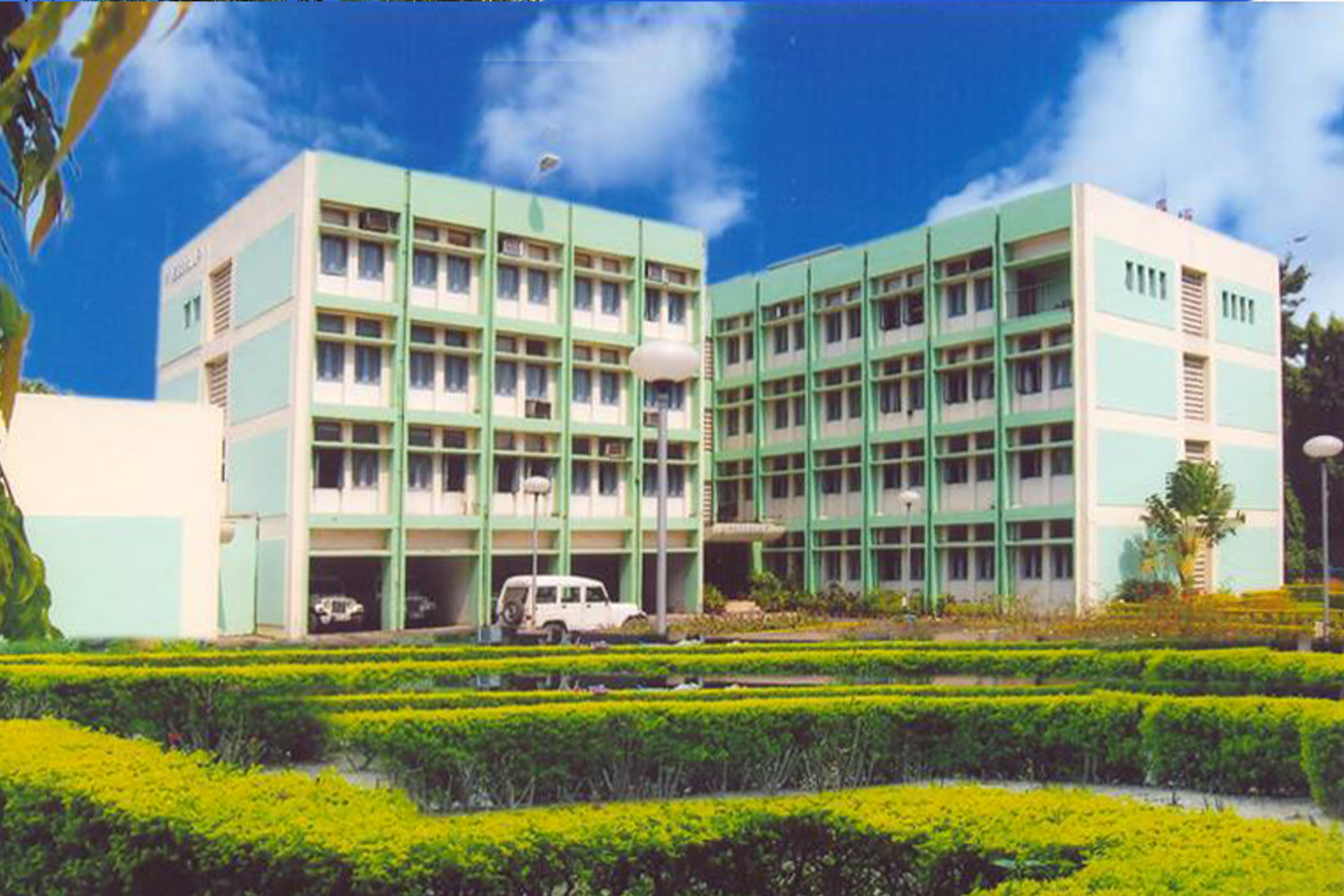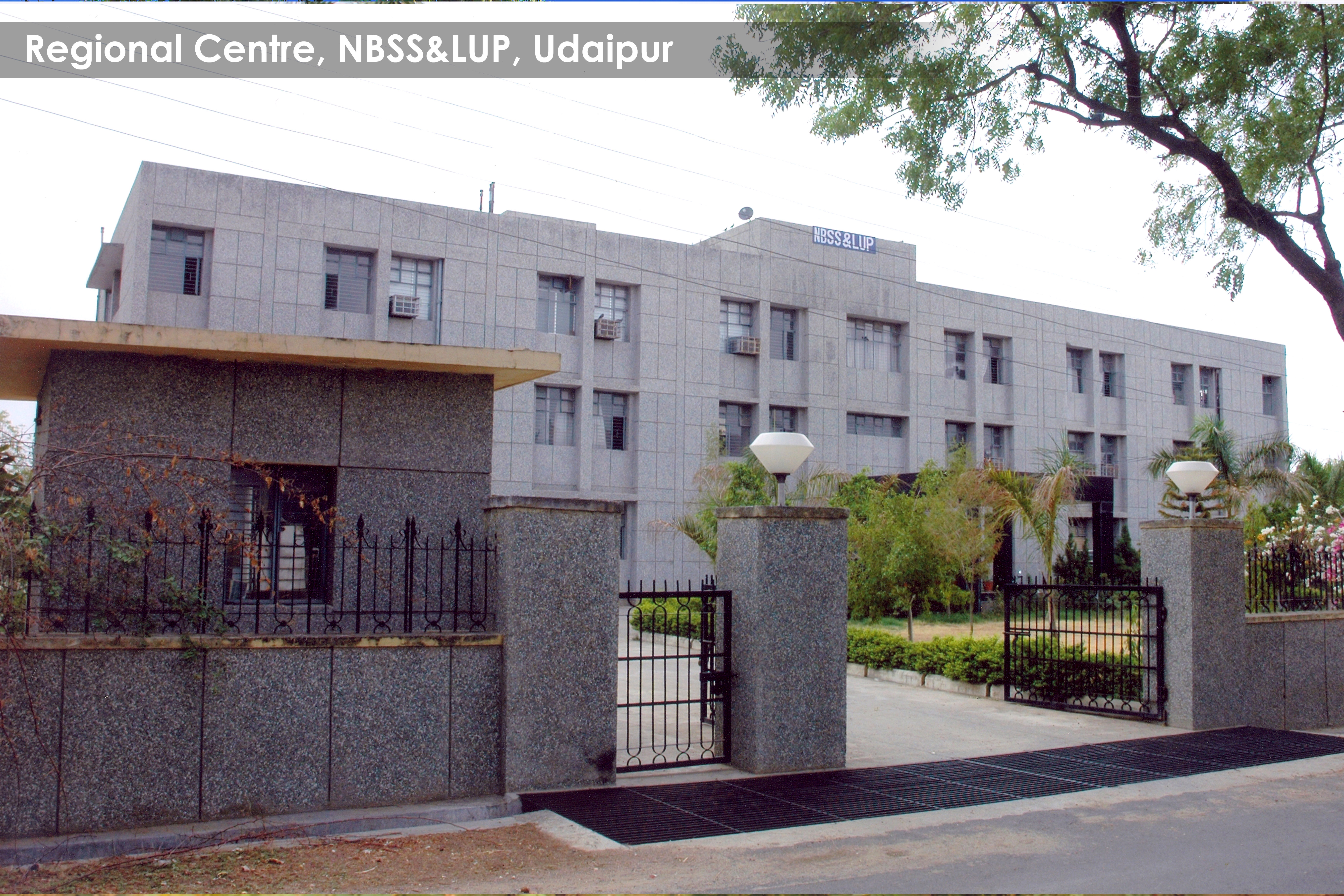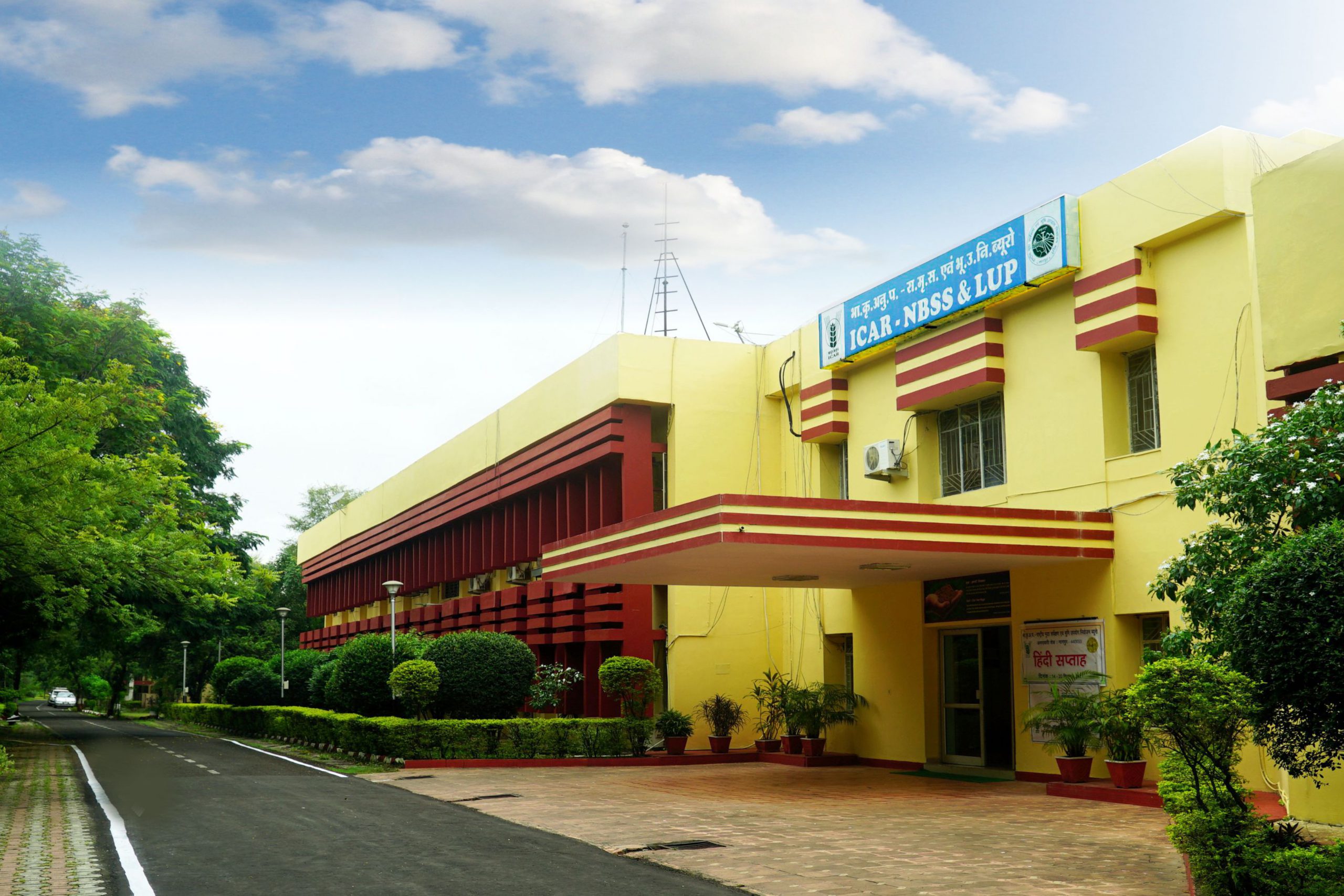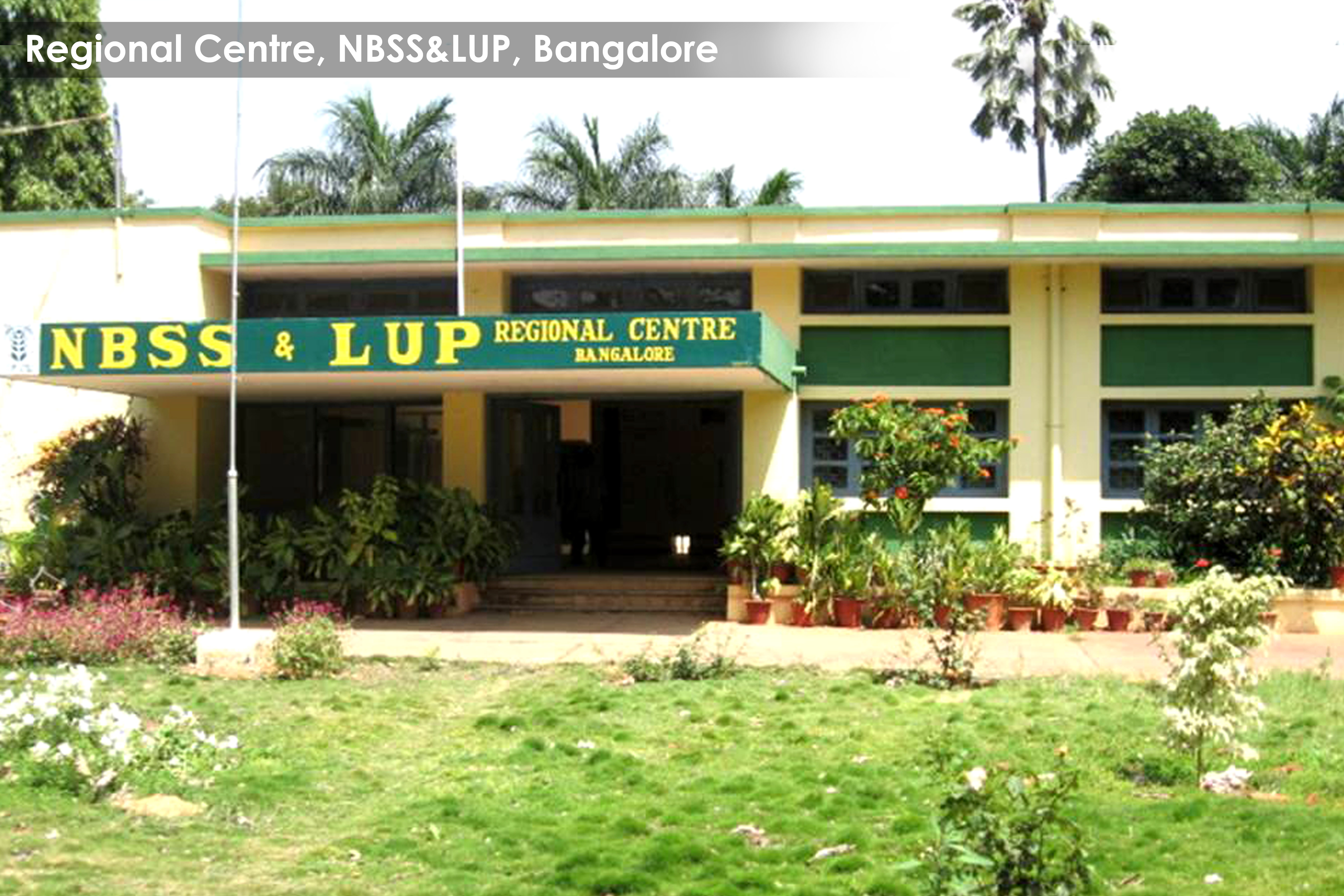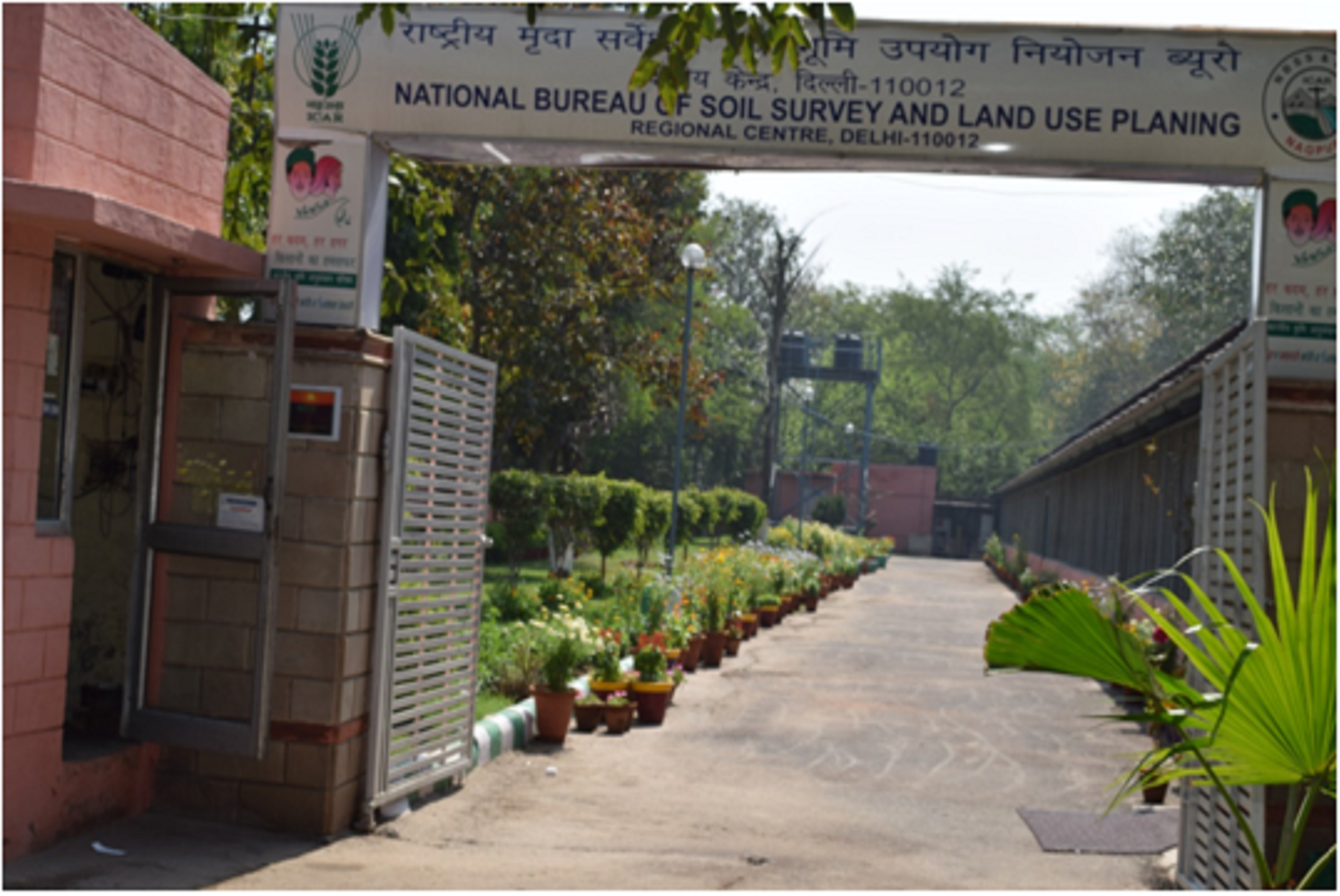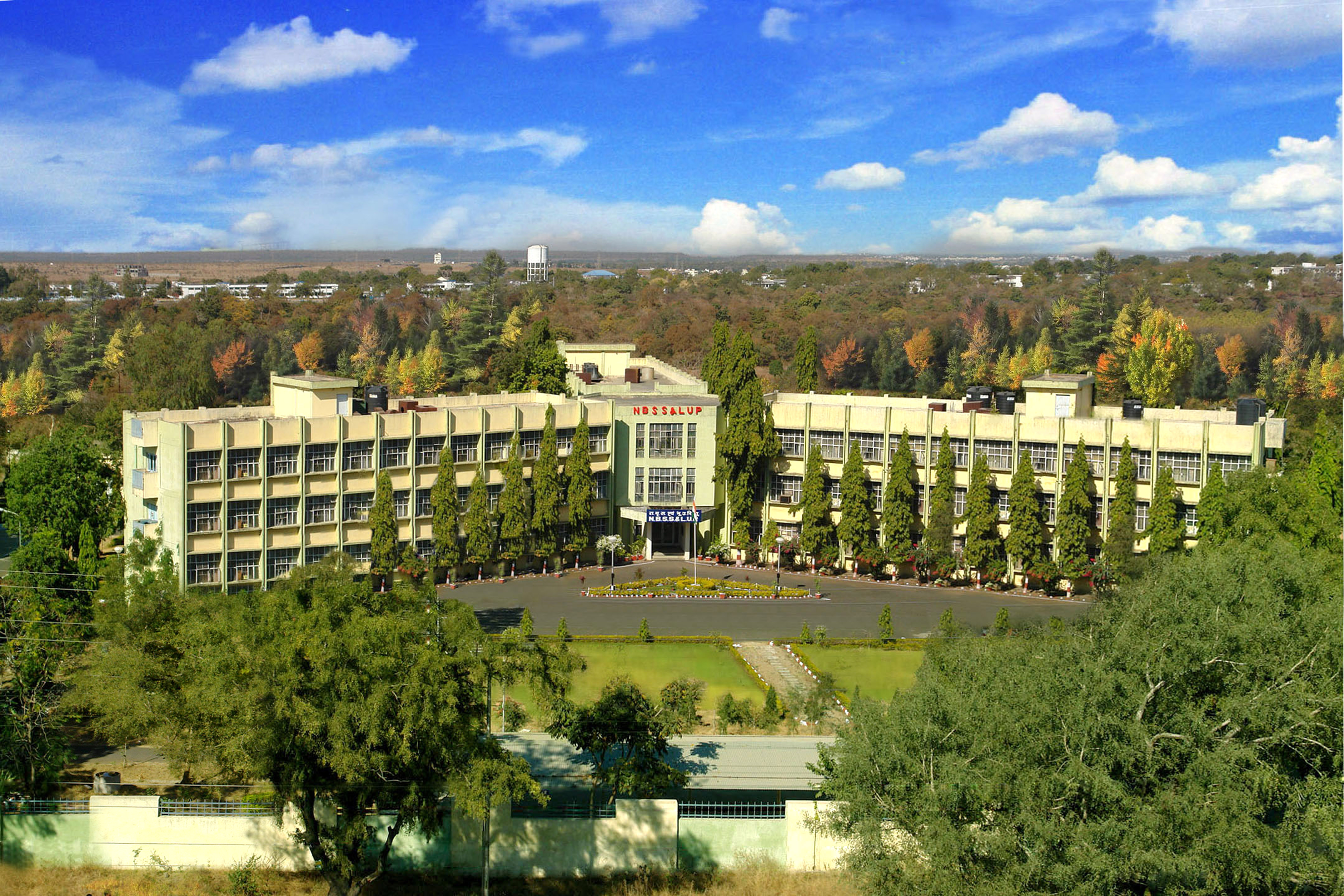About Division : Soil Resource Studies (SRS)
The Bureau initially had established five research divisions in 1980 at the Headquarters, Nagpur, namely Soil Correlation & Classification, Pedology, Remote Sensing & Aerial Photo Interpretation, Cartography and Land Use Planning. To avoid overlapping of the work and to bring staff of the relevant fields together as recommended by the Quinquennial Review Team (QRT) the five divisions were reorganized (1992) into three divisions, viz. Soil Resource Studies (SRS), Remote Sensing Applications (RSA) and Land Use Planning (LUP).
Division of Soil Resource Studies has the responsibilities for the research work in Pedology and other related fields.
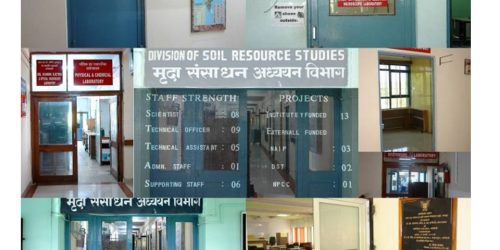
| Sr.No. | Name | Designation | Discipline | Biodata | PMS | |
|---|---|---|---|---|---|---|
| 1 | Dr. P. Tiwary | Principal Scientist & Head | SWCE | Pramod.Tiwary@icar.gov.in | View Biodata | PMS |
| 2 | Dr. U. K. Maurya | Principal Scientist | Soil Science | Uma.Maurya@icar.gov.in | View Biodata | PMS |
| 3 | Dr. K. Karthikeyan | Principal Scientist | Soil Science | K.Karthikeyan@icar.gov.in | View Biodata | PMS |
| 4 | Dr. D. Vasu | Senior Scientist | Soil Science | Vasu.N@icar.gov.in | View Biodata | PMS |
| 5 | Mr. Gopal Tiwari | Scientist | Soil Science | Gopal.Tiwari@icar.gov.in | View Biodata | PMS |
| 6 | Dr. Ranjan Paul | Scientist | Soil Science | Ranjan.Paul@icar.gov.in | View Biodata | PMS |
Infrastructure:
The Division has a moderate set up of basic and modern infrastructure of equipments to do research in the field of:
- Soil Micromorphology
It is difficult to conceive of detailed studies of soil genesis being carried out without the aid of micro-morphology. A number of different soil forming processes are usually typical of any one soil type, and the soil type that develops is generally a reflection of the interactions between these processes. Some of the processes may not be sufficiently advanced to be expressed macro-morphologically. Micro-morphology represents the surest way of identifying all the processes involved.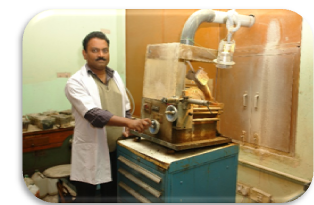
Micromorphology is the branch of soil science that is concerned with the description, interpretation and, to an increasing extent, the measurement of components, features and fabrics in soils at a micro- scopic level, i.e. beyond that which can readily be seen with the naked eye. It is fundamental to an understanding of the processes involved in soil formation whether they be produced by the normal forces of nature or artificially induced by the effect of man.
Soil micro-morphological unit was established in December 1981 under Indo-Dutch Collaborative Project with the following objectives:
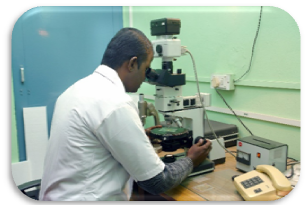
- To train the technical staff of the institute for micro-morphological analysis.
- Preparation, analysis and characterisation of 80 benchmark soils, inclusive of reporting.
- Training courses in soil micromorphology which is now continuing.
The various instruments available for the purpose in the Division are:
- Instruments for mounting and polishing of the samples.
- Petrographic research microscopes, Olympus BH-2 and Leitz Ortholux-II.POL-BK with mounted cameras and discussion tube for thin section studies and photomicrography.
- Scanning Electron Microscope (Philips SEM 515).
Soil Mineralogy
Scientists from many disciplines use this knowledge in fundamental and adaptive research on soil erosion, weathering, classification, fertility, physics, chemistry and biochemistry, as well as in engineering aspects of soils. A thorough knowledge and appreciation of the minerals in soils is, therefore, critical to our understanding and use of soils for the betterment of mankind while protecting our fragile environment. A critical use is the application of this knowledge to waste-related environmental problem including toxic waste clean-up and land fill sittings.
Minerals make up about 50 per cent of the volume of most soils. They provide physical support for plants and create the water and air filled pores that make plant growth possible. Mineral weathering releases plant nutrients that are retained by other minerals through adsorption; cation exchange and precipitation. Minerals are indications of the amount of weathering that has taken place and the presence or absence of particular minerals give clues as to how soil formed. The physical and chemical characteristics of soil minerals are important to consider in various aspects of land use planning.
The instrument available for the purpose is:
- X-ray diffraction unit (PANalytical X’Pert-ProXRD).
- Scanning Electron Microscope [FEI SEM Inspect S (D8858)].
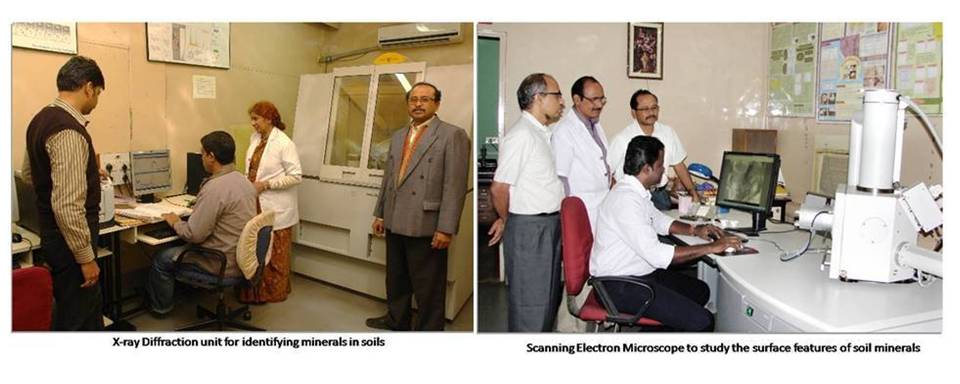
The Division has up-to-date setup for physical and chemical analyses pertaining to soils. Instruments are available for the analysis of physical and chemical properties.
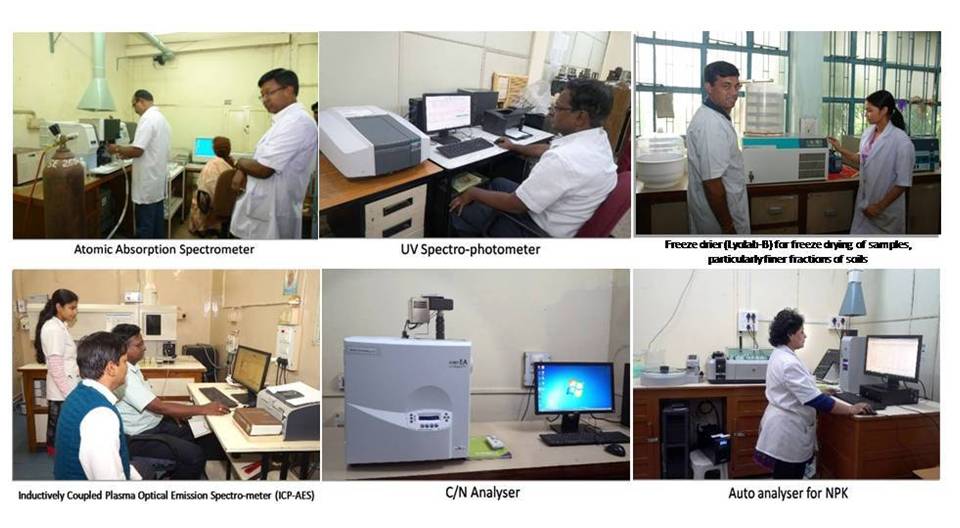 Recent developments in Argon plasma (ICP-AES) have made these attractive sources of excitation for emission spectrometry. These plasmas are highly stable, produces high temperature sufficient to even atomise the refractive materials, and is coupled with direct readers or scanning monochromators which makes it an excellent tool for simultaneous or sequential multi-element determinations. Carbon and nitrogen (C/N) analyser is an excellent facility to analyse the total C and N in soils and sediments and caters to the need of carbon related research at the Division.
Recent developments in Argon plasma (ICP-AES) have made these attractive sources of excitation for emission spectrometry. These plasmas are highly stable, produces high temperature sufficient to even atomise the refractive materials, and is coupled with direct readers or scanning monochromators which makes it an excellent tool for simultaneous or sequential multi-element determinations. Carbon and nitrogen (C/N) analyser is an excellent facility to analyse the total C and N in soils and sediments and caters to the need of carbon related research at the Division.
2.Soil Correlation Activity
Soil correlation has been an important mandate of the Division since its inception. It has been taken up in a big way since the last three years to correlate the major benchmark soil series of the country and enter it into the National Register for Soil Series.
Computerised Bibliographic Database
The Division has developed a computerised, updated reference files for major soils of the world on the recent development in pedological research.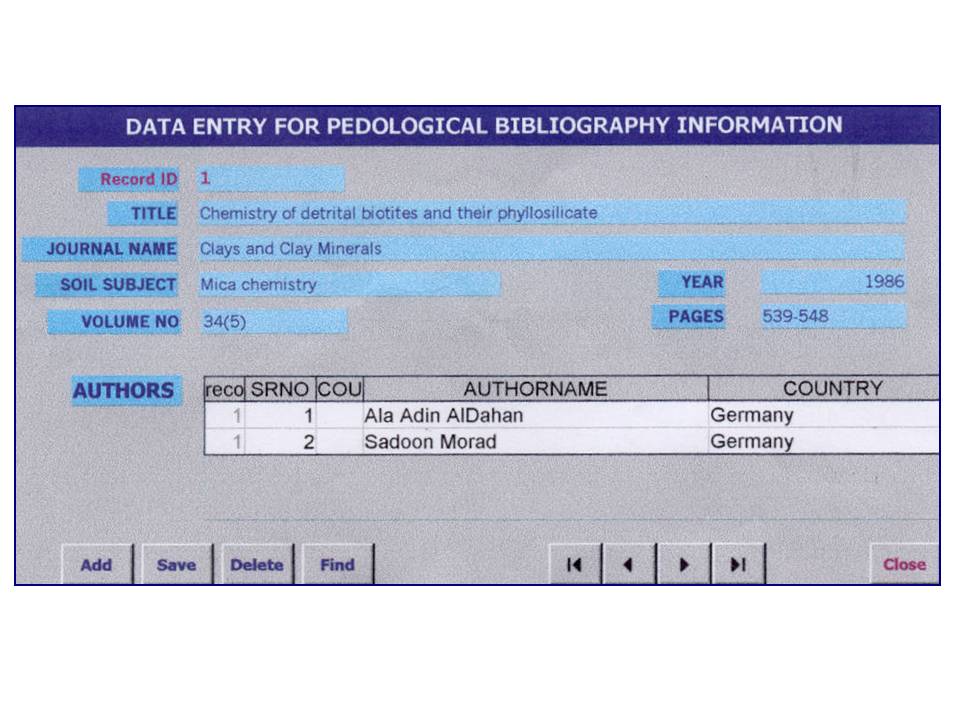
Achievements
The Division of Soil Resource Studies is engaged in conducting basic, strategic and applied research on pedology, pedogeomorphology, mineralogy, micromorphology, edaphology, etc. of benchmark and associated soils for understanding their genesis.
Institute Projects:
Pedogeomorphic study to infer the role of neotectonics and paleo-climate in the evolution and distribution of soils in the Purna valley, Maharashtra.
The Mathematical Equation to Calculate Linear distance of cyclic horizons in Vertisols has been developed. It is an improvised, but useful, method to identify locations of microdepressions and microknolls required for better management of Vertisols.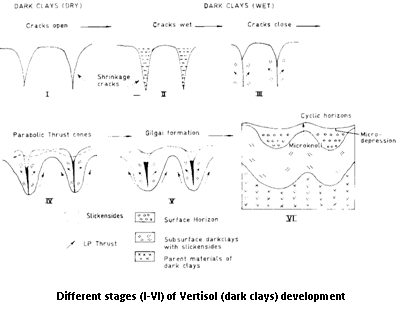
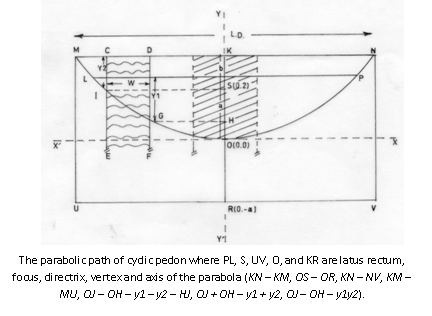
The parabolic path of cyclic pedon where PL, S, UV, O, and KR are latus rectum, focus, directrix, vertex and axis of the parabola (KN – KM, OS – OR, KN – NV, KM – MU, OJ – OH – y1 – y2 – HJ, OJ + OH – y1 + y2, OJ – OH – y1y2).
and for their precise classification.
The morphological (both macro and micro), physical and chemical differences between the Vertisols of the northeastern and southwestern parts of the Purna Valley in Maharashtra suggest that a decrease in rainfall and increase in temperature can modify important properties of soils in adjoining districts within an ustic soil moisture regime. Pedogenic carbonate, subsoil sodicity, poor plasma separation and deepening of cracks through the slickenside horizons are interpreted as indicators of polygenesis in Vertisols of this region and also in others with similar climatic condition.
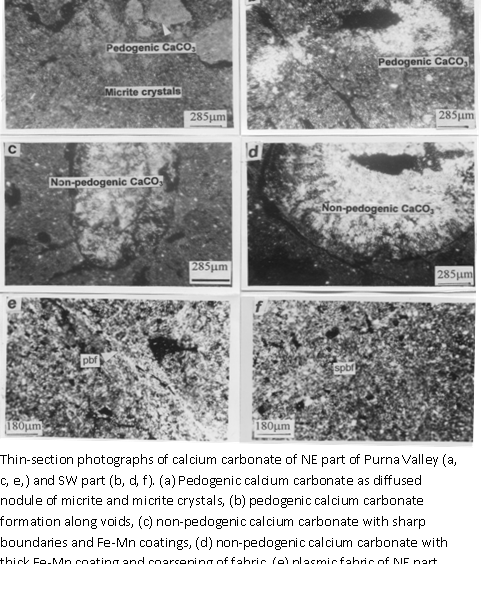
- Sodicity in Vertisols of the Purna valley is attributed to depletion of calcium ions as calcium carbonate, resulting in an increase of both SAR and ESP with pedon depth. This chemical degradation, appear to be a basic process in addition to those already described as natural processes of soil degradation. Recent study indicates that quality of irrigation water is also deteriorating hydraulic conductivity of soils.
- Due to huge amounts of smectite, Vertisols have severe use limitations even at ESP 5. Thus ESP 5 should be used as the lower limit for sodic subgroups of Vertisols, rather than ESP 15.
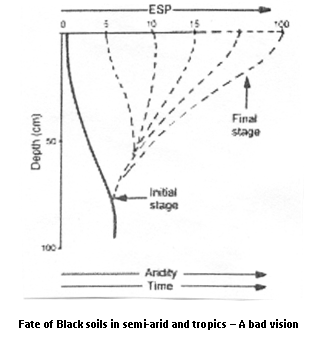
- The formation of pedogenic CaCO3 is also a basic process for the development of sodicity, suggesting that all sodic soils are calcareous, but all calcareous soils may not be sodic. This fact needs to be recognised as a natural process of soil degradation.
Nutrient reserve and release behaviour in Benchmark soils
- In an alkaline environment K release from biotite and muscovite occurs through Na-K exchange reactions and dissolution of structural unit, respectively.
- In presence of biotite that supplies most of soil K in alluvial (Alfisols, Inceptisols), black (Vertisols and their intergrades) and red (Alfisols) soils, muscovite is a useless K reserve. Relative abundance of biotite and muscovite will, therefore, explain the anomalous crop response to K fertilisers.
- Crop response to K-fertilizers will depend on the biotite reserves in various soil-size fractions. A selective quantification of biotite mica in the common situation in soils containing mixtures of biotite and muscovite could be an effective tool to determine the status of K stock in soils. This information could be used to decide the K-fertilizer requirement in various soils in many parts of India and elsewhere and will also help in making projections for K-fertilizer production in the future.
- Potassium adsorption in Vertisols is due to the presence of vermiculite and not due to smectite.
Micromorphological characterisation of selected Vertisols and associated soils in relation to their genesis.
- Shrink-swell soils of sub-humid region have strong plasmic fabric, whereas soils of arid regions show weak plasma separation due to hydroxy-interlayering of smectite.
- Micromorphological studies indicated that the irrigation through sewage water increased the porosity of the soil, while the suspended organic matter formed a coating around the soil particles and along the walls of the pores.
- Micromorphological study indicates Vertisols to contain both pedogenic calcium carbonate (PC) and non-pedogenic calcium carbonate (NPC) irrespective of the ecosystems they belonged. The NPCs are part of the parent material of Vertisols. Dissolution of NPCs and recrystallization of dissolved Ca2+ ions are responsible for the formation of PCs. Vertisols of arid and semi-arid climates contain more amount of PC in their soil control section as compared to those for sub-humid climate. Formation of PC is the prime chemical reaction responsible for rise in pH, decrease in Ca/Mg ratio of exchange site with depth and development of subsoil sodicity.
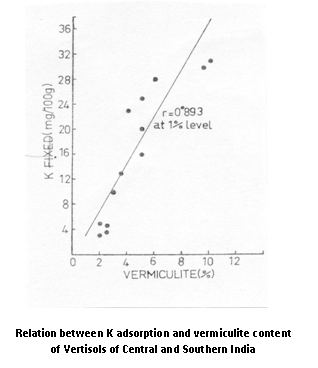
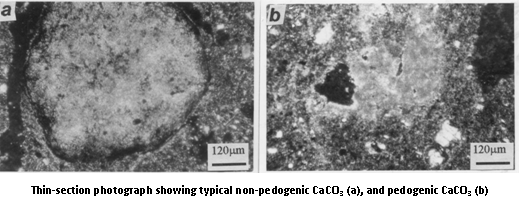
Micromorphological characterisation of ferruginous soils
- Thin section studies of ferruginous soils of southern peninsular India indicate the argillans not due to the process of illuviation but as a product of biotite weathering in situ.
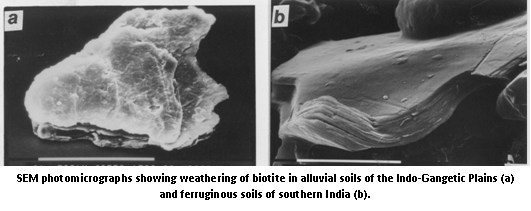
- Enormous faunal activity to a greater depth was observed in highly weathered ferruginous soils leading to high porosity of the soil. Their activity influenced continuity of the macropores to a great extent.
- Highly weathered ferruginous soils from Bangalore plateau, Karnataka showed dominance of microlaminated textural pedofeatures (ferriargillans), matrix of unsorted clay pedofeatures (matrans) and fragments of clay pedofeatures embeded in soil matrix (papules) upto 150 cm depth. Below 150 cm impure clay pedofeatures, limpid clay pedofeatures (argillans) and fragments of clay pedofeatures were embedded in the matrix. Presence of ferriargillans in the surface indicated removal of surface horizon through erosion.
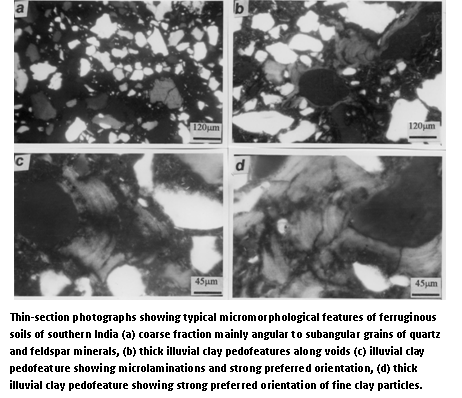
Clay mineralogy of soils of soil resource mapping project.
- Preferential downward movement of weathered products of biotite (di and trioctahedral expanding minerals) resulting in decreasing trend of clay mica in alluvial soils is a sure test of clay illuviation even when clay skins are absent.
- Clay illuviation in sodic soils of the Indo-Gangetic plains has not always resulted clay skins or, where present, in pure void argillans. Instead “impure clay pedofeatures” is typical in these soils because of impairment of parallel orientation of clay platelets, a specific process different from those described so far for genesis of less oriented void argillans.
- In the northwestern part of the IGP, non-sodic and moderately sodic soils occur on microhigh and highly sodic soils occur on microlow positions. This has been shown to be due to the role of neotectonics in the formation of these soils as evidenced by disrupted clay pedofeatures.
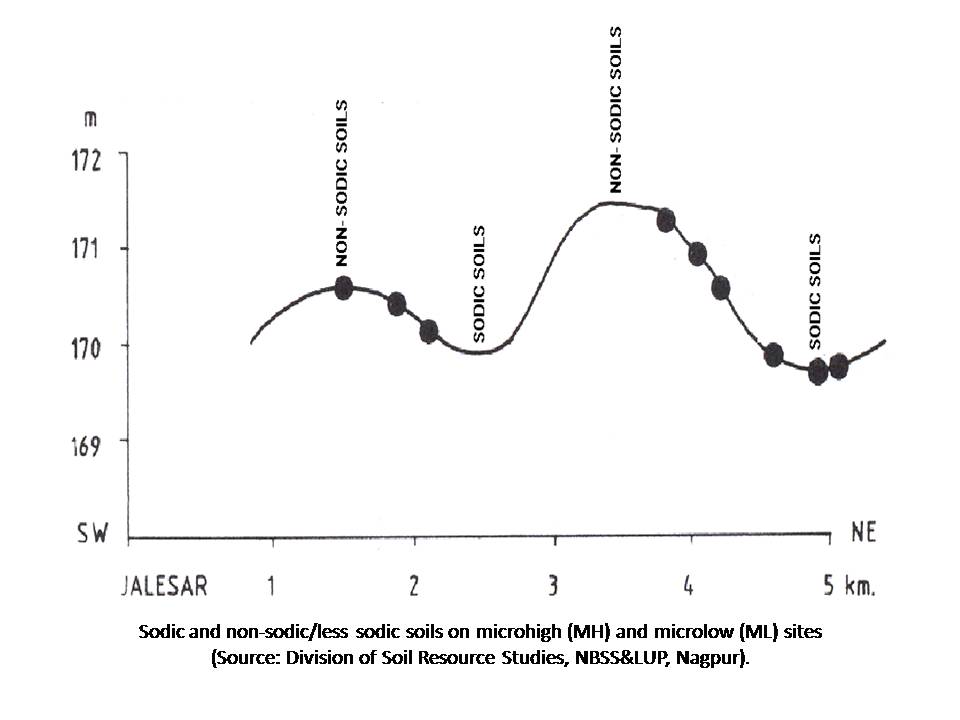
- Formation of Vertisols reflect a positive entropy change because weathering of primary minerals contributes very little towards the formation of smectites. It has been shown that the huge amount of smectites were formed in an earlier humid climate and preserved in the non-leaching environment of arid and semi-arid climates.
Genesis and transformation of clay minerals: their significance in pedology, paleopedology and edaphology.
- The formation of closely associated red and black soils of semi-arid and humid regions can only be explained through a progressive landscape reduction process from the studies of genesis and transformation of smectite and kaolin.
- The first weathering product of basalt is smectite (nearer to montmorillonite of montmorillonite-nontronite series) which constitutes dominant mineral of Vertisols formed due to its mechanical deposition in an earlier humid climate.
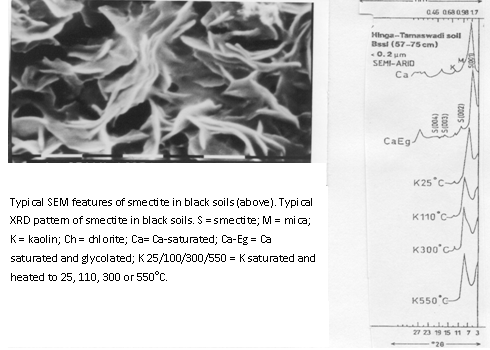
- Base-rich zeolites prevented the complete transformation of smectite to kaolinite and thus preserved the black soils in tropical humid climate of western India.
- The formation and persistence of ferruginous Alfisols on the Western Ghats for millions of years provide an unique example that in an open system such as soil, the existence of a steady state appears to be a more meaningful concept than equilibrium in a rigorous thermodynamic sense. The knowledge gained on the role of zeolites in the persistence of Alfisols not only provides a deductive check on the inductive reasoning on the formation of soil in humid tropical climate but also indicates the role of these minerals in preventing loss of soil productivity even in an intense leaching environment.
- It is apprehended that the ferruginous soils of the Western Ghats may be transformed with time into a typical poor-base-skeletal soils and shall fail to sustain the spectacular diverse flora and fauna of the Western Ghats. To preserve these invaluable natural endowment, mining of zeolites of the semi-arid part of the Ghats and their addition appears to be a very viable proposition to sustain the biodiversity of the Western Ghats.
- Gibbsite in acidic Ultisols is the remnant of earlier weathering products of alumino-silicate minerals formed in a neutral to alkaline pedo-chemical environment. The mere presence of gibbsite, therefore, does not indicate their advanced stage of weathering.
- In order to highlight the inherent relationship between vertic properties and the swelling minerals, the mineralogy class for shrink-swell soils in U.S. Soil Taxonomy should be only smectitic.
- Despite the fact that shrink-swell properties of soils can only be a function of swelling mineral (smectite) content, there is a provision for truly kaolinitic mineralogy class in Soil Taxonomy (1994) which stands for revision.
- The importance of phyllosilicates has been immensely appreciated while making an attempt to find out the minimum threshold value of smectite for the shrink-swell phenomenon of the black soils. Cutting across various representative soil samples of the country, the study shows that a minimum of 20% expansible mineral like smectite could cause shrinkage and swelling of soils which can be recognised in the field.
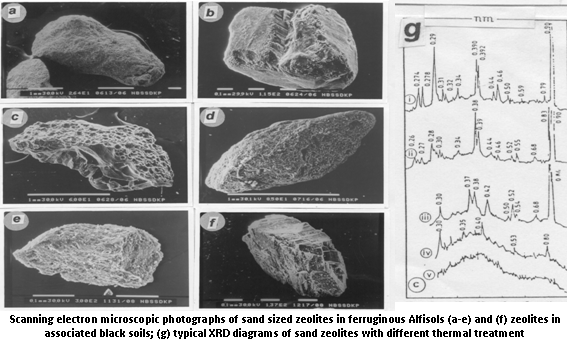
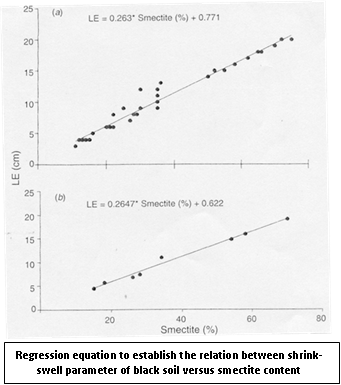
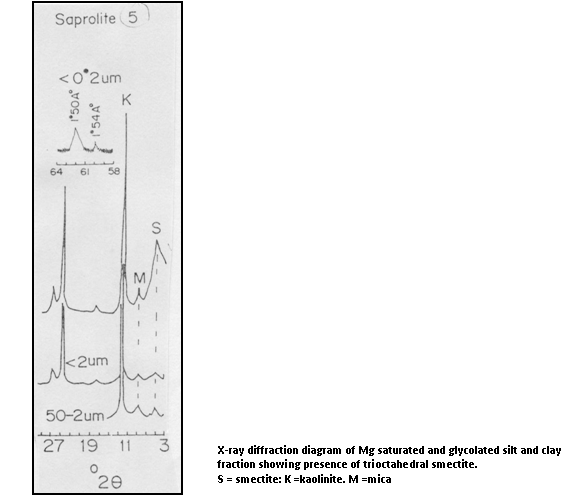
- Despite the fact that layer silicates at a less advanced stage of weathering may lose their interpretative value, the formation of di- and trioctahedral smectite in ferruginous soils of central and southern India can be regarded as potential indicators of paleoclimatic change.
- Micromorphological studies of lithomarge clays overlying a complex zone of micaceous sandstones and basalts in Bramhapuri, Maharashtra showed characteristic association of kaolinites and pedogenic carbonates indicating the influence of paleo-climate and environmental factors in their formation.
- Ferruginous soils dominated either by dioctahedral smectite or kaolin, are relict paleosols and have been affected by the later climatic change as evidenced by the formation of trioctahedral smectite from biotite and thus qualify to be polygenetic soils. This mineral make-up is common in major soils (alluvial, black and ferruginous soils) of the country suggesting polygenesis seems to be a rule rather than exception in soils of India.
- The persistence of Mollisols in the humid tropical environment has been possible due to the continuous supply of bases from zeolites of amygdoloidal basalt.
Total carbon stock in Indian Soils
- Estimation of SOC stock on the basis of soil orders and bioclimatic zones indicates the majority of the soils area (>50%) are deficient (<1%) in SOC content. The soils of arid and semi-arid climates are the most deficient in organic carbon but rich in inorganic carbon (CaCO3), indicating the natural degradation process caused by the adversity of arid climates. Proper rehabilitation of these soils can restore the productivity and also help in building up and sequestration of organic carbon.
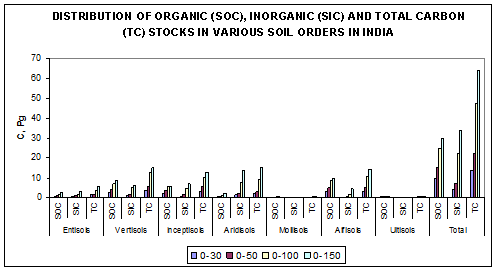
- To sustain the quality and productivity of soils, the knowledge of OC in terms of its amount and quality in soils is essential. This has more relevance soils of the tropical and the subtropical parts of the globe including the Indian sub-continent. SOC stock appears to be a single parameter that can help effectively in prioritizing the area for restoring soil health.
- To mitigate the effect of atmospheric carbon dioxide, carbon capture and storage by soils which acts both as a source and sink for this gas is an important tool and can also help to prioritize areas for carbon sequestration.
- The Century and RothC carbon models were evaluated for the selected BM spots (represented by LTFE sites) in the Indo-Gangetic Plains (IGP) and the Black Soil Region (BSR) of India. The Century and RothC could simulate changes in total organic carbon (TOC) for the surface soil in various treatments of the LTFE sites representing different bio-climates.
- The evaluation results indicate that the Century model was more successful when applied to the soils of sub-humid climate, for example, in Mohanpur than those in drier climate represented by soils with high amount of cracking clay while RothC works in both humid and semi-arid bioclimatic systems.
- The simulation results of RothC and Century indicated that there was significant increase in TOC for the treatment having application of organic manure alone or in combination with inorganic fertilizer. RothC model showed that there was continuous non-significant decrease in TOC in control and NPK treatments. However, in Century model there was marginal increase in TOC in various levels of NPK treatments due to better root growth and more plant residues after harvest of crop. Similar trends were also found in LTFE datasets.
Determination of layer charge of 2:1 layer silicate minerals in soils of India
- Hydroxy-interlayering in the interlayers of smectites of Peninsular India can be effectively removed by a method involving 0.25 N EDTA solution (pH 7.0).
- Removal of hydroxy-interlayering from soil clay smectites enables the determination of their actual layer charge by alkylammonium method.
- The layer charge of Vertisols of Peninsular India is in general, low, but increases with increasing amounts of the beidellite/nontronite species and the content of vermiculite.
- The layer charge of shrink-swell soils indicates deficiency/sufficiency of potassium for crop nutrition and its management.
Modelling soil forming processes and genesis of red and black soils in Peninsular India
Effect of climate and land use change on soil pH and soil organic carbon for coastal soils (South Gujarat) was modelled using soil data of two time periods (1990 and 2018) and 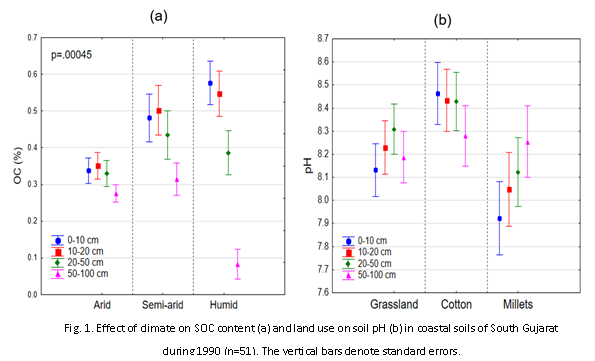
- Effect of climate and land use change on soil pH and soil organic carbon for coastal soils (South Gujarat) was modelled using soil data of two time periods (1990 and 2018) and the contributory effect of climate, soil and land related predictors was estimated using random forest (RF) regression. The results indicated that, during 1990, climate dominantly influenced SOC but significantly upto 20 cm depth only. Climate and land use interaction was marginally significant at p<0.1 for 0-10 cm depth (Fig. 1a). SOC decreased with depth under all the three climates in the order of Humid>Semi-arid>Arid. SOC content was marginally higher in the 10-20 cm layer than 0-10 cm due to sandy surface soils characteristic of coastal arid and semi-arid regions. Climate had weak effect on soil pH while land use and climate interaction significantly controlled the pH for 0-100 cm depth (Fig. 1b). Soil pH generally increased with depth. The soils under cotton had higher pH whereas soils under grassland and millets had similar pH range. PET, soil type and clay were strong predictors of soil pH for the topsoil. pH of deep soils was controlled by the interaction of climate with soil properties.
- Land use change after 1990 resulted in an increased area under commercial fruit plantations, cotton, rice, and sugarcane in South Gujarat. The change in land use affected SOC content in all the soil depth intervals. However, the effect of climate was significant in the topsoil (0-20 cm) and for 0-100 cm depth. The climate and land use interaction was marginally significant at p <0.1 for 0-100 cm depth. SOC decreased with depth in all the climate with soils of humid climate having higher SOC than semi-arid (dry) and semi-arid (moist) climates. SOC content was highest in soils under plantation and lowest in soils under cotton whereas soils under sugarcane, rice and grassland have similar SOC content upto 50 cm.
- The relationship of SOC with mean annual rainfall and potential evapotranspiration was highly significant (P<0.00001) for all the depth intervals, contracting the linear ANOVA model results. Moreover, RF regression results indicated that, during 2018, SOC was controlled by both climate (MAR and PET) and land use (Fig. 2). It was found that soil pH also played a major role in controlling SOC content whereas clay, CEC and soil type were weak predictors. Similar to the results of 1990, climate influenced soil pH only in the topsoil (0-20 cm) during 2018. Soil pH increased with depth under all the three climates and pH under SA(d) climate was slightly higher than SA(m). Soils under humid climate have pH 0.3 units lower than SA climate. Land use controlled soil pH at all the depth intervals (p<0.0001). Climate and land use interaction effect on soil pH was significant at the surface (0-10 cm) and subsurface upto 50cm (20-50 cm). Soil pH generally increased with depth
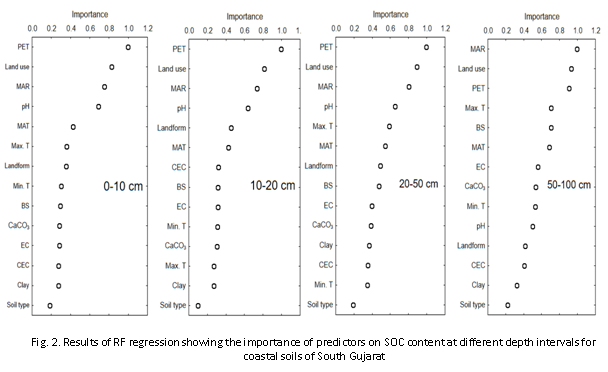
Land Resource Inventory (1:10000 scale) of Gujarat State: A step towards enhancing agricultural productivity and transfer of technology – 14 subprojects in Kutch, Bharuch, Valsad, Surat, and Navsari districts
- Soil survey was carried out covering 18 lakh ha area in the five districts viz, Bharuch, Surat, Navsari, Valsad, and Kutch (37 blocks) and 158 soil series were identified.
- In the south Gujarat, the soil depth varied from shallow to very deep as they occur in different landforms such as plateau tops, pediments, coastal plains and river valleys in Bharuch, Valia and Hansot talukas of Bharuch dist. Their colour varied from reddish brown to grey and subsoils are calcareous in nature.
- The soils of central part (Surat and Navsari districts) were deep to very deep, clay loam to clay in texture. They were slightly saline in surface and subsurface sodicity is caused by poor groundwater in coastal regions. They are generally deposits of basaltic flow from Narmada, Tapi and Dhadhar rivers. Their depth is proportional to fluid current and size of the rivers.
- The soils of the southern part (Valsad district) were deep to very deep, grey and yellowish brown, calcareous soils are common in southern tip Pardi, Umargaon & Vapi of Valsad District.
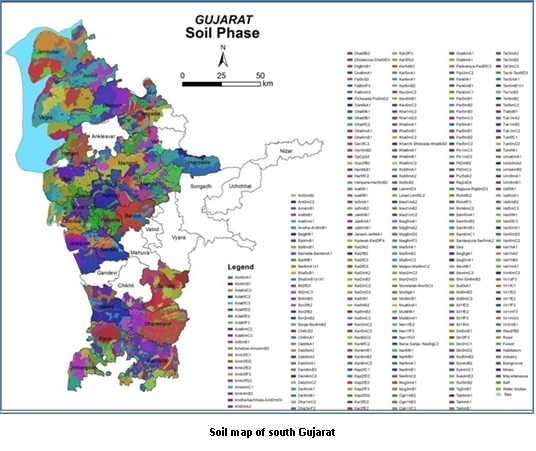
Land resource inventory of Kachcha district, Gujarat on 1:10000 scale using geo-spatial techniques
Kachchh district is the largest district in Gujarat with an area of 4.5 lakh ha, and 50% of the area is covered by Rann and little rann of Kachchh (high saline unproductive desert). Soil survey was carried out in 2.23 lakh ha area covering 9 blocks of the Kachchh district. The area has Deccan trap basalt, brown ferruginous sandstone, kaolinitic shale, coastal alluvium and limestone are the major geology of the district. A total 77 soil series were identified in the district from coastal alluvial plains, alluvial plains, pediment plain, and rocky upland areas.
Land resource inventory of Junagarh district, Gujarat on 1:10000 scale using geo-spatial techniques
For Junagarh district, soil survey was done for 6 blocks, namely Mangrol, Manavadar, Maliya, Keshod, Mendarda and Vanthali covering 3,52,690 ha area. In all, 76 land ecological units (LEU) were delineated. 35 soil series with 100 soil phases were identified.
Land resource inventory of Dholka Taluka, Ahmadabad district, Gujarat on 1:10000 scale using geo-spatial techniques.
In Dholka block of Ahmedabad district, 11 soil series were identified. This block has major five physiographic units viz. i) Very gently sloping flood plain, ii) Very gently sloping alluvial plain, iii) Very gently sloping old alluvial plain, iv) Nearly level low lying coastal plain and v) Level to nearly level coastal plain. The soils were deep to very deep, coarse loamy (Vataman series) to fine loamy (Girand series) and fine (Dholi series) in texture. Analytical data indicated that all soils of Dholka block are strongly alkaline (pH 8.5 to 9.5), slight to moderately calcareous with high base saturation status. Organic carbon status of soils ranged from low to medium. Out of 11 series four soils were sodic (Dholi, Amliyara, Ganeshpur and Loliya1) and one belonged to saline sodic (Loliya2). Management of such soils needs immediate attention for sustainable land use.
Land Resource Inventory (1:10000 scale) and Impact Assessment of Canal Irrigation on the Arid Agro-ecosystem- A Case Study in five blocks of IGNP Command Area
Characterization and formation of Salt affected Soils in an Arid Agroecosystem
Soils of Rawatsar block of Hanumangarh district, Rajasthan has been inventorized on 1: 10,000 scale. This area falls under arid agro-climatic conditions and salt affected soils of common occurrence. The salt affected soils of IGNP command area are present in scattered form in between the sand dunes. Two soil series Mahela and Bherusari were identified and characterized. Mahela series belong to coarse loamy, gypsic (gypsum is >35% and gypsum + carbonate equivalent is >40%), hyperthermic, Calcic Petrogypsids and Bherusari series was classified as coarse loamy, mixed, hyperthermic, Sodic Haplocalcids. The soils of Mahela are non-saline and non-sodic with very thick cemented “Gypsic” layer (>115cm) after 35cm depth and is highly disturbed by mining activities. The soils of Bherusari were saline (EC 8-16 dSm-1), sodic (ESP 18-50) and gypsum was present in less than 5% in reduced lower layers (39-60cm depth) under waterlogged condition. The pH of Mahela series was below 8.2 whereas it was around 9.0 in all layers of Bherusari soils. Gypsiferous soils of Mahela were developed under hyper aridity due to evaporation and precipitation of gypsum mixed with limestone. The soils of Bherusari were partially gypsified by mass movement of ions followed by partial replacement of NaCl by CaSO4 and its precipitation and accumulation in the form of gypsum in the subsurface horizons. Both the soils are not fit for agriculture due to strong influence of mining and exposure of gypsum in Mahela series and high amount of secondary salts and partial gypsification under waterlogged condition in Bherusari series.

Land Resource Inventory (1:10000 scale) of Maharashtra State: A step towards enhancing agricultural productivity and transfer of technology – 6 subprojects in Wardha, Yavatmal, and Ahmednagar districts
Soil survey was carried out for 17 blocks covering total area of 14.03 lakh ha in Wardha, Yavatmal and Ahmednagar districts.
Land resource inventory of Bemetara block, Bemetara district, Chhattisgarh state (AESR 11) on 1:10000 scale using geo-spatial techniques.
- Under the national programme of land resource on 1:10000 scale, the resource soil survey of Bemetara block of Bemetara district, Chhattisgarh state was continued during the year. This block comes under AESR11 which represents moderately to gently sloping Chhattisgarh basin with a growing period 150-180 days. The major part of this block belongs to very gently sloping to gently sloping land. The block is intensively cultivated with double crop. The geological formation of the area is shale with sporadic occurrence of limestone and dolomite.Soils were correlated and identified 4 soil series in the major landforms for the northern part of the Block.
- The soils are all deep to very deep Vertisols with pH slightly to moderately alkaline. Dhadi soils have strongly alkaline subsurface layers. Generally, reaction increased with depth with highest value in the lowest layers. Surface soils have 0.60-0.99% organic carbon which decreases with depth. Calcium carbonate is low in these soils varying from 0.2 -2.0% with no distributional trend. The soils have low ESP and high Ca/Mg ratio indicating better soil drainage properties. However, the Mg in these soils is relatively high.
- The block is an agriculturally well-developed with tube well and canal irrigation throughout the surveyed area. Paddy, soybean /pigeon pea are the major Kharif crop of the area and Gram, Lentil and wheat are the rabi crops. Paddy is also cultivated in some area during Rabi where irrigation facility is available. Sugarcane is another important cash crop. The area is a rice bowl of Chhattisgarh with a production of 35-40 q/ha and the yield of gram varies from 5-6 q/ha. Due to excessive tube well irrigation the ground water is decreasing in some pockets. The irrigation for gram/ wheat is through sprinklers and white patches of salts were noticed in all fields.
Externally Funded Projects (National)
Georeferenced Soil Information System for Land Use Planning and Monitoring Soil and Land Quality for Agriculture
- Compilation of horizon wise database generation for the Black Soil region (BSR) and Indo-Gangetic Plains (IGP) in terms of the morphological, physical, chemical, and biological properties of 848 soil profiles.
- Characterization of BM spots (17 sites of BSR and 15 sites of IGP) for soil biological parameters (urease, dehydrogenase, bacteria, fungi and actinomycetes). Where temporal (1980, 2005, 2010) datasets on soils generated for monitoring soil and land quality.
- It is the first time in the history of Indian soil research, an effort was made through this NAIP project to study the depth-wise distribution and factors influencing the urease, dehydrogenase, microbial biomass carbon, and microbial activity and diversity in the soils of the selected benchmark spots.
- Generation of Pedotransfer Functions for the calculation of saturated hydraulic conductivity for the Indo Gangetic Plains (IGP) and Black Soil Region (BSR).
- Development of varietal coefficients for Bt cotton and validation of Bt cotton version of INFOCROP model. Yield gap analysis of BM spots of BSR and IGP for dominant crops. Drought related reduction in potential yield was identified as a useful land quality indicator for rainfed Vertisols and this can be estimated for cotton and soybean using the indigenous simulation model (INFOCROP).
- Soil and Terrain (SOTER) datasets were finalized for 144 soil series in the IGP and 101 soil series in the BSR. The information on morphological, physical and chemical properties of the soils and climate and land use were created and linked in SOTER-GIS environment for monitoring soil and land quality.
- Principal Component Analysis (PCA) technique was employed to identify the minimum soil parameters that can give interpretable information to explain the physical, chemical, and biological parameters. Two sets of data were considered for the Indo-Gangetic Plains, viz., the Upper IGP covering Rajasthan, Punjab, Haryana, Uttar Pradesh, Delhi and Uttarakhand and Lower IGP consisting of Bihar and West Bengal. Six Principal Components (PCs) were obtained for the Upper IGP (Hot Spots) and lower IGP surface soils and the minimum datasets (MDS) obtained were – clay, saturated hydraulic conductivity, organic carbon, exchangeable sodium percentage, exchangeable magnesium percentage, soil solution K. the MDS for the BSR were saturated hydraulic conductivity, ESP, EMP, BD, OC, pH, WDC and silt. The relative soil quality index computed for surface (0-30 cm) and subsurface (30-100 cm) soils of the selected hotspots (BM Spots. SQI maps were also developed for both the IGP and BSR.
- Proven conventional quantitative land evaluation approaches, namely, parametric, fuzzy modelling and soil property-crop response (SPCR) were used to evaluate the soils of the selected benchmark spots for rice-wheat cropping system in the IGP and cotton-based cropping system in BSR. Besides, crop simulation modelling was also used as a quantitative land evaluation method. Amongst all the land evaluation methods, the performance of fuzzy modelling was found to be satisfactory and thus, we could develop a robust approach of land evaluation based on fuzzy modelling that does not necessitate consideration of crop yield directly as indicator of land quality. Based on the new set of data for length of growing periods (LGP), quantitative drainage map and newly available soil data, the AESR boundaries have been revised for two important food production zones of India namely, the Indo-Gangetic plain (IGP) and the Black Soil Region (BSR). At the beginning of the project, there were 53 AESRs (17 in IGP and 36 in BSR) in the study areas, but after revision the number has been increased to 83 (29 in IGP and 54 in BSR).
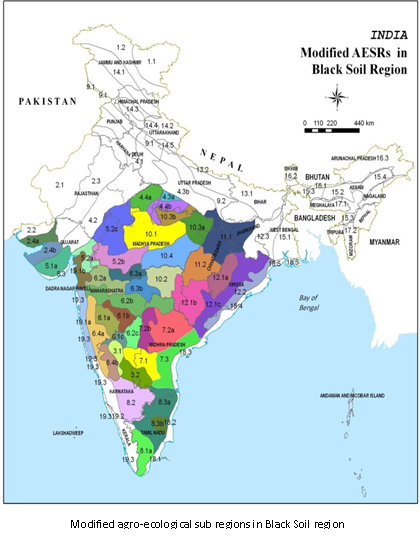 Influence of organic and inorganic carbon sequestration on soil and land quality in selected benchmark spots of India
Influence of organic and inorganic carbon sequestration on soil and land quality in selected benchmark spots of India - Bioclimatic-wise SOC, SIC and TC status were estimated for the selected soils of the country.
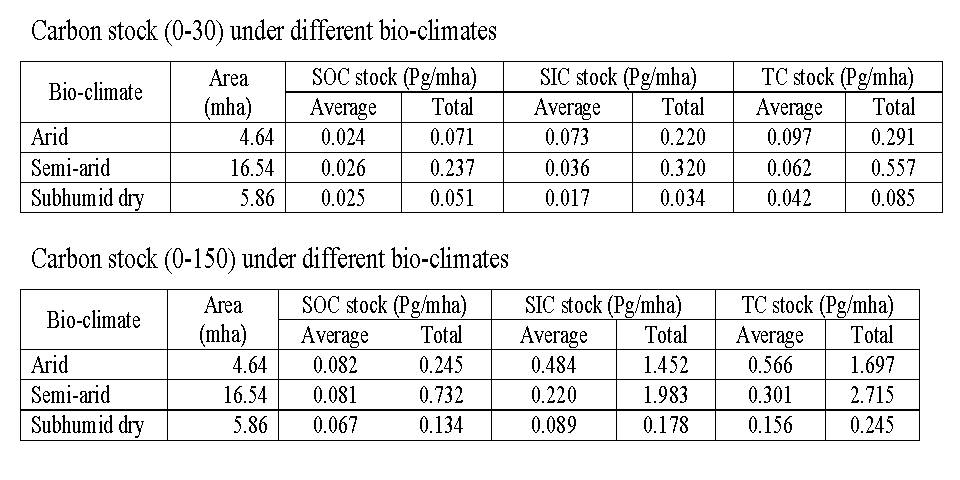
- The sequestration potential of inorganic carbon was determined from the temporal data of 1980, and 2010 in selected bench mark sites. In the semiarid regions wherein temporal data are available, 3 sites are under rice wheat system of Indo Gangetic Plains and two in black soil regions The data indicate that SIC stock in last 30 years has decreased in all sites except sarol wherein the SIC has increased (Table 18). At present the decrease is in the tune of 3 to 93% over the the period of 30 years. In Zarifa viran the inorganic carbon has decreased about 26 %where as in Sakit soils 3% decrease was observed. Highest decrease in carbon was noticed in Itwa soils. In sarol soil the inorganic carbon has increased to the tune of 73%. It has been reported earlier that better management practices decreased the inorganic carbon sequestration. Improved management practices with quality water might not have allowed more inorganic carbon development in these soils.
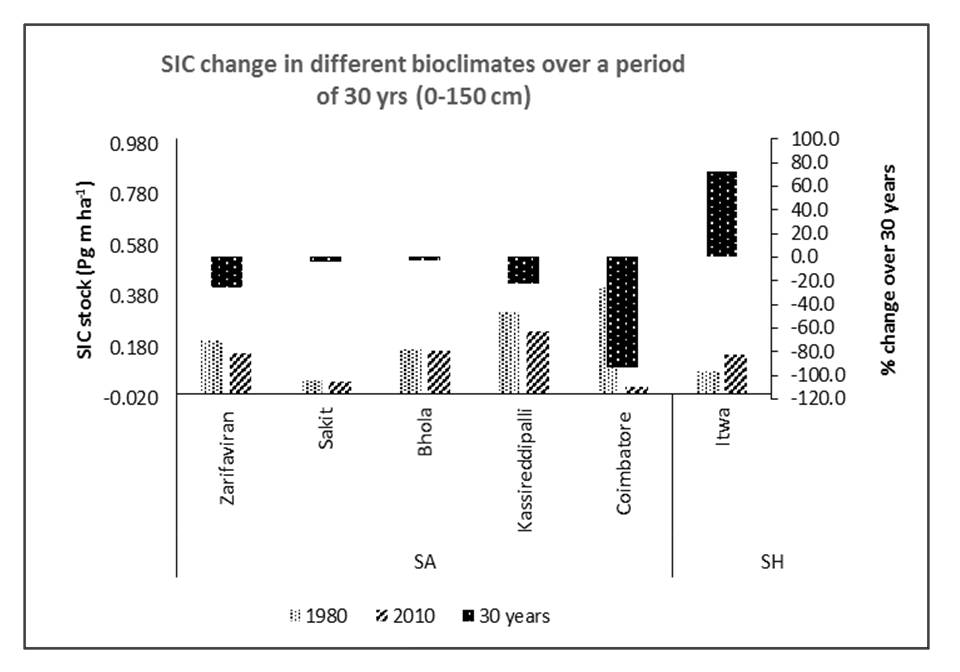
- Three soil carbon models namely RothC, Century and DNDC were evaluated using Long Term Fertilizer Experiment (LTFE) datasets for various sites. The performance in Akola sites of RothC model appears more promising than other two models in all the treatments with root mean square error (RMSE) values less than 10% of the mean measured value. Another statistical evaluation criterion i.e. t values of M were found to be non-significant at 5% significant in all the treatments except T14 (only FYM) treatment for DNDC model.
- The yields of major crops were also simulated using the Century, DNDC and InfoCrop models for selected sites and compared with the observed yields. The simulated yields were also compared with the SOC and SIC content using InfoCrop model. It was found that the performance of the DNDC model much better than the Century model for wheat crop. For sorghum crop, both the models could not perform satisfactorily. An agreement on more yield with higher SOC content was observed. A reverse trend was observed with the percentage SIC content.
- An indigenous model (SOLAQ) linking organic and inorganic soil carbon was developed. A submodule for assessing the soil quality was also developed.
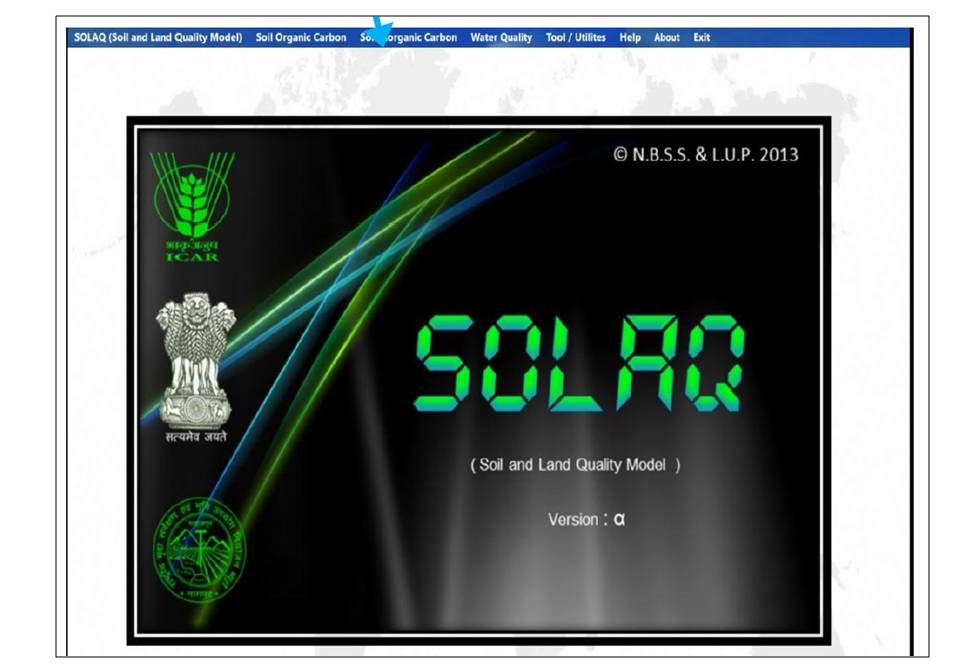
Generation and Modelling of Carbon Datasets in Different Agro-ecosystems for Climate Resilient Agricultural Planning (NICRA Project)
- Soil carbon stock (organic, inorganic and total carbon for 0-30 cm and 0-100 cm soil depths) was estimated for 36 benchmark spots representing various bio-climates of the Black Soil Region (BSR) and Indo-Gangetic Plains (IGP).
Revisited 11 benchmark sites and collected soil samples were analysed for physical and chemical properties including soil organic carbon (SOC). Very high SOC (5.1%) content was found in the soils of Kottayam soil series whereas high soil inorganic carbon content, in the form of CaCO3 (>15%), was found in Palathurai soils.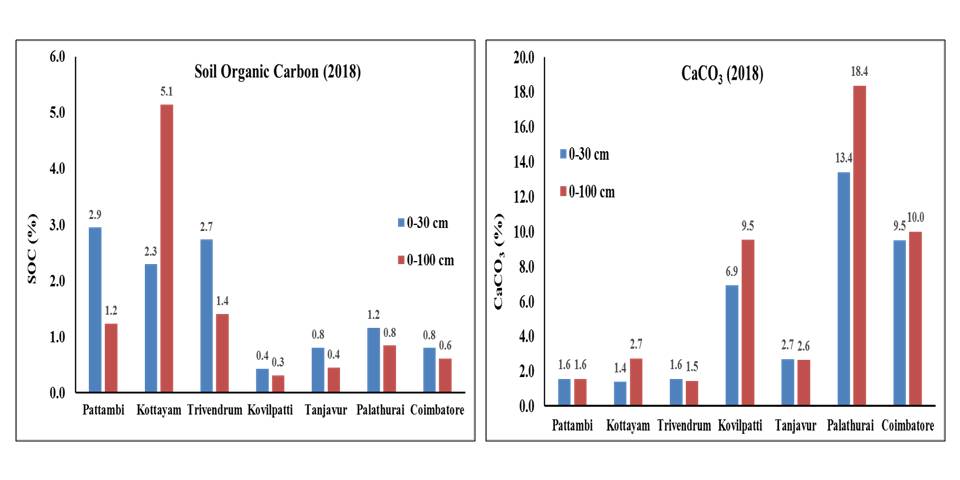
- Temporal changes of soil carbon (both organic and inorganic) were determined for 0-30 and 0-100 cm for 7 sites. Increase in SOC content for 0-30 cm soil depth, except in Kottayam series. Except soils of Jamakhandi and Kovilpatti series, there is increase in SOC content for 0-100 cm soil depth
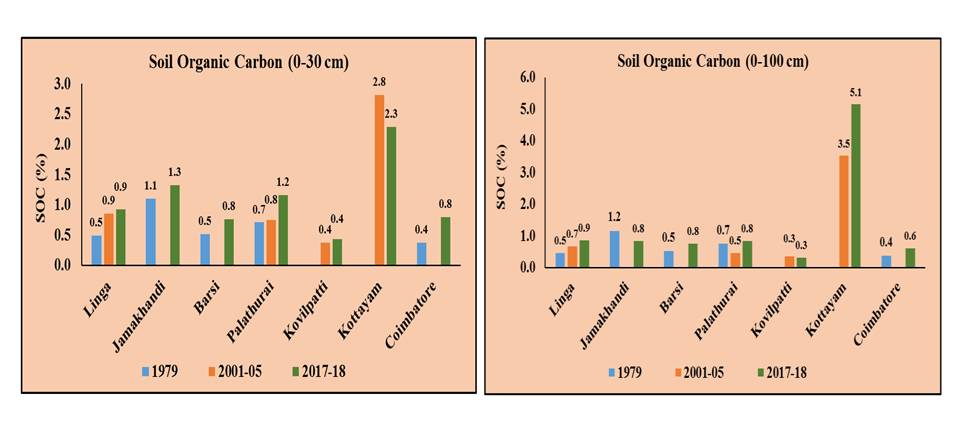
- Simulation of soil organic carbon for seven sites was completed using Century model. The simulation results indicate that in the majority of LTFEs, the NPK+ FYM treatment showed significant increase in SOC turnover and is maintained at higher RCP scenarios. Thus, NPK+FYM treatment is one of SOC enhance strategies.
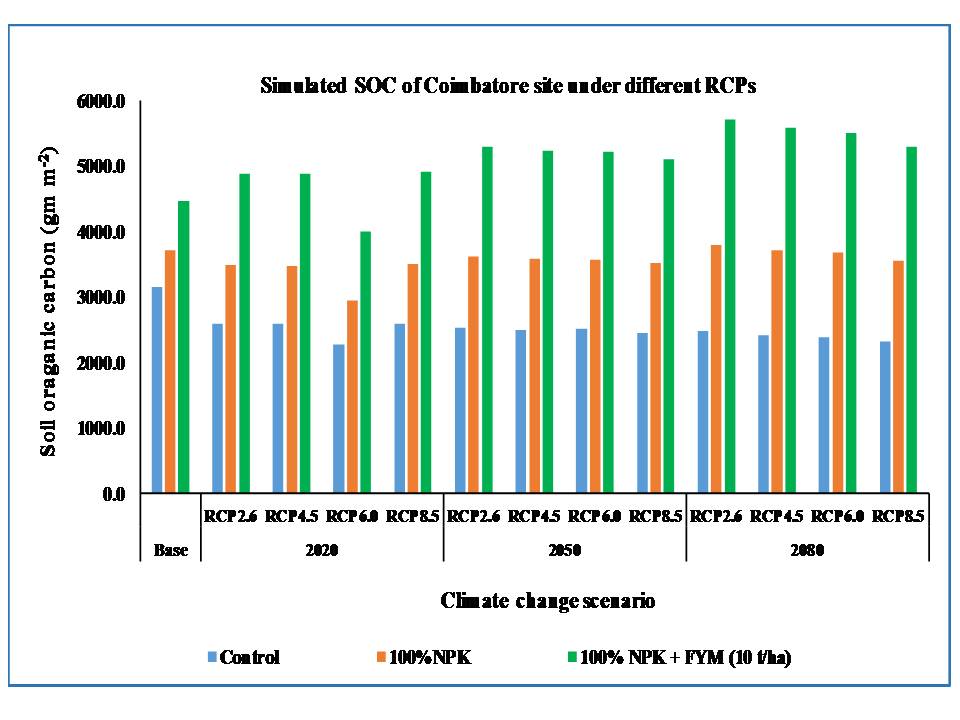
- Collection and compilation of datasets on soils, climate and land use have been completed for 126 sites and has been released as a bulletin.
Soil Quality Assessment and Developing Indices for Major Soil and Production Regions of India AESR 6.1 and 18.4)
Soil sampling of 188 grid points, at an interval of 20 km, from AESR 6.1 covering the state of Maharashtra and Karnataka were collected for surface (0-15 cm) horizons. AESR 6.1 is dominated by sugarcane and cotton-based cropping system and 340 soil samples were collected. This includes one each large and small farmer at each grid point.
In AESR 18.4 which covers Utkal Plain and East Godavari delta, hot dry subhumid eco-subregion, 77 grid points were demarcated. In this rice based cropping system 85 soil samples were collected from 54 grid points at 20 km interval for laboratory analysis. Apart from the soil samples management information for all the sampled locations were collected from the farmers (Fig. 21).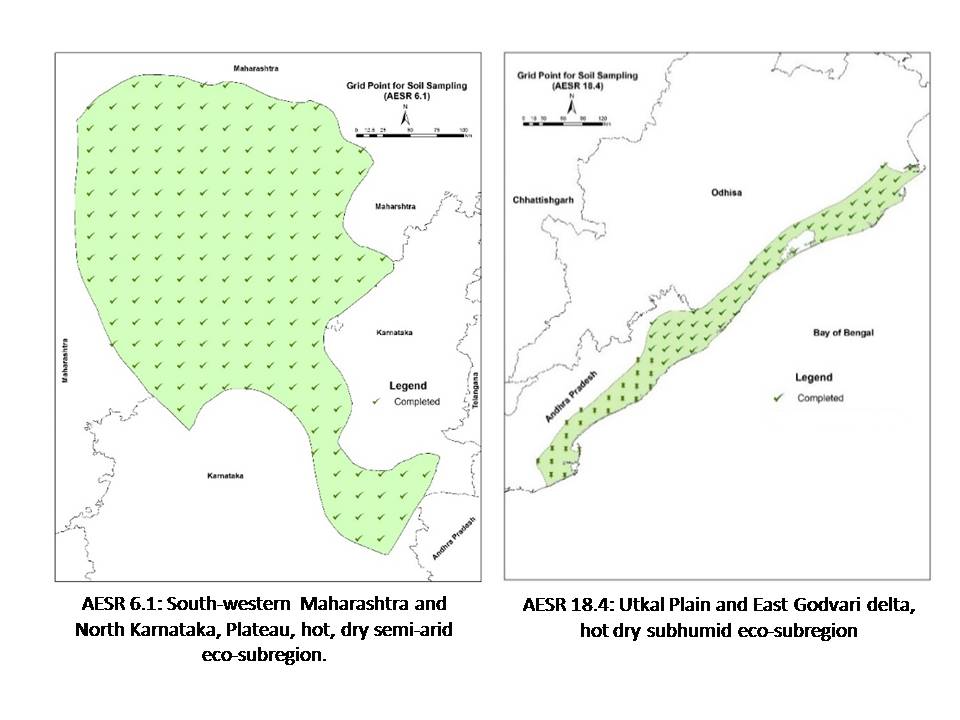
The soils of AESR 6.1 are moderately to strongly alkaline (85%) alkaline in reaction with pH ranges from 6.9 to 9.2 with EC <1 dS m-1. If we consider 0.75% organic carbon as high, more than half of the samples are high in Organic carbon and about 21 per cent of the samples are in the range of 0.5 to 0.75 per cent. In about 23 per cent surface soils the organic carbon is less than 0.5 per cent, which is considered as low and needs special attention. The better organic carbon status in most of these soils is due to organic matter addition during cultivation and effect of micro climate and self-mulching under sugarcane cultivation. Very labile carbon varies from 6.3 to 63.6% and labile carbon from 5.4 to 57.0%. Active pool of carbon in the soils varies from 30.6 to 75.6 and passive pools vary from 24.4 to 69.4% indicating wide variations among themselves may be due to wide variations in land use and management practices even though the substrate material is almost similar.
Available nutrient status of the soils indicates that majority of soils (>95 %) were low in N content as expected. However, contrary to the expectation 44 per cent soils have high P indicating better P fertilizer application in the area. However, about 24% samples were low available phosphorus which needs attention. Majority of soils in AESR 6.1 have high content of available potassium (58% with: >330 kg ha-1). This is very common in black soils. In spite of the common belief that Vertisols and its intergrades are well supplied with K, about 44% samples had low to medium in K probably due to more withdrawal by crops than addition of potash fertilizers. DTPA extractable micronutrient Zn and Fe are found to be deficient in 50 and 45 % samples respectively. This indicate that there is a need for additional supply of iron and zinc in Vertisols and associated soils for better crop production. Similarly, calcium chloride (CaCl2) extractable available Boron is found to vary from 0.01 to 2.24 and 78 per cent samples are found to be deficient. Available sulphur is low in about 50 per cent (<10 ppm) samples and medium to high in the remaining samples. 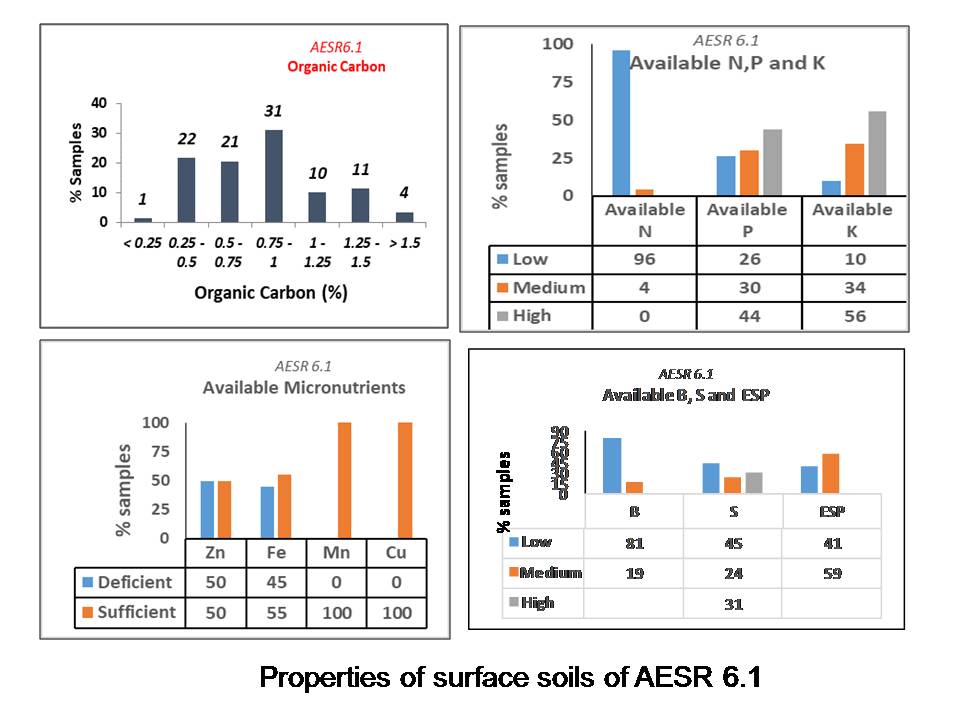
The results of soil analysis indicate that in AESR 18.4, the soils are very strongly acidic to slightly alkaline in reaction with EC <1 dSm-1 indicating that soluble salts are not affecting the soils and crops. The organic carbon status of about 90 % surface soil samples has > 0.75 % carbon indicating that the soils are well supplied with organic carbon. This shows that the coastal environment with rice cultivation is enhancing the accumulation of carbon in the surface. The dynamic nutrient status indicate that all the soils are deficient in N, about 73% medium to high in available P. Low available N is expected in rice growing soils of coastal region due to low input and high intensive cultivation. Better amount of P indicate that they are well supplied with P in spite of acidic condition in many parts. Available K is low in 42%, medium in 41 % and high in 17% samples. All the micronutrients except Zn are sufficient in these soils. Zn is deficient in majority of soils because of intensive agriculture in rice growing soils. Therefore, Zn application is to be initiated in the coastal zones. Among the secondary nutrients B and S are low in majority of soils as expected. Therefore, these nutrients are to be supplied in sufficient dozes.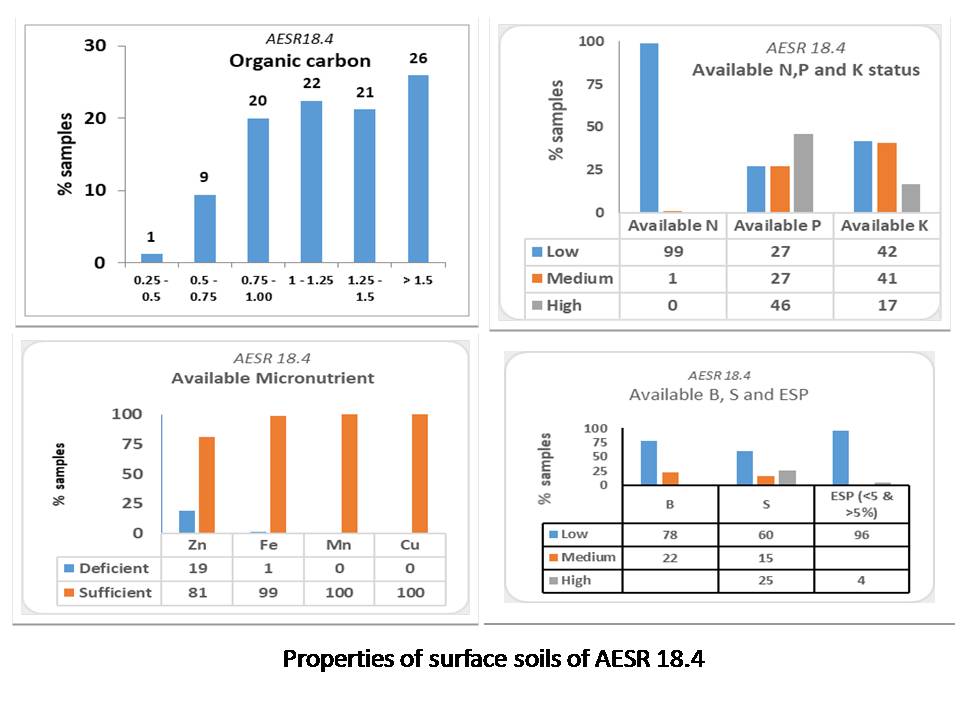
Identification of minimum soil datasets for soil quality indices
The soil quality assessment would be done based on the soil quality indices and Principal Component Analysis (PCA) technique was employed to identify the MDS. PCA was performed on the 20 soil parameters of 340 soil samples to rank their relative significance and to describe their interrelation patterns. Based on eigenvalues, seven principal components (eigen values >=1) were extracted with varimax rotation that could explain 72% variability of the soil datasets. Based on the RSQI, majority of the districts with cotton based cropping system have RSQI of Class II (80-90) whereas the districts with the sugarcane based cropping systems have RSQI of Classes II and III (70-80) in AESR 6.1. The RSQI class is III and IV (60-70) in majority of the districts with small patches of classes I (>90) and II in AESR 18.4. Soils with RSQI of class V (<60) were also found. Thus, RSQI could serve as a unified criterion for comparing regional soil quality. From the relationship between RSQI and crop yields, it is concluded that the soil parameters identified as the soil quality indicators could be helpful in monitoring the soil quality, and sustaining and improving crop yields in AESRs 6.1 and 18.4. The RSQI is significant and positively correlated with the yields of cotton (r = 0.68) and sugarcane (r = 0.77) crops indicating that the identified soil parameters/indicators are able to define the soil quality of the cotton and sugarcane based cropping systems in AESR 6.1. Similarly, for AESR 18.4, a significant and positive correlation (r = 0.75) is observed between the RSQI and the yield of rice crop.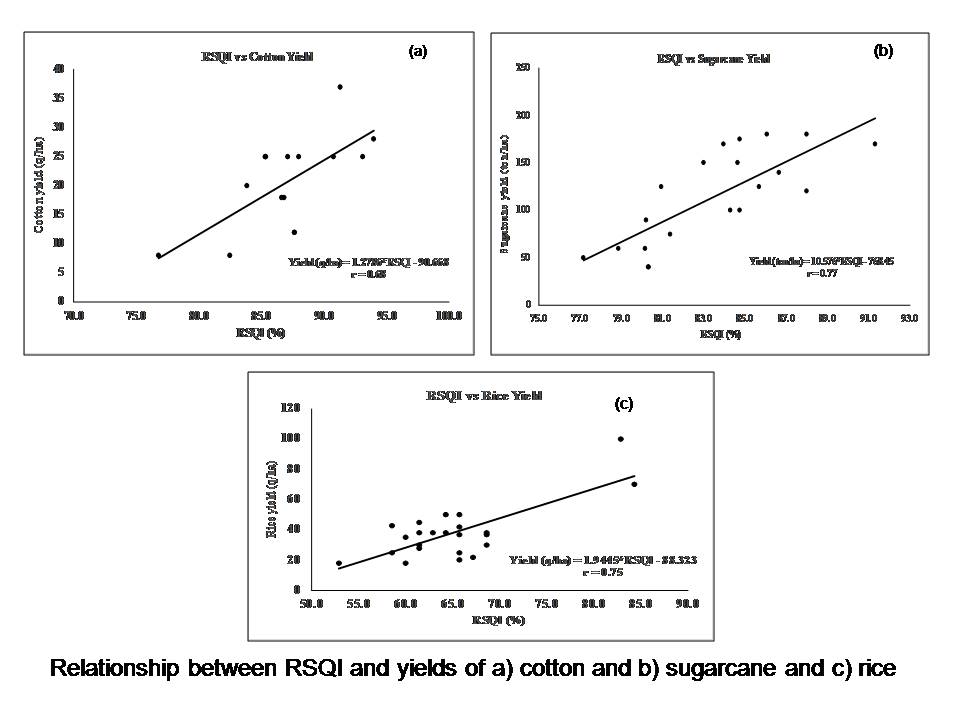
Role of crystalline and non-crystalline nano-clays in stabilization of organic carbon in pedogenetically important soil orders of tropical India (Early Career Research Award, DST Funded)
This project is funded by DST as Early Career Research Award for characterizing crystalline and non-crystalline nano-clays for their structural and physico-chemical properties and to determine stability of soil organic carbon associated with different fractions of nano-clays.
For confirmation of nano size of the separated clays, samples have been analyzed by Transmission electron microscopy (TEM) from IARI and the separated clays has been found in 11-87 nm range (<100 nm) which comes under nano-size.
From XRD results, the following observations have been made:
- Chlorite and mica are found in the silt (50-2 µm) and <2 to <0.10 µm fractions of soils*.
- Smectite is present as dominant clay mineral in the < 0.10 µm fraction which may be of 25% of the total clay fraction.
- Smectite is absent in 50-2 µm and 2-0.10 µm fraction.
- Fine clay (<0.2 µm) fraction of Vertisols contain about 99% of nanoclays (<0.10 µm).
- Total clay (<2 µm) contain 90-95 % nanoclays (<0.10 nm).
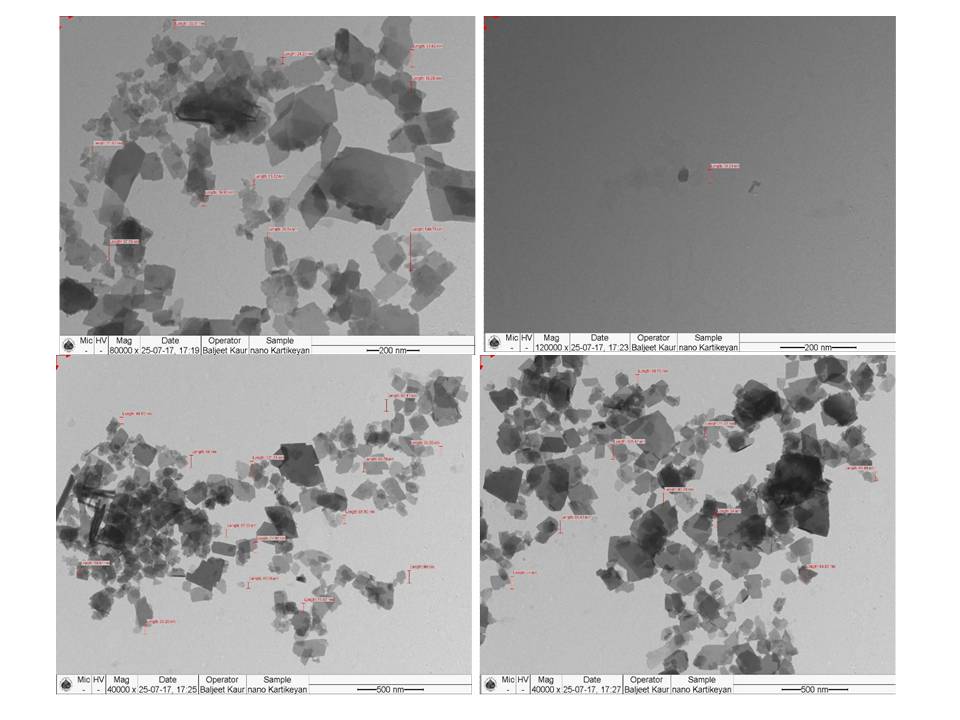
- Soils of humid tropical regions originating from contrasting parent material were studied to establish the factors governing the organic carbon (OC) accumulation in the soils. The OC content is >1 % at 0-30 cm depth in zeolitic and smectitic soils of humid tropical Deccan basalt area of the Bhimashankar Plateau, whereas accumulation of OC in surface and sub-surface of cultivated and forest soils of Nilgiri with mixed mineralogy is nearly five times higher than the soils of Bhimashankar. The observation of higher CEC of Bhimashankar soils than Nilgiri soils indicate the weak role of CEC (in terms of surface area) in OC accumulation.
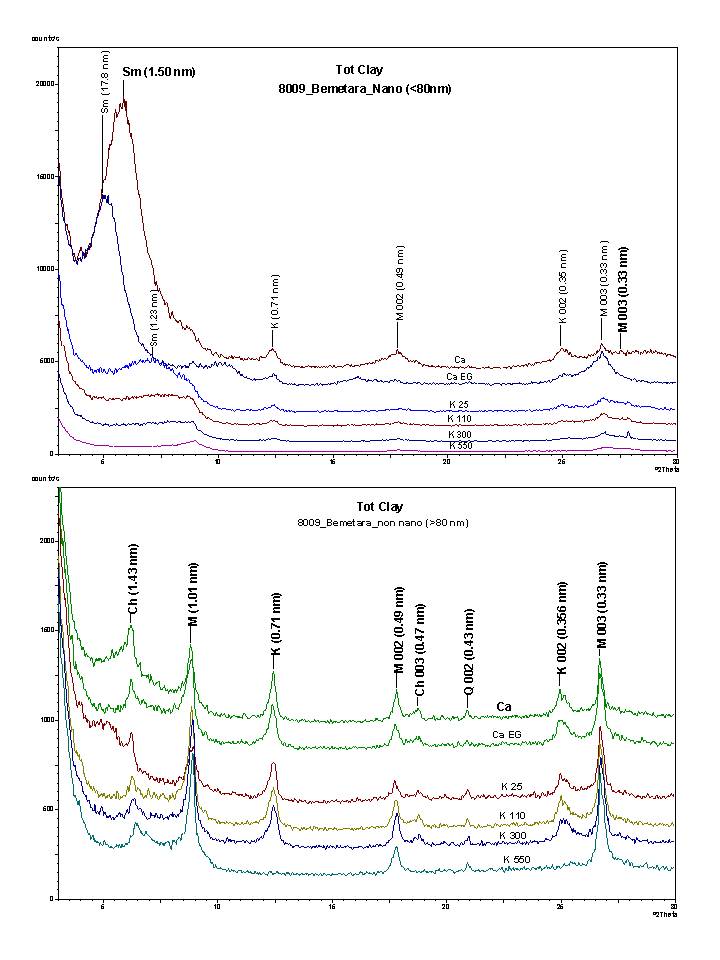
Soil and water management strategies for enhancing agricultural productivity in tribal villages in Warud teshil, Amravati district, Maharashtra (TSP Project)
- Soil test based fertilizer recommendations were provided to the farmers. Crop seeds of Pigeon pea, cotton, sorghum and soybean for kharif season and wheat and Bengal gram for rabi season were supplied along with required amount of fertilizers.
- The results indicated that soil test based fertilizer recommendation along with critical stage irrigation increased crop yield. The increase in pigeon pea yield varied from 15 to 51.4%, (7.4 to 17.4 q ha-1). Sorghum yield increase ranged from 23.4 to 67.9%. (12.4 to 29.6 q ha-1). Cotton yield varied from 1.2 to 4.9 q ha-1. The gram yield increase was higher than the response of other crops as it ranged from 21.5 to 99% (9.9 to 23.5 q ha-1).
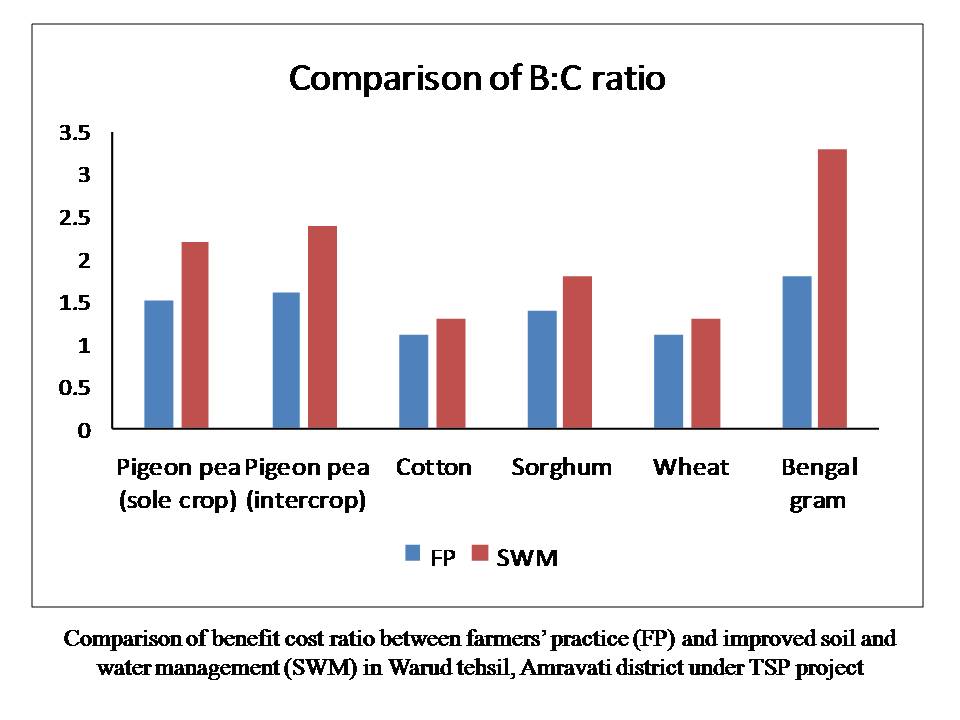
- With desilting drainage line, additional storage capacity of 625 m3 was created. The groundwater and level and open well water storage was increased by an average of 1.5-2 m and the cropping intensity increased, on an average, to 155%.
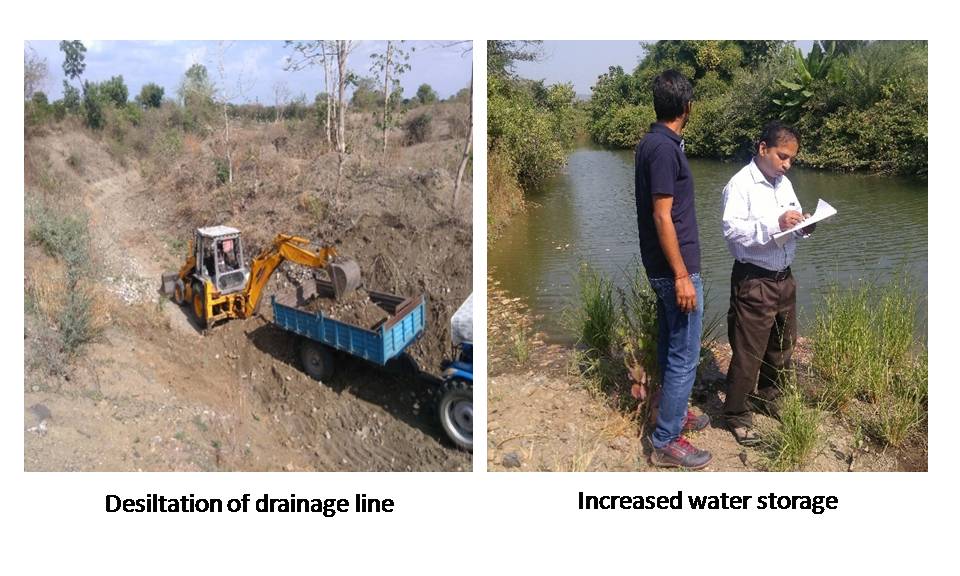
Development of Soil Health Card (SHC) using GIS techniques for Nagpur rural block, and Kelapur Taluka, Yavatmal district
- 6335 surface samples (1 sample per 10 ha) from Nagpur rural and Kelapur block Yavatmal were analysed SHC parameters (pH, organic carbon and salinity (EC), the available major and micro-nutrients and Sulphur)
- Generation of SHCs by Extrapolation: Nutrient database classed into different class ranges suitable for local conditions and interpolated following simple krigging . The data was linked with cadastral map to develop Soil fertility maps and plot wise and farmer wise soil health cards to all the farmers (29000) of Kelapur block.
- STCR based recommendation is given to each parcel of land for major kharif and rabi crops (Desi Cotton, Bt Cotton, Wheat, groundnut, Sorghum, Pulses, Soybean for rain-fed and irrigated.
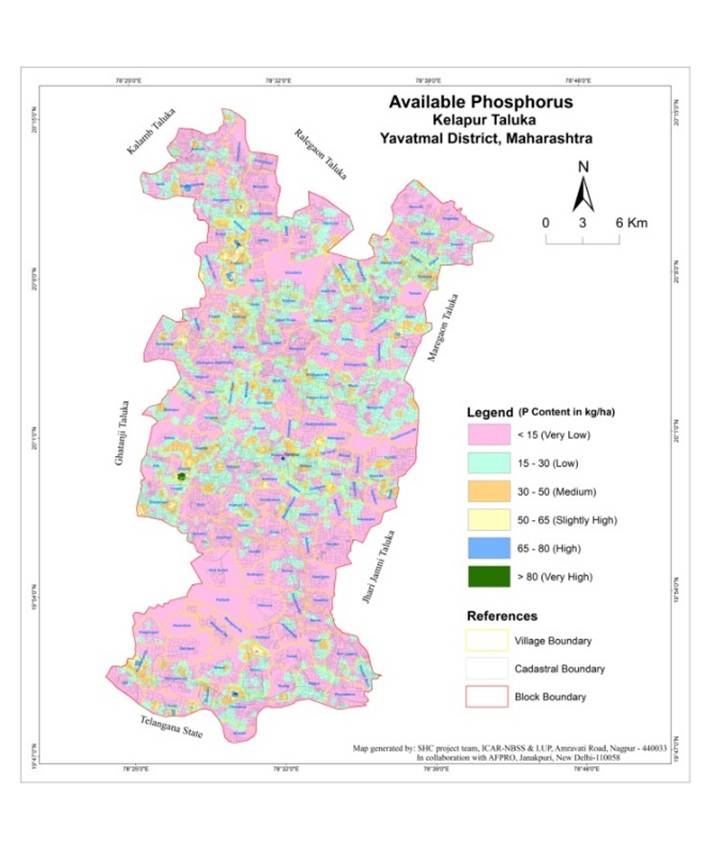
Institute funded project
- Land Resource Inventory of Morena district, Madhya Pradesh on 1:10000 scale for optimal agricultural land use planning, using geo-spatial techniques
- Land resource inventory of southern part of Ahmednagar district (Parmer, Ahmednagar, Pathardi, Shrigonda, Karjat, Jamkhed blocks), Maharashtra on 1:10000 scale for optimal agricultural land use planning using geo-spatial techniques
- Land Resource Inventory of Ahmednagar district (northern part), Maharashtra on 1:10,000 scale using geo-spatial technique
- Land Resource Inventory of Wardha district of Maharashtra at 1:10000 scale using geo-spatial technique for agricultural land use planning
- Land resource inventory of Osmanabad district of Maharashtra using geospatial techniques
- Land resource inventory of Bemetara Block, Bemetara District, Chhattisgarh state (AESR 11) on 1:10000 scale for optimal agricultural land use planning, using geo-spatial techniques
- Developing micro-morphological threshold in climate change study
- Nature and composition of nano-clays of major soil groups of India (Vertisols, Alfisols and Ultisols) and their implications in managing nutrients
- Genesis and Classification of Soils in Bemetara Block, Bemetara District, Chhattisgarh
Externally funded project
- Role of crystalline and non-crystalline nano-clays for carbon stabilization in pedo-genetically important soil orders of tropical India (DST funded)
- Land Resource Inventory of PenchNational park for ecological restoration
Research Papers:
2023
- Vasu, D., Tiwary, P., Chandran, P. 2022. Characterization and classification of arid soils of Kachchh district, Gujarat. Agropedology. doi: 10.47114/j.agroped.2022.dec2
Gangopadhyay, S.K., Ray, S.K., Maitra, A.K., Tiwary, P. Paul, R. 2022 Characteristics and Mineralogy of Some Clay Rich Soils of the LowerIndo-Gangetic Plains of Murshidabad District, West Bengal. Clay Research. Vol. 41, No. 2, pp. 69-81. DOI: 10.5958/0974-4509.2022.00006.7
2022
- Mourya, K., Hota, S., Meena, R.S. and Saikia, U.S. 2022. Nanotechnological Applications in Enhancing Use Efficiency of Micro-nutrients. Biotica Research Today, 4(6):419-420.
- Pal, K. and Tiwary, P. 2022. Pedogenic processes derived plant available water capacity (PAWC) for rainfed deep-rooted crops in Indian Vertisols: A pragmatic method. Agropedology, 32 (01): 94-103.
- Vasu, D., Kuchankar, H., Gautam, N., Tiwary, P., Chandran, , Singh, S.K. 2022. Characterization, Classification and Evaluation of Soils of Olpad Taluka in Coastal Region of Surat District, Gujarat. Journal of the Indian Society of Soil Science, 70(3):287-295.
- Warhade, M., Karthikeyan, K., Tiwary, P., Naitam,R.K. and Kumar, N. 2022. Characterization and Classification of Some Typical Cotton-growing Soils of Samudrapur Block of Wardha District, Maharashtra. Journal of the Indian Society of Soil Science, 70(2):142-148.
2021
- Chandran, , Ray, S.K.., Paul, R., Vasu, D., Karthikeyan, K. and Anantwar, S.G. 2021.Ferruginous soils of humid tropical Andaman and Nicobar Islands: Their pedology, mineralogy and edaphology. ClayResearch.40: 27-40.
- Chandran, P., Vasu, D.,Tiwary, P., Karthikeyan, , Jangir, A., Tiwari, G., Paul, R. and Das, K. 2021. Identifying soil quality indicators for two contrasting agro-ecological sub-regions of India. Archives of Agronomy and Soil ScienceDOI: 10.1080/03650340.2021.1958319, p.1-15.
- Jangir, A., Tiwari, G., Sharma, R.P., Dash, B., Paul, R., Vasu, D., Malav, L.C., Tiwary, P. and Chandran, P. 2020. Characterization, classification and evaluation of soils of Kamrej Taluka in Surat district, Gujarat for sustainable land use Journal of Soil and Water Conservation.19(4): 347-355. DOI: 10.5958/2455-7145.2020.00046.6
- Pakhre, U., Karthikeyan, K., Kumar, N., Tiwary, P., Chandran, P. 2021. Characterization and evaluation of cotton growing soils of Ghantanji Tehsil, Yavatmal District, Maharashtra. Agropedology. 30(1): 1-11.
- Paul, ,Karthikeyan, K., Vasu, D., Tiwary, P. and Chandran, P. 2021. Origin and mineralogy of nano clays of Indian Vertisols and their implications in selected soil properties. Eurasian Soil Science 54: 572-585.
- Paul, , Karunakaran, K., Vasu, D., Sahoo, S., Tiwary, P., Gaikwad, S.S. and Chandran, P. 2020. Predicament in identifying clay palygorskite in Vertisols of Chhattisgarh Basin, India. Clay Research. 39: 77-88.
- Vasu, D., Tiwary, G., Sahoo, S., Bash, B., Jangir, A., Naitam, R., Tiwary, , Karthikeyan, K., Chandran, P. 2021. A minimum data set of soil morphological properties for quantifying soil quality in coastal agroecosystems.Catena198, (doi.org//10.1016/j.catena.2020.105042.
- Venugopalan, M.V., Tiwary, P. and Pable, D. (2021). Comparison of different land evaluation techniques for evaluating soil suitability for rainfed hybrid Agropedology. 30(2):77-87.
2020
- Vasu D, Sahu Nisha, Tiwary P and Chandran P (2020). Modelling the spatial variability of soil micronutrients for site specific nutrient management in a semi-arid tropical environment. Earth Syst. Environ., https://doi.org/10.1007/s40808-020-00909-4
- Vasu D, Karthikeyan K, Atole Sharad, Paul Ranjan, Gaikwad S S, Kuchankar H, Sheikh Shabana, Gautam Neha, Narse Roshani, Tiwary P and Chandran P (2020). Elucidating the geogenic and pedogenic pathways of formation of soils of Peninsular India–Signatures of past landscape modifications. Catena, 192: https://doi.org/10.1016/j.catena.2020.104591
- Sharma RP, Chattaraj S, Vasu D, Karthikeyan K, Tiwary P, Naitam RK, Dash B, Tiwari G, Jangir A, Daripa A, Singh SK, Anantwar SG and Nimkar AM (2020). Spatial variability assessment of soil fertility in black soils of central India using geostatistical modeling. Archives of Agronomy and Soil Science, https://doi.org/10.1080/03650340.2020.1766678
2019
- Karthikeyan K, Vasu D, Tiwary P, Cunliffe A M, Chandran P, Mariappan S, Singh S K (2019). Comparison of methods for evaluating the suitability of Vertisols for Gossypium hirsutum (Bt cotton) in two contrasting agro-ecological regions. Archives of Agronomy and Soil Science, 65(7): 968–979.
- Jadhao, L.B., Jagdish Prasad, Karthikeyan, K. and Tiwary, P. (2019). Characterization and suitability assessment of some pomegranate growing and associated soils of Solapur district, Maharashtra. Journal of the Indian Society of Soil Science, 67(3):260-271.
- Mukhopadhyay, R., Adhikari, T., Sarkar, B., Barman, A., Paul, R., Patra, A.K., Sharma, P.C. and Kumar, P. (2019). Fe exchanged nano-bentonite outperforms Fe3O4 nanoparticles in removing nitrate and bicarbonate from wastewater. Journal of Hazardous Materials, 376:141-152.
- Jangir, A., Sharma, R.P., Tiwary, G., Vasu, D., Chattaraj, S., Dash, B., Malav, L.C., Chandran, P., Singh, S.K., Kuchankar, H. and Sheikh, S. (2019). Status of available major and micronutrients in soils of Kelapur block, Yavatmal district, Maharashtra. Journal of Soil and Water Conservation, 18(3): 241-245.
- Sharma, R.P., Singh, R.S., Naitam, R.K. and Singh, S.K. (2019). Technique of large scale soil mapping using remote sensing satellite data in basaltic terrain of peninsular region in the north-west Gujarat, India. Journal of the Indian Society of Soil Science, 67(2):151-159. DOI: 10.5958/0974-0228.2019.00016.1
- Sharma, R.P., Singh, R.S., Singh, S.K. and Sharma, S.S. (2019). Weathered basalt application for management of Vertisols: A traditional knowledge of groundnut (Arachis hypogaea) growers of Gujarat, India. Indian Journal of Traditional Knowledge, 18(4): 793-799.
- Sharma, R.P., Singh, R.S. and Singh, S.K. (2019). Significance of clay minerals in development of alluvial soils of Aravalli range. Indian Journal of Geo-Marine Sciences, 48(11):1783-1795.
- Karthikeyan, K., Govindsamy, V., Gobinath, R. and Prasad, J. (2019). Nano-scaled soils-characterization and application in plant nutrient management. Indian Journal of Fertilizers, 15(11):1238-1257.
- Mishra, G., Jangir, A., Francaviglia, R. (2019). Modeling soil organic carbon dynamics under shifting cultivation and forests using Rothc model. Ecological Modelling. 396: 33-41.
- Ingle S N, Nagaraju M S S, Girdekar S B, Sahu Nisha, Tiwary P, Srivastava Rajeev, Giri S P and Yadav S K (2019). Land evaluation for suitability of diversified cropping system in Bareli watershed of Seoni district, Madhya pRadesh Using GIS. Journal of Pharmacognosy and Phytochemistry, SP2: 949-954.
2018
- Vasu, D., Srivastava, R., Patil, N.G., Tiwary, P., Chandran, P.,and Singh, S.K., (2018). A comparative assessment of land suitability evaluation methods for land use planning at village level. Land Use Policy. 79: 146-163.
- Vasu, D., Tiwary, P., Chandran, P., Singh, S.K., Ray, S.K., Butte, P., Parhad, V. (2018). A conceptual model of natural land degradation based on regressive pedogenesis in semi-arid tropical environments. Land Degradation & Development. 29(8): 2554 – 2567.
- Ingle S N, Nagaraju M S S, Sahu Nisha, Srivastava Rajeev, Tiwary P, Sen T K and Nasre R A (2018). Mapping of spatial variability in soil properties and soil fertility for site-specific nutrient management in Bareli Watershed, Seoni District of Madhya Pradesh Using Geostatistics and GIS. International Journal of Current Microbiology and Applied Sciences 7(10): 2299-2306.
- Sharma, R.P., Singh, R.S., Singh, S.K. and Arora, S. (2018). Land Resource Inventory (LRI) for development of sustainable agricultural land use plans using geospatial techniques: A case study of Pata Meghpar village, Jamnagar district, Gujarat. Journal of Soil and Water Conservation,17(1): 15-24. DOI: 10.5958/2455-7145.2018.00003.6
- Bhattacharyya, T., Ray, S.K., Chandran, P., Karthikeyan, K. and Pal, D.K. (2018). Soil quality and fibrous mineral in black soils of Maharashtra. Current Science 115(3):482-492.
- Meena, K., Kumari, A.R., Sharma, R.P. and Srivastava, R. (2018). Study on Production Potential of Rice through Front Line Demonstration in Deoria District of Uttar Pradesh, India. International Journal of Current Microbiology and Applied Sciences, 7(1): 328-331. https://doi.org/10.20546/ijcmas.2018.701.036
- Huang, Z., Selvalakshmi, S., Vasu, D., Liu, Q., Cheng, H., Guo, F., Ma, X. (2018). Identification of indicators for evaluating and monitoring the effects of Chinese fir monoculture plantations on soil quality. Ecological Indicators. 93: 547-554.
- Choudhari, P.L., Jagdish Prasad and Gurav P.P. (2018). Distribution of DTPA-extractable Fe, Mn, Zn and Cu in teak and sandalwood supporting soils in Seoni district, Madhya Pradesh. Indian Forester, 144 (1): 73-77.
- Vasu, D., Tiwary, P., Chandran, P., Singh, S.K., Ray, S.K., Butte, P., Parhad, V. (2018). A Conceptual Model of Natural Land Degradation Based on Regressive Pedogenesis in Semi‐Arid Tropical Environments. Land Degradation & Development (in Press).
2017
- Singh, H., Burark, S.S., Sharma, S.K., Jajoria, D.K. and Sharma, R.P. (2017). Economic evaluation of farming systems for agricultural production in southern Rajasthan. Economic Affairs,62 (1): 47-53. DOI: 10.5958/2230-7311.2017.00036.8
- Dominique A., Johan G.B. Leenaars, Anne C. Richer-de-Forges, et al., Jagdish Prasad, Patil, N. (2017). Soil legacy data rescue via Global Soil Map and other international and national initiatives. Geo Res J., 14:1-19
- Thelkar S.I., Srivastava, R., Patil N.G., Jagdish Prasad, Nagaraju M.S.S., Chattaraj S., Obi Reddy, G.P. and Nasre, R.A. (2017). Categorization and delineation of agricultural prime and marginal lands of Nagpur district, Maharashtra for different uses. Journal of Soil and Water Conservation, 16(2):108-116.
- Gurav P.P., Ray S.K., Choudhari P.L., Bhattacharyya T., Chandran P., Kharche V.K., Tiwary P. and Biswas A.K. (2017). Characterization of some Vertisols of different agro-ecological subregions of India. Agropedology, 27(01): 84-92.
- Zade, S.P., Chandran, P., Pal, D.K. (2017). Role of calcium carbonate and palygorskite in enhancing exchangeable magnesium to impair drainage of Vertisols of semi-arid western India. Clay Res., 36: 33-45.
- Bhaskar B.P, Prasad J. and Gopal Tiwari (2017). Evaluation of agricultural land resources for irrigation in the cotton growing Yavatmal district, Maharashtra, India. Journal of Applied and Natural Science, 9(1):102-113.
- Bhaskar B.P, Tiwari G. and Prasad J (2017). Pedogenic influence on profile distribution of total and DTPA – extractable micronutrients in rice growing hydric soils of Majuli river island, Assam, India. Spanish Journal of Soil Science, 7 (1) :45-71.
- Bhaskar, B.P., Maske Sunil, Gaikwad, S.S., Chaturvedi, A., Jagdish Prasad, Anantwar, S.G. and Singh, S.K. (2017). Soil and land resource evaluation for rural agricultural land use planning-A case study from hot semiarid ecosystem of Western India. Archives of Agriculture and Environmental Science, 2(3): 206-218.
- Vasu D., Singh S.K., Sahu N., Tiwary P., Chandran P., Duraisami V.P., Ramamurthy V., Lalitha M. and Kalaiselvi B. (2017). Assessment of spatial variability of soil properties using geospatial techniques for farm level nutrient management. Soil and Tillage Research, 169: 25-34.
- Vasu, D., Singh, S.K., Tiwary, P., Sahu, N., Ray, S.K., Butte, P.S., Duraisami, V.P. (2017). Influence of geochemical processes on hydrochemistry and irrigation suitability of groundwater in part of semi-arid Deccan Plateau, India. Appl Water Sci., 1-13. DOI 10.1007/s13201-017-0528-2.
- Bhattacharyya T., Tiwary P., Pal D.K., Khobragade R., Telpande B. and Kuchankar H. (2017). Estimating soil organic matter and available N: A ready reckoner for soil testing laboratories. Advanced Agricultural Research & Technology Journal, 1(1): 3-13.
- Vasu D., Singh S.K., Tiwary P, Chandran P., Ray S.K. and Duraisami V.P. (2017). Pedogenic processes and soil–landform relationships for identification of yield-limiting soil properties. Soil Research, 55(3): 273-284 (org/10.1071/SR16111).
- Paul, R., Singh, R.D., Patra, A.K., Biswas, D.R., Bhattacharyya, R. and Arunkumar, K. (2017). Phosphorus dynamics and solubilizing microorganisms in acid soils under different land uses of lesser Himalayas of India. Agroforestry Systems. DOI: https://doi.org/10.1007/s1045.
- Paul, R., Datta, S.C., Manjaiah, K.M. and Bhattacharyya, R. (2017). X-ray crystallinity of different soil nanoclays in relation to phosphatase adsorption. Applied Clay Science,144, 19-25.
- Satyavathi P.L.A., Tiwary P., Bhaskar B.P., Ray S.K., Prasad Jagdish and Bobde S.V. (2017). Pedotransfer Functions to Estimate Soil Water Retention Characteristics in Major Cotton Growing Shrink-swell Soils of Yavatmal District, Maharashtra. Journal of the Indian Society of Soil Science, 65 (4): 379-386.
- Bhaskar, B. P., Prasad, J. and Tiwari, G. (2017). Evaluation of agricultural land resources for irrigation in the cotton growing Yavatmal district, Maharashtra, India. Journal of Applied and Natural Science, 9(1): 102 –113.
- Bhaskar, B. P. and Tiwari, G. (2017). Geochemical Interpretations of Laterite Associated Soils of East Coast Andhra Pradesh. Chemical Science Review and Letters, 6(21):187-197.
- Bhaskar, B. P., Tiwari, G. and Prasad, J. (2017). Pedogenic influence on profile distribution of total and DTPA – extractable micronutrients in rice growing hydric soils of Majuli river island, Assam, India. Spanish Journal of Soil Science, 7(1): 45-71.
2016
- Sharma, S.S., Sharma, R.P., Singh, R.S., Singh, S.K. (2016). Characterization and formation of salt affected soils in Bhilwara district, Rajasthan. Agropedology,26 (02): 230-236.
- Padekar Deepak, Bhattacharyya T., Ray S.K., Tiwary P. and Chandran P. (2016). Influence of irrigation water on black soils in Amravati district, Maharashtra. Current Science, 110 (9): 1740-1755 ( doi: 10.18520/cs/v110/i9/1740-1755).
- Chaudhury, S., Bhattacharyya, T., Wani, S.P., Pal, D.K., Sahrawat, K.L., Nimje, A., Chandran, P., Venugopalan, M.V. and Telpande, B. (2016). Land use and cropping effects on carbon in black soils of semi-arid tropical India Current Science, 110:1692 -1698.
- Bhaskar, B.P., Anantwar, S.G., Gaikwad, S.S. and Bobade, S.V. (2016). Land resource assessment for agricultural development in Seoni district, Madhya Pradesh, India. Journal of Applied and Natural Science, 8(2):750-759.
- Vasu D., Singh S. K., Ray S. K., Duraisami V. P., Tiwary P., Chandran P., Nimkar A. M. and Anantwar S. G. (2016). Soil quality index as a tool to evaluate crop productivity in semi-arid Deccan plateau, India. Geoderma, 282: 70-79.
- Dubey, P. N, Bhaskar, B. P., Chandran, P., Singh, B., and Mishra, B. K. (2016). Geochemistry of some ferruginous soils of Kerala, India. Journal of Applied and Natural Science8:196-207.
- Vasu, D., Singh, S.K., Duraisami, V.P., Jangir, A., Butte, P.S. (2016). Fertility status of cotton growing soils in Thimmajipet mandal, Mahabubnagar district, Telangana. Andhra Pradesh J Agril. Sci. 2(1): 10-15.
- Vasu, D., Singh, S.K., Karthikeyan, K., Duraisami, V.P. (2016). Fertility Capability Classification (FCC): A case study in rainfed soils of semi-arid Deccan plateau. Agropedology26(1):22-28.
- Keshavarzi, A., Omran, E.S.E., Bateni, S.M., Pradhan, B., Vasu, D., Bhagerzadeh, A. (2016). Modelling of available soil phosphorus (ASP) using multi-objective group method of data handling. Earth Syst. Environ. 2:157.
- Nirmal Kumar, Karthikeyan, K. and Jagdish Prasad (2016). Visual soil quality assessment – A review. Journal of Soil and Water Conservation15:6-13
- Bhattacharyya, T., Wani S P., Pal, D.K., Sahrawat, K.L., Pillai, S., Nimje A., Telpande, B., Chandran, P. and Chaudhury, S. (2016). ICRISAT, India soils: yesterday, today and tomorrow, Current Science, 110:1652 -1670.
- Sharma, R.P., Singh, R.S., Singh, S.K. and Reddy, G.P. Obi (2016). Extent of land degradation and status of wastelands in Rajasthan (NW India) with a focus on the Bhilwara District. Journal of Agriculture and Environment for International Development (JAEID), 110 (01): 97-115. DOI: 10.12895/jaeid.2016.413
- Naitam, R.K., Singh, R.S., Sharma, R.P., Verma, T.P. and Arora, S. (2016). Morphometric analysis of Chanavada-II watershed in Aravalli hills of southern Rajasthan using geospatial technique. Journal of Soil and Water Conservation, 15 (04): 318-324
- Bhattacharyya, T, Wani, S. P., Chandran, P., Tiwary, P. Pal D. K., Sahrawat K. L and Velayutham, M. (2016). Soil Information System: web-based information technology for agricultural land use planning. Current Science110:241-245.
- Gajare A.S., Mandal D.K. and, Jagdish Prasad (2016). Assessment of different pools of organic carbon for better C management in cotton-growing shrink-swell soils of Jalgaon district, Maharashtra. Indian Journal of Agricultural Sciences 85 (5):77-80.
2015
- Jagdish Prasad (2015). Soil health management- A key for sustainable production. Journal of the Indian Society of Soil Science63: S6-S13
- Gajare A.S., K. Mandal, Nirmal Kumar and Jagdish Prasad (2015) Modeling water retention characteristics of major shrink swell soils of Jalgaon District,. Maharashtra, India. Agropedology 25:43-53.
- Bhaskar, B.P.(2015). Landscape planning for agridevelopment at regional scale: an example from cotton growing Yavatmal district, Maharashtra, India. Journal of Agriculture and Environment for International Development109:235-269.
- Bhaskar, B.P., Bobade, S.V., Gaikwad, S.S., Sarkar, D., Anantwar, S.G. and Bhattacharyya, T. (2015). Soil informatics for agricultural suitability assessment in Seoni district, Madya Pradesh, India.Indian Journal of Agricultural Research49:315-320.
- Bhattacharyya T., Chandran P., Ray S. K., Mandal C., Tiwary P., Pal D.K., Maurya U.K., Nimkar A.M., Kuchankar H., Sheikh S., Telpande B.A. and Kolhe A. Walkley-Black recovery factor to reassess soil organic matter: Indo-gangetic plains and black soil region of India case studies. Communications in Soil Science and Plant Analysis 46:2628–2648.
- Bhattacharyya T., Mandal C., Mandal D. K., Jagdish Prasad, Tiwary P., Venugopalan M.V. and Pal D.K. (2015). Agro-eco sub-region based crop planning in the black soil regions and Indo-gangetic plains – Application of soil information system. Proceedings of Indian National Science Academy 81:1151-1170.
- Bhattacharyya, T., Chandran, P., Ray, S.K., Pal, D.K., Mandal, C., Mandal, D.K. (2015). Distribution of Zeolitic soils in India. Current Science109:1305-1313.
- Gajare A.S., Mandal D. K., Mandal C and Jagdish Prasad (2015). Cationic micronutrient status in cotton growing shrink-swell soils of Jalgaon district of Maharashtra. Indian Journal of Fertilisers11:66-69.
- Jangir, A., Singh, V., Srivastava, P.C., Shriram and Bhatnagar, A. (2015). Phosphorus and zinc uptake and protein, lysine and tryptophane contents in quality protein maize in relation to phosphorus and zinc fertilization in Mollisols. Annals of Agricultural Research36:50-57.
- Karthikeyan, K., Nirmal Kumar, Jagdish Prasad and Rajeev Srivastava (2015). Soil quality and its assessment : A Review. Journal of Soil & Water Conservation14:100-108.
- Mahajan, M.S., Patil, N.G., Chaturvedi, A., Bhaskar, B.P.,Hajare,N., Saroj Deshmukh, Dubey, P.N. and Singh, S.K. (2015). Development of efficient farming systems through land use planning in Dhule district, Maharashtra, India. Agropedology25:110-124.
- Mandal D. K., Goswami S. N, Mandal C., Jagdish Prasad and Nirmal Kumar (2015). Economic loss estimation under rainfall aberration in semi-arid tropics of India. Indian Journal of Soil Conservation43:182-186.
- Pradhan, N., Prakash, P., Manimurugan, C., Tiwari, S. K., Sharma, R.P. and Singh, P.M. (2015). Screening of tomato genotypes using osmopriming with PEG 6000 under salinity stress. Research in Environment and Life Sciences 8:245-250.
- Ramamurthy, V., Venugopalan, M.V., Parhad V.N. and Jagdish Prasad (2015). Effect of seed priming on emergence and yield of late sown wheat (Triticum aestivum L.) on Typic Haplusterts of Central India. Indian Journal of Agricultural Research49:245-249.
- Sharma, R.P. and Singh, R.S. (2015). Carbon stock and its management in soils of Bhilwara district, Rajasthan. Journal of the Indian Society of Soil Science 63:304-309. DOI: 10.5958/0974-0228.2015.00040.7
- Sharma, R.P., Singh, R.S. and Singh, S.K. (2015). A review on agricultural land use planning: A case study of Bhilwara district. Advances in Applied Science Research 6:125-133.
- Sharma, R.P., Singh, R.S. and Singh, S.K. (2015). Agricultural land use planning of Bhilwara district, Rajasthan. Agropedology 25:20-32.
- Tiwary P., Bhattacharyya T., Mandal C., Dasgupta, D. and Telpande B. (2015). Pedometric mapping of soil organic carbon loss using soil erosion maps of Tripura. Current Science108: 1326-1339.
- Bhattacharyya, T. ,Ray, S. K. Maurya, U. K. Chandran, P., Pal, D. K. , Durge, S. L., Nimkar, A. M. , Sheikh, S. M., Kuchankar, H. W. Telpande, B., Dongre V and Kolhe A. Carbon and nitrogen estimation in soils : Standardizing methods and internal standards for C/N analyzer, Journal of Indian Chemical Society 92:263-269.
- Vasu D., Singh S.K., Tiwary P., Butte P.S. and Duraisami V.P. (2015). Evaluation of groundwater quality for irrigation suitability in Thimmajipet mandal, Mahabubnagar district, Andhra Pradesh. Journal of Agricultural Sciences1:1-6.
- Gangopadhyay, S.K., Bhattacharyya, T. and Sarkar, D. (2015). Hydromorphic soils of Tripura : their pedogenesis and characteristics. Current Science 108:984-993.
- Vasu, D., Biswas, A.K., Singh, A. (2015). Effect of biochar addition on soil carbon emission and nitrogen mineralization in some typical Indian soils. International Journal of Emerging Research in Management & Technology 4:17-22.
- Ambekar, Abhijit. S., Sridhar D. N., Ray, S.K., Bhattacharyya, T., Anantwar, S.G., Sahu, V. T. and Gaikwad, M. S. (2015). Research Communication: Probable Source of rocks for millstone and cannon balls of Goa, India. Current Science 108(02):273-282.
- Bhaskar, B.P., Sarkar,Dipak, Bhattachryya, T., Satyavathi, P.L.A., Bobade, S.V. and anantwar, S.G. (2015). Geochemical Characterization of shrink-swell soils in Yavatmal district, Maharashtra. Journal of Applied Geochemistry 17(1):98-108.
2014
- Goswami, S.N., Sen, T.K., Jagdish Prasad and Chatterji, S. (2014). Effect of climatic and socio-ecnomic factors on under-utilization of land in Maharashtra. Agropedology24(1):41-51.
- Padekar D.G., Bhattacharyya T., Deshmukh P.D., Ray S.K. Chandran P. and Tiwary P. (2014). Is irrigation water causing degradation in black soils? Current Science 106:1487-1489.
- Patil, N. G., Tiwary, P., Bhattacharyya,T., et al. (2014). Natural resources of the Indo-Gangetic Plains: a land-use planning perspective. Current Science 107(9): 1537-1549.
- Bhaskar, B.P., Sarkar, Dipak, Bobade, S.V., Gaikwad, S.S. and Anantwar, S.G. (2014). Land evaluation for irrigation in cotton growing Yavatmal district, Maharashtra. International Journal of Research in Agricultural Sciences 1(2):128-136.
- Ray, S. K., Bhattacharyya,T., K. R. Reddy, et al. (2014). Soil and land quality indicators of the Indo-Gangetic Plains of India. India.Current Science 107(9):1470-1486.
- Raychaudhuri, Mausumi, Kundu, D K., Ashwani Kumar, et al. (2014). Soil physical quality of the Indo-Gangetic Plains and black soil region. Current Science 107(9): 1440-1451.
- Sidhu, G. S., Bhattacharyya,T., Sarkar, D., et al. (2014). Impact of management levels and land-use changes on soil properties in rice–wheat cropping system of the Indo-Gangetic Plains. Current Science 107(9):1487-1501.
- Bhaskar, B.P., Raja, P. and Bhattacharyya, Tapas Soil informatics for agricultural land suitability assessment in Seoni district, Madhya Pradesh, India. Enviro Geochimica Acta. 1(5): 292-300.
- Srivastava Rajeev, Solanke, Preeti C., Nagaraju, M.S.S., Jagdish Prasad, Nasre, R.A., Mohekar, D.S. and Barthwal, A.K. (2014). Status of available micronutrients and their relationship with soil properties in Nagpur district, Maharashtra. Indian Journal of Dryland Agriculture 29(1):68-72.
- Srivastava, Alok Kumar, Velmourougane, Kulandaivelu, Bhattacharyya,T., et al. (2014). Impacts of agro-climates and land use systems on culturable microbial population in soils of the Indo-Gangetic Plains, India.Current Science 107(9):1464-1469.
- Goswami, S.N., Sen, T.K., Jagdish Prasad and Chatterji, S. (2014). Effect of climatic and socio-ecnomic factors on under-utilization of land in Maharashtra. Agropedology 24(1):41-51.
- Mandal, C., Mandal, D.K., Bhattacharyya,T., et al. (2014). Revisiting agro-ecological sub-regions of India – a case study of two major food production zones. Current Science 107(9): 1519-1536.
- Tiwary, P., Patil, N.G., Bhattacharyya,T., et al. (2014). Pedotransfer functions: a tool for estimating hydraulic properties of two major soil types of India. Current Science, 107(9): 1431-1439
- Utpal Baruah, T.H.Das, B.P.Bhaskar and Dipak Sarkar.(2014). Characterization of rice growing soils: A case study in Gerua Farm, Assam. Agropedology 24(1):119-123.
- Velmourougane, K., M. V. Venugopalan, Bhattacharyya,T., et al. (2014). Impacts of bioclimates, cropping systems, land use and management on the cultural microbial population in black soil regions of India. Current Science 107(9):1452-1463.
- Venugopalan, M. V., Tiwary, P., Ray, S.K. , et al. (2014). InfoCrop-cotton simulation model – its application in land quality assessment for cotton cultivation. Current Science 107(9):1512-1518.
- Rajeev Srivastava, Solanke, Preeti C., Nagaraju, M.S.S., Jagdish Prasad, Nasre, R.A., Mohekar, D.S. and Barthwal, A.K. (2014). Status of available micronutrient cations and their relationship with soil properties in Nagpur district, Maharashtra. Indian Journal of Dryland Agricultural Research and Development, 29(1):68-72.
- Bhattacharyya, T., Sarkar, D., Ray, S.K. , Chandran, P. , Pal, D.K., Mandal, D.K., Prasad, J., Sidhu,G. S., Nair, K M., Sahoo, A.K., Das, T.H., Singh, R.S., Mandal, C., Srivastava, R., Sen,T. K., Chatterji, S., Patil, N.G., Obireddy, G. P., Mahapatra, S K., Anil Kumar, K.S., Das, K., Singh, A.K., Reza, S. K., Dutta, D., Srinivas, S., Tiwary, P., Karthikeyan, K., Venugopalan, M.V., Velmourougane, K., Srivastava, A., Mausumi Raychaudhuri, Kundu, D K., Mandal, K.G., Kar, G., Durge, S.L., Kamble, G.K., Gaikwad, M.S., Nimkar, A.M., Bobade, S.V., Anantwar, S.G., Patil, S., Sahu, V.T., Gaikwad, K.M., Bhondwe, H., Dohtre, S.S., Gharami, S., Khapekar, S.G., Koyal, A., Sujatha, B. Reddy, M.N., Sreekumar, P., Dutta, D.P., Gogoi, L., Parhad, V.N., Halder, A.S., Basu, R., Singh, R., Jat, B.L., Oad, D.L., Ola, N.R., Wadhai, K., Lokhande, M., Dongare, V.T., Hukare, A., Bansod, N., Kolhe, A., Khuspure, J., H. Kuchankar, Balbuddhe, D., Sheikh, S., Sunitha, B.P., Mohanty, B., Hazarika, D., Majumdar, S., R. S. Garhwal, Sahu A., S. Mahapatra, S. Puspamitra, Kumar, A., Gautam,N., Telpande, B.A., Nimje, A.M., Likhar, C., and Thakre, S. (2014). Soil information system: use and potentials in humid and semi-arid tropics. Current Science 107(9):1550-1564
- Bhattacharyya, T., Chandran, P.; Ray, S.K., Tiwary, P., Dharmik, A., Mandal, D.K., Mandal, C., Chatterji, S., Pal, D.K., Obireddy, G.P., Sarkar, D. and Singh, S. K. (2014). Web-GeoSIS as soil information technology: A conceptual framework Agropedology, 24(2):222-233.
- Bhattacharyya, T., Sarkar, D., Ray, S. K. et al. (2014). Georeferenced soil information system: assessment of database. Current Science 107(9):1400-1419.
- Chandran, P., Tiwary, P., Bhattacharyya, T., et al. (2014). Development of soil and terrain digital database for major food-growing regions of India for resource planning. Current Science 107(9):1420-1430.
- Chatterji, S., Tiwary, P., Sen,T. K., et al. (2014). Land evaluation for major crops in the Indo-Gangetic Plains and black soil regions using fuzzy model. Current Science 107(9): 1502-1511.
- Deshmukh H. V, Chandran, P., Pal, D. K., Ray, S. K., Bhattacharyya, T and S.S. (2014). A pragmatic method to estimate plant available water capacity (PAWC) of rainfed cracking clay soils (Vertisols) of Maharashtra, Central India. Clay Research 33:1-14.
2013
- Telpande, B.; Bhattacharyya, T.; Wankhede, D.M Jha, P.; Tiwari, P. ; Chandran, P. and Ray, S.K;. (2013). Simulating soil organic carbon in high clay in in India : DNDC model experience . Climate Change and Environmental Sustainability 1(2): 118-126 (DOI 10.5859/j2320-642X.1.2.011).
- Bhattacharyya, T.; Pal, D.K.; Ray, S.K; Chandran, P., Mandal, C.; Deshmukh, A.S.; Telpande, B. and Tiwari, P. (2013). Simulating change in soil organic carbon in two long term fertilizer experiments in India : with the RothC Climate Change and Environmental Sustainability (October 2013) 1(2): 104-117 126 (DOI 10.5859/j2320-642X.1.2.010).
- Roy, Ratna, P., Jagdish Prasad, Joshi, A.P. and Gupta Rashmi (2013). Accumulation of heavy metals in soils and radish crop irrigated with wastewater of textile industry in Nagpur district, Maharashtra. Bangladesh Journal of Agriculture and Environment 9(1):25-28
- Thakre, P.V., Ray, S.K., Chandran, P., Bhattacharyya, T. and Pal, D.K. and (2013). Does sodicity in Vertisols affect the layer charge of smectites? Clay Research, 32: 76-90.
- Bhattacharyya, D. K. Pal, C. Mandal, P. Chandran, S. K. Ray, Dipak Sarkar, K. Velmourougane, A. Srivastava, G. S. Sidhu; R. S. Singh; A. K. Sahoo, D. Dutta, K. M. Nair, R. Srivastava, P. Tiwary, A. P. Nagar and S. S. Nimkhedkar (2013). Soils of India: historical perspective, classification and recent advances ( review article) Current Science 104 (10):1308-1323.
- Velmourougane, Kulandaivelu., Venugopalan , M.V., Bhattacharyya,T., Sarkar, Dipak., Pal,D.K., Sahu, Apeksha., Chandran, P., Ray, S.K., Mandal, Champa., Nair, K.M., Jagdish Prasad, Singh S., Tiwary, Pramod (2013). Urease activity in various agro-ecological sub-region of black soil regions of India. Proceeding of the National Academy of Science, India Section B: Biological Sciences 83(4): 513-524.
- Jagdish Prasad (2013). Evaluation of some typical soils of Jalgaon district of Maharashtra for suitability of cotton. Journal of Cotton Research and Development 27(2):242-245.
- Velmourougane K., Venugopalan M.V., Bhattacharyya T., Sarkar D. , Pal D.K., Sahu A., Ray S.K., Nair K.M., Jagdish Prasad , Singh R.S.(2013). Soil dehydrogenase activity in agro-ecological sub regions of black soil regions in India. Geoderma 197–198: 186–192.
- P.Bhaskar and R.K.Saxena (2013).Soil-landscape relationship in Lohit valley near Tezu, Arunachal Pradesh, India. International Journal of Scientific Research.12:55-59.
- P.Bhaskar, Dipak Sarkar and U.Baruah.(2013). Geochemistry of hydric soils in Majuli river island, Assam, India. J.Indian Chem. Soc.90:2279-2283.
- P.Bhaskar, Dipak Sarkar, and U.Baruah. (2013). Pedogenesis in rice growing hydric soils of Majuli river island, Assam, India.J. Indian Chem.Soc.90:1431-1439.
- P.Bhaskar and Dipak Sarkar. (2013). Capability and quality assessment of rice growing hydric soils in majuli river island, Assam, India. Journal ofAgriculture and Environment for International Development ,107 (1): 1-13-32.
- K., Pushpanjali, Jagdish Prasad and Sarkar, D. (2013). Sutability and productivity assessment of soybean (Glycine max L.)- growing soils of dhar District, Madhya Pradesh, India, Legume Research, 36 (5): 442-447.
- Bhattacharyya, T., Pal, D.K., Mandal, C., Chandran, P., Ray, S.K., Sarkar, Dipak, Velmourougane, K., Srivastava, A., Sidhu, G.S., Singh, R.S., Sahoo, A.K., Dutta, D., Nair, K.M., Srivastava, R., Tiwary, P., Nagar, A.P. and Nimkhedkar, S.S. (2013). Soils of India: Their historical perspective, classification and recent advances in knowledge; A review. Current Science, 104(10): 1308-1323.
- Velmourougane, Kulandaivelu., Venugopalan , M.V., Bhattacharyya,T., Sarkar, Dipak.,Pal,D.K., Sahu, Apeksha., Chandran, P., Ray, S.K., Mandal, Champa., Nair, K.M., Jagdish Prasad, Singh S., Tiwary, Pramod (2013). Urease activity in various agro-ecological sub-region of black soil regions of India. Proceeding of the National Academy of Science, India Section B: Biological Sciences 83(4): 513-524.
- Patil N.G., Tiwary P., Pal D.K. , Bhattacharya T., Sarkar Dipak, Mandal C., Mandal D.K., Chandran, P., Ray, S.K., Prasad, Jagdish, Lokhande M. and Dongre V. (2013). Soil Water Retention Characteristics of Black Soils of India and Pedotransfer Functions Using Different Approaches. Journal of Irrigation and Drainage Engineering, 139(4): 313-324.
- Prasad Jagdish (2013). Evaluation of some typical soils of Jalgaon district of Maharashtra for suitability of cotton. Journal of Cotton Research and Development, 27 (1):
- Obi Reddy G.P., Sarkar, Dipak, Prasad Jagdish and Ramamurthy, V. (2013). Geospatial modeling in assessment of biophysical resources for sustainable land resource management. Tropical Ecology 54 (2):227-238.
- Patil, N., Tiwary, P., Pal, D., Bhattacharya, T., Sarkar, D., Mandal, C., Mandal, D., Chandran, P., Ray, S.K. , Prasad, J., Lokhande, M., and Dongre, V. (2013).Soil Water Retention Characteristics of Black Soils of India and Pedotransfer Functions Using Different Approaches. Irrig. Drain Eng (Journal of Irrigation and Drainage Engineering) 139:313-324. DOI: 10.1061/(ASCE)IR.1943-4774.0000527.
2012
- Bhattacharyya, T., Kundu, S., Benbi, D.K., Mandal, B., Mandal, B., Subba Rao, A., Sarkar, D., Ray, S.K., Chandran, P., Pal, D.K., Mandal, C., Telpande, B.A., Tiwary, P.,Lokhande, M.A., Deshmukh, A.S and Varma, Sonali (2012). Interpolation of Village Level Datasets through Krigging in Different Agro-eco Subregions, Paper presented at National Seminar on GEOS-2012 held during (January 18-20, 2012) at Karnataka State Remote Sensing Application Centre, Bangalore, (January-2012) (in press).
- Chandran P., Mandal C., Bhattacharyya T., Dipak Sarkar, Pal D.K., Ray S.K., Jagdish Prasad, Tiwary P., R. Srivastava, M. Lokhande, K. Wadhai V. Dongre, Dijkshoorn J.A., Batjes N.H. and Brindaban P.S. (2012). Soil and Terrain Information System for Resource Planning of the Indo-Gangetic Plains, India. Paper presented at National Seminar on GEOS-2012 held during January 18-20, 2012 at Karnataka State Remote Sensing Application Centre, Bangalore, (January-2012), p.25-35.
- Raja, P., Malpe, D.B., Bhaskar, B.P., Marghade D. and Tapaswi.P.M. (2012). Hydrogeochemical Characterization of groundwater for irrigation in Purna Basin, Maharashtra, Memoir Geological Society of India.171-188.
- Satyavati, P.L.A., Raja, P., Ray. S.K., Anantwar, S.G. and Bhaskar, B.P. (2012). Elemental composition and mineralogy of silt and clay fractions of cracking clay soils of semiarid and arid parts of Gujarat, India. Clay Research, 31(1):12-26.
- Mandal, D.K., Goswami, S.N., Mandal, C., Sarkar Dipak and Prasad Jagdish (2012). Sustainable use of shallow soils of India in the context of global climate change. Indian Journal of Fertilisers, 8 (2): 32-44.
- Roy, R.P., Prasad Jagdish and Gupta R. (2012). Assessment of well water quality for drinking purpose-A case study in Nari area, Nagpur district Maharashtra. Journal of EnvironmentalScience and Engineering (In press).
- Bante, R.R., Srivastava, Rajeev, Nagaraju, M.S.S. and Prasad Jagdish (2012). Characterization and evaluation of land resources for management of Taroda watershed of Nagpur district, Maharashtra using Resourcesat-1 and GIS. Journal of the Indian Society of Soil Science, 59(4):
- Mandal, D.K., Goswami, S.N., Mandal, C., Prasad Jagdish and Sarkar Dipak Assessment of deep soils of India and their utilisation for food security in the context of climate change. Indian Journal of Fertilisers, 8 (12): 110-120.
- Deshmukh, V.V., Ray, S.K., Chandran, P., Bhattacharyya, T. and Pal, D.K. and (2012). Speciation of smectites in two shrink-swell soils of central Peninsular India. Clay Research, 31: 84-93.
- Mandal C., Mandal D.K., Jagdish Prasad, Dipak Sarkar, Chandran P., Tiwary P., Patil N.G., Obi Reddy G.P., Lokhande M.A., Wadhai K.N., Dongare V.T., Sidhu G.S., Sahoo A.K., Nair K.M., Singh R.S., Pal D.K., Ray S.K. and Bhattacharyya T. (2012). Revision of Black Soil Map of India for Sustainable Crop Production. Paper presented at National Seminar on GEOS-2012 held during (January 18-20, 2012) at Karnataka State Remote Sensing Application Centre, Bangalore, (January-2012), p.36-44.
- Jagdish Prasad, Tiwary P., Dipak Sarkar, Sidhu G.S., Singh R.S., Sahoo A.K., Mahapatra S.K., Mandal C., Ray S.K., Chandran P., Pal D.K. and Bhattacharyya T. (2012). Suitability Evaluation of major soils of the Indo-Gangetic Plains for Wheat. Paper presented at National Seminar on GEOS-(2012) held during (January 18-20, 2012) at Karnataka State Remote Sensing Application Centre, Bangalore, (January-2012), p.62-70.
- Patra, P.K., Canadell, J.G., Houghton, R.A., Piao, S., Oh, N.H., Bhattacharyya, T., Niwa, Y., Manjunath, K.R., Chhabra, A., Ito, A., Raymond, P., Sarkar, D. and Tiwary, P. (2012). The carbon budget of South Asia. Biogeosciences Discuss (in Press).
- Pal, D.K., Bhattacharyya, T., Sinha, R., Srivastava, P., Dasgupta, A.S., Chandran, P., Ray, S.K. and Nimje, A. (2012). Clay minerals record from late Quaternary drill cores of the Ganga Plains and their implications for provenance and climate change in the Himalayan foreland, Paleogeography, Paleoclimatology, Paleoecology, 356-357: 27-37.
2011
- Bhattacharyya, T.,Pal, D.K., Deshmukh, A.S., Deshmukh, R.R., Ray, S.K., Chandran, P., Mandal, C., Telpande, B., Nimje, A.M. and Tiwary, P. (2011). Evaluation of RothC Model Using Four Long Term Fertilizer Experiments in Black Soils, India. Agriculture, Ecosystems and Environment, 144: 222-234.
- Bhople, B.S., Pal, D.K., Ray, S.K., Bhattacharyya, T. and Chandran, P.( 2011). Seat of charge in clay smectites of some Vertisols of Maharashtra. Clay Research 30:15-27.
- Bhattacharyya, T., Pal, D. K., Chandran, P., Ray, S.K., Mandal, C., Wani, S.P. and Sahrawat, K.L. (2011). Carbon Stocks in Indian Soils: Current Status, Special Publication for the ICAR Sponsored Short course on Soil Carbon Sequestration for Climate Change Mitigation and Food Security at CRIDA, Hyderabad.
- Kolhe, A.H., Chandran, P., Ray, S.K.; Bhattacharyya, T.; Pal, D.K. and Sarkar, D. (2011). Genesis of associated red and black shrink-swell soils of Maharashtra . Clay Research,30:1-11.
- Zade, S.P., Raja, P. and Bhaskar, B.P. (2011). Pedochemical and mineralogical characterization of Basaltic clay soils in the Marathwada region, Central India, Gondwana Geoogical Magazine, 26(1):39-44.
- Bhaskar, B.P., Sarkar, D., Bobade, S. V., Gaikwad, M.S., Gaikwad, S.S., Nimkar, A. M., Anantwar, S.G., Patiland, S.V. and Bhattacharyya, T. (2011). Land Resource Evaluation for optimal land use plans for cotton growing Yavatmal district, Maharashtra, ECoscan, 1:251:259.
- Singh, A.K., Ram, H. and Prasad Jagdish (2011). Urea transformation and yield of rice as influenced by neem products in three soil types. Indian Journal of Fertilisers, 7 (5):12-15.
- Likhar C. K. and Prasad Jagdish (2011). Productivity and suitability assessment of orange (Citrus reticulata)-growing soils in Nagpur. Indian Journal of Agricultural Sciences, 81(6): 500-505.
- Likhar C.K. and Prasad Jagdish (2011). Characteristics and classification of orange-growing soils developed from different parent materials in Nagpur district, Maharashtra. Journal of the Indian Society of Soil Science, 59 (3): 209-217.
2010
- Patil G.B., Nagaraju, M.S.S., Prasad Jagdish and Srivastava Rajeev (2010). Charaterization, evaluation and mapping of land reseourses in Lendi watershed,Chandrapur district of Maharashtra using remote sensing and GIS, Journal of the Indian Society of Soil Science, 58(4): 442-448.
- Prasad Jagdish, Ashokkumar, H.P., and Ramamurthy, V. (2010). Sugarcane in shrink-swell soils of Ahmadnagar, boon or bane? Science India (The National Science Magazine), 13(10):37-38.
- Kapse, K. V., Ray, S.K., Chandran, P., Bhattacharyya, T. and Pal, D.K. (2010). Calculating charge density of clays : an improvised method. Clay Research, 29: 1-13.
- Bhattacharyya, T., Pal, D.K., Deshmukh, A.S., Deshmukh R.R., Ray, S.K. ,Chandran, P., Mandal, C., and Telpande B. (2010). RothC Model-its evaluation for soil carbon reserve in selected long term fertilizer experimental sites, Extended Summary, National Symposium on Climate Change and Rainfed Agriculture for the poster at CRIDA, Hyderabad during 18-20th February, 2010 pp. 316-318.
- Bhattacharyya, T., Pal, D.K.,Ninmje, A.M., Ray, S.K. ,Chandran, P. ,Mandal, C. ,Venugopalan, M. V., Deshmukh, A.S., Telpande B. and Deshmukh R.R. (2010). Effect of global warming on carbon reserves in Kheri soils, Madhya Pradesh, Extended Summary, National Symposium on Climate Change and Rainfed Agriculture for the poster at CRIDA, Hyderabad during (18-20th February, 2010) pp. 318-320.
- Chivhane, S.P. and Bhattacharyya, T. (2010) Effect of land use and bio-climatic system in organic carbon pool of shrink-swell soils in India, Agropedology, 20:145-156.
- Prasad, Jagdish and Srivastava, Rajeev (2010). Occurrence of red Vertisols in central India. Soil Survey Horizons, 51:24-25.
- Hebbar, K.B., Venugopalan, M.V., Ray, S.K., Blaise, D. and Goklpure, P.P. (2010). Differential response of cultivated cotton species (Gossypium species) to salinity. Geobios, 37(1): 3-8.
- Bhattacharyya, T., Pal, D.K., Williams, S., Telpande B.A., Deshmukh, A.S., Chandran, P., Ray, S.K., Mandal, C., Easter, M. and Paustian, K. (2010). Evaluating the Century usingtwo long-term fertilizer trials representing humid and semi-arid site from India. Agricultural Ecosystem and Environment, 139:264-272.
- Chivhane, S.P. and Bhattacharyya, T. (2010). Effect of land use and bio-climatic system in organic carbon pool of shrink-swell soils in India, Agropedology, 20: 145-156.
- Satyavathi, P.L.A., Ray, S.K., Raja, P., Bhattacharyya, T. and Pal, D.K. (2010). Smectite distribution in three representative Vertisol pedons of different agroclimatic regions of India. Clay Research, 29: 57-62.
- Venugopalan, M. V., Rajendran, T. P., Chandran, P., Goswami, S. N., Challa, O. and Damre, P. R. (2010). Comparative evaluation of organic and non-organic cotton (Gossypium hirsutum) production systems. Indian Journal of Agricultural Science 80; 287-292.
- Bhaskar, B.P., Baruah U., Vadivelu, S., Raja, P. and Sarkar, D. (2010).Remote sensing and GIS in the management of wetland resources of Majuli island, Assam, India, Tropical Ecology 51(1):31-40.
- Bobade, S. V., Bhaskar, B.P., Gaikwad, M.S., Raja, P., Gaikwad, S.S., Anantwar, S.G., Patil, S.V. Singh S.R. and Maji, A.K. (2010). A GIS based land use suitability assessment in Seoni district, Madhya Pradesh, India, Tropical Ecology, 51(1):41-54.
- Bhaskar, B.P., Raja, P., Gajbhiye, K.S., Maji, A. K., Singh S.R., Anantwar, S.G. and Nimkar, A. M. (2010). Topographic appraisal for Irrigation suitability in a part of Jayakwadi command area, Parbhani district, Maharashtra, Journal of the Indian Society of Soil Science, 58(4):363-370.
- Bhaskar, B.P., Sarkar, D. and Baruah U. (2010). Characterization of Hydric soils in Rice growing areas of Disang Inland valley, Sibsagar district, Assam Gondwana Geological Magazine, 12:355-363.
- Ardak, Shweta A., Nagaraju, M.S.S., Prasad Jagdish, Srivastava Rajeev and Barthwal, A.K. (2010). Characterization and evaluation of land resources in Khapri village of Nagpur district, Maharashtra using high resolution satellite data and GIS. Agropedology, 20(1): 7-18.
- Jagdish Prasad and Rajeev Srivastava (2010). Occurrence of red Vertisols in Central India. Soil Survey Horizons, 51: 24-25.
- Mandal, D.K., Khandare, N.C., Mandal, C., Challa, O. and Jagdish Prasad (2010). Parametric land capability classification: A new approach. Journal of the Indian Society of Soil Science, 58(1): 99-104.
- Prasad Jagdish (2010). Forms of potassium in shallow soils of different origin and land uses in Nagpur district of Maharashtra. Journal of the Indian Society of Soil Science, 58(3): 327-330.
- Ashok kumar, H.P. and Prasad Jagdish (2010). Some typical sugarcane-growing soils of Ahmadnagar district of Maharashtra: Their characterization, classification and nutritional status of soils and plants. Journal of the Indian Society of Soil Science 58(3): 257-266.
2009
- Balbudhe, D.V. and Bhattacharyya, T. (2009). Mineralogy and genesis of some paddy-growing soils of Eastern Vidarbha, Maharashtra. Clay Research, 28:83-109.
- Bhaskar, B.P., Saxena, R.K., Vadivelu, S., Baruah, U., Sarkar, Dipak, Raja, P. and Butte. P.S. (2009). Intricacy in classification of pine growing soils in Shillong plateau, Meghalaya, India. Soil Survey Horizons,50(1):11-16.
- Bhattacharyya T., and Chandran P (2009). Soil Taxonomy Rationale, In: Soil Survey Manual (eds. T Bhattacharyya, Dipak Sarkar, D.K. Pal) at NBSS Publ No. 146, NBSS&LUP, Nagpur, pp 217-233.
- Bhaskar, B.P., Utpal Baruah, Vadivelu, S., Raja, P. and Sarkar, Dipak (2009). Pedogenesis in some subaqueous soils of Brahmaputra valley of Assam. Journal of Indian Society of Soil Science, 57(3):237-244.
- Bhattacharyya, T., Ray, S.K., Pal, D.K., and Chandran, C. (2009). Mineralogy class of calcareous zeolitised Vertisols. Clay Research, 28:73-82.
- Bhattacharyya, T., Ray, S.K., Pal, D.K., Chandran, P., Mandal, C. and Wani, S.P. (2009). Soil carbon stocks in India – Issues and priorities. Journal of the Indian Society of Soil Science, Special Publication for Platinum Jubilee Celebrations, 57:461-468.
- Bhattacharyya, T., Sarkar, Dipak, Pal, D.K., Mandal, C., Baruah, U., Telpande, B. and Vaidaya, P.H. (2009). Soil Information System for resource management- Tripura as a case study. Current Science, 99: 1208-1217.
- Challa, O. and Prasad, Jagdish (2009). Occurrence of relatively acid Vertisols in Dadra Nagar and Haveli, India. Soil Survey Horizons, 50:96-97.
- Chandran P., Ray, S.K., Durge, S.L. Raja, P., Nimkar, A.M., Bhattacharyya, T. and Pal, D.K. (2009). Scope of horticultural land use system in enhancing carbon sequestration in ferruginous soils of the semi-arid tropics. Current Science, 97:1039-1046.
- Ghawade, A.R., Kadu, P.R. and Ray, S.K. (2009). Physical and chemical properties of soils affecting drainage in Upper Wardha command area. Agropedology, 19:92-98.
- Prasad, Jagdish, Ray, S.K., Gajbhiye, K.S. and Singh, S.R. (2009). Soils of Selsura research farm in Wardha district, Maharashtra and their suitability for crops. Agropedology, 19:75-83.
- Kashiwar, D.Y., Nagaraju, M.S.S., Srivastava Rajeev, Prasad, Jagdish, Ramamurthy, V. and Barthwal, A.K. (2009). Characterization, evaluation and management of Salai watershed of Nagpur district, Maharashtra using remote sensing and GIS techniques. Agropedology, 19:15-23.
- Pal, D. K., Bhattacharyya, T., Chandran, P., Ray, S.K., Satyavathi, P.L.A., Durge, S.L., Raja, P. and Maurya, U.K. (2009). Vertisols (cracking clay soils) in a climosequence of Peninsular India: Evidence for Holocene climate changes. Quaternary International, 209:6-21.
- Pal, D.K., Bhattacharyya, T., Srivastava, P., Chandran, P. and Ray, S.K. (2009). Soils of the Indo-Gangetic Plains: their historical perspective and management. Current Science, 96:1193-1202.
- Pal, D.K., Dasog, G. S. and Bhattacharyya, T. (2009). Pedogenetic processes in cracking clay soils (Vertisols) in Tropical environments of India: a critique. Journal of Indian Society of Soil Science, 57:422-432.
- Pal, D.K., Mandal, D.K., Bhattacharyya, T. Mandal, C. and Sarkar, Dipak (2009). Revisiting the agro-ecological zones from crop evaluation. Indian Journal of Genetics, 69:315-318.
- Patil, N.G., Prasad, Jagdish, Srivasrava Rajeev and Dhale, S.A. (2009). Estimation of water retention characteristics of shrink-swell soil using pedotransfer functions. Journal of the Indian Society of Soil Science, 57:272-279.
- Srivastava, P., Rajak, M.K., Sinha, R., Pal, D.K. and Bhattacharyya, T. (2009). A high resolution micromorphological record of the Late Qnaternany paleosols from Ganga-Yamuna Interfluve : stratigraphic and paleoclimatic implications, Quaternary International, 227: 127-142.
- Bhaskar, B.P., Saxena, R.K., Vadivelu, S., Baruah U., Sarkar, D., Raja, P. and Butte, P.S. (2009). Intricacy in classification of Pine growing soils in Shillong plateau, Meghalaya, India, Soil survey horizons(Soil Science Society of America) 50(1): 11-16.
- Bhaskar, B.P., Baruah U., Vadivelu, S., Raja, P. and Sarkar, D. (2009). Pedogenesis in some subaqueous soils of Brahmaputra valley of Assam, Journal of the Indian Society of Soil Science, 57(3): 237-244.
- Bhattacharyya, T. and Mandal, B. (2009). Soils Information System of the Indo-Gangetic Plains for resource management. ISSS special session on Land Use Planning, Journal Indian Soc. Soil Sci., Platinum Jubilee Symposium – Proceedings, 1-19.
- Bhattacharyya, T., Ray, S.K., Pal, D.K., and Chandran, C. (2009). Mineralogy class of calcareous zeolitised Vertisols. Clay Research, 28: 73-82.
2008
- Bhattacharyya, T., Pal, D.K., Chandran, P., Ray, S.K., Mandal, C. and Telpande, B. (2008). Soil carbon storage capacity as a tool to prioritise areas for carbon sequestration. Current Science, 95:482-494.
- Pal, D.K. (2008). Soils and their Mineral Formation as Tools in Paleopedological and Geomorphological Studies. Journal of the Indian Society of Soil Science, 56:378-387.
- Gangopadhyay, S., Bhattacharyya, T. and Sarkar, Dipak (2008). Nature of acidity in some soils of south Tripura. Agropedology, 18: 12-20.
- Bhaskar, B.P., Baruah U., Sen, T.K., Raja, P., Vadivelu, S., Sarkar, D., Butte, P.S. and Dutta D.P. (2008). Categorization and mapping of potassium forms in hill land soils of Narang-kongripara watershed, Meghalaya, India, Gondwana Geological Magazine, 127-134.
- Bhaskar, B.P., Baruah U., Vadivelu, S. and Sarkar, D., (2008). Characterization of depositional soils in dynamic fluvial land forms of Majuli island for land use related issues, Agropedology 18(1), 33-43.
- Gangopadhyay, S.K., Bhattacharyya, T. and Sarkar, D. (2008). Soil resource information for land evaluation – a case study with selected soils from South Tripura district of North-eastern India. Indian Soc Soil. Sci. 56: 14-22.
2007
- Bhattacharyya, T., Pal, D.K., Easter, M., Williams, S., Paustian, K., Milne, E., Chandran, P., Ray, S.K., Mandal, C., Coleman, K., Faloon, P., Powlson, D.S. and Gajbhiye, K.S. (2007). Evaluating the Century C model using long-term fertilizer trials in the Indo-Gangetic Plains, India. Agriculture Ecosystems and Environment, 122: 73-83.
- Easter, M., Paustian, K., Killian, K., Williams, S., Feng, T., Al Adamat, R., Batjes, N.H., Bernoux, M., Bhattacharyya, T., Cerri, C.C., Cerri, C.E.P., Coleman, K., Falloon, P., Feller, C., Gicheru, P., Kamoni, P., Milne, E., Pal, D.K., Powlson, D.S., Rawajfih, Z., Sessay, M. and Wokabi, S. (2007). The GEFSOC soil carbon modelling system: a tool for conducting regional-scale soil carbon inventories and assessing the impacts of land use change on soil carbon. Agriculture Ecosystems and Environment, 122:13-25.
- Falloon, P., Jones, C.D., Cerri, C.E.P., Al-Adamat, R., Kamoni, P., Bhattacharyya, T., Easter, M., Paustian, K., Killian, K., Coleman, K. and Milne, E. (2007). Climate change and its impact on soil and vegetation carbon storage in Kenya, Jordan, India and Brazil. Agriculture, Ecosystems and Environment 122: 114–124.
- Milne, E., Al-Adamat, R., Batjes, N.H., Bernoux, M., Bhattacharyya, T., Cerri, C.C., Cerri, C.E.P., Coleman, K., Easter, M., Falloon, P., Feller, C., Gicheru, P., Kamoni, P., Killian, K., Pal, D.K., Paustian, K., Powlson, D., Rawajfih, Z., Sessay, M., Williams, S., Wokabi, S. (2007). National and sub national assessments of soil organic carbon stocks and changes: the GEFSOC modelling system. Agriculture Ecosystems and Environment, 122:3-12.
- Milne, , Paustian, K., Easter, M., Sessay, M., Al-Adamat, R., Batjes, N.H., Bernoux, M., Bhattacharyya, T., Cerri, C.C., Cerri, C.E.P., Coleman, K., Falloon, P., Feller, C., Gicheru, P., Kamoni, P., Killian, K., Pal, D.K., Powlson, D.S., Williams, S. and Rawajfih, Z. (2007). An increased understanding of soil organic carbon stocks and changes in non-temperate areas: national and global implications. Agriculture Ecosystems and Environment, 122: 125-136.
- Bhattacharyya, T., Chandran, P., Ray, S.K., Pal, D.K., Venugopalan, M.V., Mandal, C., Wani, S. P. Manna, M. C. and Ramesh, V. (2007). Carbon sequestration in red and black soils I. Influence of morphological properties.Agropedology,17: 1-15.
- Bhattacharyya, T., Chandran,P., Ray, S.K., Pal, D.K., Venugopalan, M.V., Mandal, C., Wani, S. P. Manna, M. C. and Ramesh, V. (2007). Carbon sequestration in red and black soils II. Influence of physical and chemical properties.Agropedology,17: 16 -25.
- Bhattacharyya, T., Chandran,P., Ray, S.K., Pal, D.K., Venugopalan, M.V., Mandal, C., Wani, S. P. Manna, M. C. and Ramesh, V. (2007). Carbon sequestration in red and black soils III. Identifying systems through carbon stock and bulk density of soils. Agropedology,17: 26- 34.
- Bhattacharyya, T., Chandran, P., Ray, S.K., Pal, D.K., Venugopalan, M.V., Mandal, C and Wani, S.P. (2007). Changes in levels of carbon in soils over years of two important food production zones of India. Current Science, 93: 1854-1863.
- Bhattacharyya, T., Pal, D.K. Chandran, P , Ray, S.K., Durge, S.L., Mandal, C. Telpande, B. (2007). Available K reserve of two major crop growing regions (Alluvial and shrink-swell soils) in India. Indian Journal of Fertilizers, 3:41-46, 49-52.
- Bhattacharyya, T., Ram Babu, Sarkar, Dipak, Mandal, C., Dhyani, B.L. and Nagar, A.P. (2007). Soil loss and crop productivity model in humid subtropical India. Current Science,93: 1397-1403.
- Satyavathi, P.L.A., Balpande, S.S. and Suryanarayan Reddy, M. (2007). Water retention characteristics of some shrink-swell soils as influenced by clay and exchangeable cations. Clay Research, 26: 23-31.
- Wani, S. P., Sahrawat, K. L., Sreedevi, T. K., Bhattacharyya, T. and Rao, Ch. Sreenivasa (2007). Carbon sequestration in the semi-arid tropics for improving livelihoods. International Journal of Environmental Studies, 64: 719 – 727.
- Batjes, N.H., Al-Adamat, R., Bhattacharyya, T., Bernoux, M., Cerri, C.E.P., Gicheru, P., Kamoni, P., Milne, E., Pal, D.K. and Rawajfih, Z. (2007). Preparation of consistent soil data sets for modelling purposes: secondary SOTER data for four case study areas. Agriculture Ecosystems and Environment, 122:26-34.
- Bhattacharyya, T., Pal, D.K., Easter, M., Batjes,N.H., Milne, E., Gajbhiye, K.S., Chandran,P., Ray,S.K., Mandal, C., Paustian, K., Williams, S., Killian, K., Coleman, K., Faloon, P. and Powlson, D.S. (2007). Modelled soil organic carbon stocks and changes in the Indo-Gangetic Plains, India from 1980 to 2030. Agriculture Ecosystems and Environment,122: 84-94.
2006
- Pal, D.K., Bhattacharyya, T., Chandran, P., Ray, S.K., Satyavathi, P.L.A., Raja, P., Maurya, U.K. and Paranjape, M.V. (2006). Pedogenetic processes in a shrink-swell soil of central India. Agropedology, 16:12-20.
- Pal, D.K., Bhattacharyya, T., Ray, S.K., Chandran, P., Srivastava, P., Durge, S.L. and Bhuse, S.R. (2006). Significance of soil modifiers (Ca-zeolites and gypsum) in naturally degraded Vertisols of the Peninsular India in redefining the sodic soils. Geoderma, 136:210-228.
- Raja, P., Satyavathi, P.L.A., Ray, S.K., Bhattacharyya, T. and Pal, D.K. (2006). Minerals, plasmic fabrics and clay pedofeatures in Vertisols with and without soil modifier (zeolite). Clay Research, 25:69-75.
- Bhattacharyya, T., Pal, D.K., Lal, S., Chandran, P. and Ray, S.K. (2006). Formation and persistence of Mollisols on zeolitic Deccan basalt of humid tropical India. Geoderma, 146:609-620.
- Ray, S.K., Bhattacharyya, T., Chandran, P., Sahoo, A.K., Sarkar, Dipak, Durge, S.L., Raja, P., Maurya, U.K. and Pal, D.K. (2006). On the formation of cracking clay soils in West Bengal. Clay Research, 25(2): 141-152.
- Pal, D.K., Nimkar, A.M., Ray, S.K., Bhattacharyya, T., Chandran, P. (2006). Characterisation and quantification of micas and smectites In potassium management of shrink-swell soils in Deccan basalt area. In : Balanced fertilization for Sustaining Crop Productivity. Proceedings of the International Symposium held at PAU, Ludhiana, India, 22-25 Nov’2006 (eds. D.K Benbi, M.S. Brar & S.K. Bansal), IPI, Switzerland, pp.81-93.
2005
- Chandran, P., Ray, S.K., Bhattacharyya T., Srivastava, P., Krishnan, P. and Pal, D.K. (2005). Lateritic Soils of Kerala, India: their mineralogy, genesis and taxonomy. Australian Journal of Soil Research,43:839-852.
- Saharawat, K.L., Bhattacharyya, T., Wani, S.P., Chandran, P., Ray, S.K., Pal, D.K. and Padmaja, K.V. (2005). Long term lowland rice and arable cropping effect on carbon and nitrogen status of some semi-arid tropical soils. Current Science, 89:2159-2163.
- Satyavathi, P.L.A. and Suryanarayan Reddy, M. (2005). Characteristics and classification of soils in southern Telangana zone of Andhra Pradesh. Journal of Research ANGRAU,33:18-26.
- Pal, D.K., Gupta, R.K., Durge, S.L., Sharma, R.P. and Khadka, Y.G. (2005). Role of fine-grained micas in potassium management of a long-term experiment on rice-rice-wheat system in soils of the Indo-Gangetic Plains at Bhairahawa, Nepal. Clay Research, 24:63-81.
- Pal, D.K. (2005). Modelling highly weathered ferruginous soils of tropical India. Agropedology, 15:1-6.
- Bhattacharyya, T., Pal, D.K., Chandran, P. and Ray, S.K. (2005). Land-use clay mineral type and organic carbon content in two Mollisols-Alfisols-Vertisols catenary sequences of tropical India. Clay Research, 24:105-122.
- Satyavathi, P.L.A., Ray, S.K., Chandran, P., Bhattacharyya, T., Durge, S.L., Raja, P., Maurya, U.K. and Pal, D.K. (2005). Clay illuviation in calcareous Vertisols of Peninsular India. Clay Research, 24:145-157.
- Milne, E., Bhattacharyya, T., Pal, D.K., Paustian, K., Easter, M., and Williams, S. (2005). A system for estimating soil organic carbon stocks and changes at the regional scale—a case study from the Indo-Gangetic Plains, India. In: Proceedings of the International Conference on soil, water, and environmental quality—issues and strategies, Indian Society of Soil Science, ICSWEQ – Proceedings Jan 28- Feb 1, 2005, New Delhi, India, pp 303-313.
2004
- Naitam, R. and Bhattacharyya, T. (2004). Quasi-equilibrium of organic carbon in shrink-swell soils of subhumid tropics in India under forest, horticulture and agricultural systems. Australian Journal of Soil Research, 42:181-188.
- Goswami, S.N., Dubey, P.N., Sen, T.K. and Challa, O. (2004). Land use dynamics in Mizoram. Agricultural Situation in India, 60:531-538.
- Satyavathi, P.L.A. and Suryanarayan Reddy, M. (2004). Soil-site suitability for six major crops in Telangana region of Andhra Pradesh. Journal of the Indian Society of Soil Science, 52:220-225.
- Satyavathi, P.L.A. and Suryanarayan Reddy, M. (2004). Distribution of DTPA extractable micronutrients in soils of Telangana, Andhra Pradesh. Agropedology, 14:32-37.
- Chandran, P., Ray, S.K., Bhattacharyya, T., Dubey, P.N., Pal, D.K. and Krishnan, P. (2004). Chemical and mineralogical characteristics of ferruginous soils of Goa. Clay Research, 23:51-64.
- Chandran, P. Ray, S. , Bhattacharyya, T., Srivastava, P. , Krishnan, P. And Pal, D. K. (2004). Lateritic soils (Ultisols) of Kerala, India: their genesis and taxonomy Aust. J. Soil Res. 43: 839-852.
2003
- Pal, D.K., Srivastava, P., Durge, S.L. and Bhattacharyya, T. (2003). Role of microtopography in the formation of sodic soils in the semi-arid part of the Indo-Gangetic Plains, India. Catena, 51:3-31.
- Pal, D.K., Srivastava, P. and Bhattacharyya, T. (2003). Clay illuviation in calcareous soils of the semi-arid part of the Indo-Gangetic Plains, India. Geoderma, 115:177-192.
- Kadu, P.R., Vaidya, P.H., Balpande, S.S., Satyavathi, P.L.A. and Pal, D.K. (2003). Use of hydraulic conductivity to evaluate the suitability of Vertisols for deep rooted crops in semi-arid parts of Central India. Soil Use and Management, 19:208-216.
- Ray, S.K., Chandran, P., Bhattacharyya, T., Durge, S.L. and Pal, D.K. (2003). Layer charge of two Benchmark Vertisol Clays by Alkylammonium method. Clay Research, 22:13-28.
- Vaidya, P.H. and Pal, D.K. (2003). Mineralogy of Vertisols of the Pedhi Watershed of Maharashtra. Clay Research, 22:43-58.
- Bhattacharyya, T., and Pal, D.K. (2003) Carbon sequestration in soils of the Indo-Gangetic Plains. In: RWC-CIMMYT. Addressing Resource Conservation Issues in Rice-Wheat Systems of South Asia. A Resource Book. Rice Wheat Consortium for Indo-Gangetic Plains. International Maize and Wheat Improvement Centre, New Delhi, India pp. 68-71.
2002
- Vaidya, P.H. and Pal, D.K. (2002). Microtopography as a factor in the degradation of Vertisols in Central India. Land Degradation and Development, 13:429-445.
- Bhuse, S.R., Ray, S.K. and Bhattacharyya, T. (2002). Formation of spatially associated red and black soils developed in zeolitic and non-zeolitic deccan basalt of western and southern India. Clay Research, 21: 75-90.
- Velayutham, M., Pal, D.K. Bhattacharyya, T., and Srivastava, P. (2002). Soils of the Indo-Gangetic Plains, India- the historical perspective in Land Use – Historical Perspectives: Focus on Indo-Gangetic Plains (eds: Y.P.Abrol, S. Sangwan and M.K. Tiwary) Allied Publishers Pvt Ltd, New Delhi, pp 61-70.
- Srivastava, P., Bhattacharyya, T. and Pal, D.K. (2002). Significance of the formation of calcium carbonate minerals in the pedogenesis and management of cracking clay soils (Vertisols) of India. Clays and Clay Minerals, 50:111-126.
2001
- Bhattacharyya, T., Pal, D.K., Velayutham, M., Chandran, P. and Mandal, C. (2001). Soil organic and inorganic carbon stocks in the management of black cotton soils of Maharashtra. Clay Research, 20:21-29.
- Bhattacharyya, T., Pal, D.K., Velayutham, M., Chandran, P. & Mandal, C. (2001). Total carbon stock in Indian soils : issues, priorities and management. In : Land Resource Management for Food and Environmental Security, Soil Conservation Society of India, New Delhi, pp.1-46.
- Velayutham, M., Bhattacharyya, T., Ramamurthy, K. and Venugopalan, M. (2001). Natural Resources in terms of soil, water and environment in India Contributory paper Bhhovigyan Vikas Foundation 22-23 April, 2001, pp 89-126.
- Srivastava, P., Chandran, P., Ray, S.K. and Bhattacharyya, T. (2001). Evidence of chemical degradation in tropical ferruginous soils of southern India. Clay Research, 20:31-41.
- Bhuse, S.R., Vaidya, P.H., Bhattacharyya, T. and Pal, D.K. (2001). An improvised method to determine clay smectite in Vertisols. Clay Research, 20:65-71.
- Roy, A., Chatterjee, K., Pal, D.K. and Srivastava, P. (2001). Geology, chemistry and mineralogy of some bole beds of eastern Deccan Volcanic Province. Geological Survey of India, Special Publication No. 64, pp.543-551.
- Datta, D., Ray, S.K., Reddy, R.S. and Budihal, S.L. (2001). Characterisation and classification of paleosols in part of south India. Journal of the Indian Society of Soil Science, 49:726-734.
- Prasad, Jagdish, Nagaraju, M.S.S., Srivastava, Rajeev, Ray, S.K. and Chandran, P. (2001). Characteristics and classification of some orange growing soils in Nagpur district of Maharashtra. Journal of the Indian Society of Soil Science, 49:735-739.
- Gangopadhyay, S.K., Bhattacharyya, T. and Sarkar, D. (2001). Characteristics and classification of some rubber growing soils of Tripura. J. Indian Soc Soil. Sci. 49:164-170.
2000
- Bhattacharyya, T., Pal, D.K. and Srivastava, P. (2000). Formation of gibbsite in presence of 2:1 minerals: an example from Ultisols of northeast India. Clay Minerals, 35:827-840.
- Pal, D.K., Dasog, G.S., Vadivelu, S., Ahuja, R.L. & Bhattacharyya, T. (2000). Secondary calcium carbonate in soils of arid and semi-arid regions of India. In “Global Climate Change and Tropical Ecosystems” (eds. R. Lal, J.M. Kimble, H. Eswaran and B.A. Stewart), Lewis Publishers, Boca Raton, Fl, pp. 149-185.
- Bhattacharyya, T., Pal, D.K., Mandal, C. and Velayutham, M. (2000). Organic carbon stock in Indian soils and their geographical distribution. Current Science, 79:655-660.
- Velayutham, M. Pal, D.K. & Bhattacharyya, T. (2000). Organic carbon stock in soils of India. In “Global Climate Change and Tropical Ecosystems” (eds. R. Lal, J.M. Kimble & B.A. Stewart), Lewis Publishers, Boca Raton, Fl, pp.71-96.
- Velayutham, M., and Bhattacharyya, T. (2000). Soil Resource Management. In: Natural Resource Management for Agricultural Production in India. (eds. Yadav, J.S.P. and Singh, G.B.). Special Publication for International Conference on Management of Natural Resources for Sustainable agriculture towards 21st Century, Feb. 14-18, 2000, New Delhi, pp 1-136.
- Goswami, N.N., Pal, D.K., Narayanswamy, G. and Bhattacharyya, T. (2000). Soil organic matter -Management issues. In Invited papers (eds Yadav, J.S.P. Yadav and G. Narayanasamy) International conference on Management of natural resources for sustainable agriculture towards 21st century, Feb. New Delhi, pp 87-96.
- Pal, D.K. and Bhattacharyya, T. (2000). Genesis and Classification of calcareous soils of India.In Proceedings of National Symposium on Balanced Nutrition Of Groundnut and Other Field Crops Grown In calcareous soils of India eds N.S.Pasricha, S.K.Bansal, and B.A.Golakiya at Gujarat Agricultural University, Junagadh, 19-22 September, 2000, pp 19-32.
- Bhattacharyya, T., Srivastava, P. and Pal, D.K. (2000). In search of parental legacy for gibbsite in soils. Clay Research, 19:69-76.
- Chandran, P., Ray, S.K., Bhattacharyya, T., Krishnan, P. and Pal, D.K. (2000). Clay minerals in two ferruginous soils of southern India. Clay Research, 19:77-85.
- Ray, S.K., Gajbhiye, K.S., Challa, O., Jagdish Prasad, Singh, S.R., Anantwar, S.G., Gaikawad, M.S. and Padihar, S.K. (2000). Systematic soil survey to identify potential sodicity areas in part of Tawa Command, Madhya Pradesh. Journal of the Indian Society of Soil Science, 48:346-351.
- Satyavathi, P.L.A. and Srinivas, C.V. (2000). Prediction of water properties in Vertisols and associated soils using silt, clay and organic carbon contents. Indian Journal of Dryland Agricultural Research and Development, 15:55-63.
- Shirsath, S.K., Bhattacharyya, T. and Pal, D.K. (2000). Minimum threshold value of smectite for vertic properties. Australian Journal of Soil Research, 38:189-201.
- Bhattacharyya, T., Pal, D.K., Srivastava, P. and Velayutham, M. (2000). Natural zeolites as saviour against soil degradation Gondwana Geol. Soc. Mag., 16 : 27-29.
Technical Bulletins
- Vasu, D., Tiwary, P., Sharma, R.P., Karthikeyan, , Naitam, R., Dash, B., Jangir, A., Tiwari, G. and Sahoo, S. 2021. Modelling soil forming processes and genesis of red and black soils in Peninsular India.NBSS Publ. No. 1148. NBSS&LUP,Nagpur. 121p.
- Vasu, D., Patil, N.G., Tiwari, G., Jangir, A., Dash, B., Tiwary, P. and Singh, S.K. (2019). Adoption of Improved Technologies Enhances Soil and Crop Productivity. NBSS Publ.No. 1117, NBSS & LUP, Nagpur. 41p.
- Paul, Ranjan, Sonalika Sahoo, Avijit Ghosh, and R. Gobinath (2019). Tapping soil biodiversity for enhancing resource use efficiency. In: New and Future Developments in Microbial Biotechnology and Bioengineering, 319-339. Elsevier.
- Manjaiah, M., Mukhopadhyay, R., Paul, R., Datta, S. C., Kumararaja, P., and Sarkar, B. (2019). Clay minerals and zeolites for environmentally sustainable agriculture. In Modified Clay and Zeolite Nanocomposite Materials (pp. 309-329). Elsevier.
- Sharma R. P. (2018) “Soil Resource Data Interpretation” E-book edited by G.P. Obi Reddy, Nirmal Kumar and Nisha Sahu for a short course training on “Advance Remote Sensing, GIS and Spatial Modeling in Land Resource Mapping and Management” Published by Agricultural Education Division, ICAR, New Delhi. https://cbp.icar.gov.in/ebook22.aspx?trainingApprovedId=SC-2018-6267.
- Sharma R.P., Chattaraj S., Tiwari P., Chandran P., Daripa A., Naitam R.K., Vasu D. and Singh S. K. (2018) “GIS techniques for developing soil health card (SHCs)”. In ICAR-NBSS&LUP Technologies (Edited by Singh S.K., Chatterji S., Chattaraj S., Butte P.S. and Sharma RP). NBSS Publ. No. 176, pp 51-58, ISBN 978-81-89043-52-0.
- Singh S.K., Chattaraj S., Singh R.S., Ramamurthy V., Banddhopadhyay S., Sharma R.P., Ghosh B.N., Sah K.D., Butte P.S. and Mukhopadhyay S.(2018) “LRI technology-A base for sustainable agriculture”. In ICAR-NBSS&LUP Technologies (Edited by Singh S.K., Chatterji S., Chattaraj S., Butte P.S. and Sharma RP). NBSS Publ. No. 176, pp 1-32, ISBN 978-81-89043-52-0.
- Singh S.K., Chatterji S., Chattaraj S., Butte P.S. and Sharma RP (2018) (Eds) “ICAR-NBSS&LUP Technologies”. Technical Bulletin NBSS Publ. No. 176, ICAR-NBSS&LUP, Nagpur, ISBN 978-81-89043-52-0. p 102.
- Singh S.K., Sharma R.P., Nirmal Kumar, Karthikeyan K., Naitam R.K., Obireddy, G.P., and Ramamurthy V. (2018). “Land Resource Inventory for a part of Nagarjuna Sagar Left Canal Command Area (NSLC) in Suryapet District of Telangana State”. NBSS Publ. No. 1111, NBSS&LUP, Nagpur, pp.1-70.
- Bhattacharyya T, Haldankar P M, Salvi B, Dosani A A, Patil V K, Haldavanekar P C and Tiwary P (2018). Cashew-growing soils. In: Advances in Cashew Production Technology, DBSKKV, Dapoli.
- Jagdish Prasad (2016). Land Resource Inventory at Different Levels: Needs and Methods. In: Land Use Planning for Arresting Land Degradation, Combating Climate Change and Ensuring Food Security (A training manual). NBSS&LUP Pub. No. 171: 16-23.
- Sharma, R.P., Jatav, M.K., Dua, V.K. and Manoj Kumar (2016). Book chapter “Nutrient Management for Sustainable Potato Production in India: New Initiative”. In Sustainable Potato Production and the Impact of Climate Change (Edited by Sunil Londhe)). IGI Global, ISBN13: 9781522517153, DOI: 10.4018/978-1-5225-1715-3.ch002, pp 17-49.
- Jatav, M.K., Dua, V.K., Govindakrishnan, P.M. and Sharma, R.P. (2016). Book chapter “Impact of Climate Change on Potato Production in India”. In Sustainable Potato Production and the Impact of Climate Change (Edited by Sunil Londhe)). IGI Global, ISBN13: 9781522517153, DOI: 10.4018/978-1-5225-1715-3.ch002, pp 87-104.
- Bhaskar, B.P., Chaturvedi, A., Bhattacharyya, T. and Gaikwad, S.S. (2017). Land resource inventory and evaluation for agricultural land use planning in semiarid ecosystem of western India. (ed. by G.P. Obi Reddy, N.G. Patil and Arun Chaturvedi “Sustainable Management of Land resources- an Indian perspective”). Apple Academic press. pp.48-72.
- Sahu, N., Vasu, D., Sahu, A., Lal, N., Singh, S.K. (2017). Strength of microbes in nutrient cycling: A key to soil health. In: Agriculturally Important Microbes for Sustainable Agriculture. Eds Meena R.S. et al. Vol. II: 69-86.
- Bhaskar B.P., Satyavathi P.L.A., Mandal C., Singh S.K. and Jagdish Prasad (2017). Analysis of Aridity in Relation to Climate and Sustainability of Cotton Production in India. Climate Change and Sustainable Technology Environ. Sci. & Engg. 12: 84-114.
- Sharma R.P. and Singh S.K. (2017). Krishkon ke liye mrida swasthya card avashyak kyon. NBSS Extension Bulletin No. 01/2017, pp1-8.
- Sharma R.P., Singh S.K. and Marathe R. (2017). Mrida Arogya patrika va upyogita. NBSS Extension Bulletin No. 02/2017, pp1-8.
- Sharma, R.P., Verma, T.P., Singh, R.S., Akbari, K.N. and Sutaria, G.S. (2017). Soil application of weathered basalt in groundnut production for management of Vertisols. In Sustainable Farming and Soil Health Management (Sanjay Arora and Suraj Bhan, Editors). Soil Conservation Society of India, New Delhi pp 374.
- Sharma, R.P. and Purohit, H.S. (2015). Significance of clay minerals in potash nutrition. In :Potassic Fertilizers for Sustainable Agriculture (Edited book). Himanshu Publications, Udaipur (Rajasthan, India) ISBN: 978-81-7906-514-3, pp. 56-64.
- Moharana, P.C., Sharma, R.P. and Singh, R.S. (2015). Managing potassium for sustainable crop production in arid-ecosystem of India. In :Potassic Fertilizers for Sustainable Agriculture (Edited book). Himanshu Publications, Udaipur (Rajasthan, India) ISBN: 978-81-7906-514-3, pp. 113-131.
- Lama, T.D., Rakshit, A., Sharma, R.P. and Yadava, R.B. (2015). Soil management for sustainable production. In :Principles of Soil Science. (Edited by Rakshit A, Raha P and Bhadoria PBS). Kalyani Publishers, Ludhiana (India) ISBN: 978-93-272-5118, pp. 292-312.
- Bhattacharyya T., Chandran P., Ray S.K., Tiwary P., Mandal C., Sarkar, D. and Pal, D.K. (2015). Soil and Crop History in Dominant Agro-Ecosystems of The Indo-Gangetic Plains, India. In: M.V. Rao, V. Suresh Babu, Suman Chandra, G. Ravindra Chary (Editors), Integrated Land Use Planning for Sustainable Agriculture and Rural Development. CRC Press, pp. 57-78.
- Singh, S.K. and Chandran, P. 2015. Soil genesis and classification. In Soil Science: An Introduction, (Eds. R.K. Rattan, J.C. Katyal, B.S. Dwivedi, A.K. Sarkar, T. Bhattacharyya, J.C. Tarafdar and S.S. Kukal), Indian Society of Soil Science, New Delhi. pp 57-96.
- Chandran P. (2015). Pedology and Soil Survey In: Agro Pedology terminologies (Eds. J. Prasad, Chary, G.R , Patil, N.G. and Obi Reddy, G.P.), 2015 Indian Society of Soil Survey and land Use Planning, Nagpur.
- Jagdish Prasad and Srivastava, Rajeev (2015). Soil Survey for Agricultural Land Use Planning. In: Soil Science : An Introduction (Eds. R.K. Rattan, J.C. Katyal, B.S. Dwivedi, A.K. Sarkar, Tapas Bhattacharyya, J.C. Tarafdar, S.S. Kukal), Published by the Indian society of Soil Science, New Delhi. p.97-111.
- Jagdish Prasad and Singh Anil .K. (2016). Land Degradation in India- A Menace. In: Souvenir of Global Ravine Conference on Mananging Ravines for Food and Livelihood Security (March 7-10, 2016)held at Rajmata Vijayaraje Scindia Krishi Vishwa Vidyalaya, Gwalior M.P., India 118-127.
- Bhaskar, B.P., Saxena, R.K.,Sarkar, Dipak, Baruah, Utpal and Butte, P.S. Transect approach for assessing soil variability in eroded landscapes of Shillong plateau, Meghalaya. Eds. By Ezeaku Peter Ikemefuna and Pawan Kumar Bhatt.Soil contamination and conservation.Discovery Publishing house Pvt.Ltd.New Delhi.pp.154-178.
- Bhattacharyya T., Pal D.K., Gupta R.K., Chandran P., Ray S.K., Mandal C., Prasad Jagdish, Sarkar Dipak, Tiwary P., Karthikeyan and Telpande B. (2014). Prioritizing Areas for Soil Carbon Sequestration: A Step for Conservation Agriculture. In: J. Somasundaram, R.S. Chaudhary, A. Subba Rao, K.M. Hati, N.K. Sinha and M. Vassanda Coumar (editors), Conservation Agriculture for Carbon Sequestration and Sustaining Soil Health. New India Publishing Agency, New Delhi, India, pp. 225-246.
- Nirmal Kumar and Karthikeyan K. (2014). Remote Sensing of Soil Residue and Conservation Tillage. In: J. Somasundaram, R.S. Chaudhary, A. Subba Rao, K.M. Hati, N.K. Sinha and M. VassandaCoumar (editors), Conservation Agriculture for Carbon Sequestration and Sustaining Soil Health. New India Publishing Agency, New Delhi, India, pp. 485-494.
- Bhaskar, B.P. and Saxena, R.K. 2014.Soil-Landscape Relationships in Lohit Valley near Tezu, Arunachal Pradesh. Biodiversity: threats and conservation. Global Publishers. Vol.1.pp.175-190.
- Bhaskar, B.P., Sarkar, D. and Baruah, U. (2014). Wet land evaluation for rice based crpping systems in Brahmaputra valley, India. Biodiversity : threats and conservation. Global Publishers. Vol.1. pp.100-113.
- Obi Reddy, G. P. Sarkar D., Mandal, C. Srivastava, R., Bhattacharyya, T. Naidu, L.G.K., Sidhu, G. S., Baruah, U., Singh, S. K., Singh, R. S., Nair, K. M., Sen, T.K., Chandran, P., Sahoo, A.K., Srinivas, S., Nirmal Kumar, and Sapna Chavan. (2014). Soil Resource Database and Information System In: Gecspatial Technology For Integrated Natural Resource Management (Eds, P. S. Roy and R. S. Dwivedi) Yes dee Publishing Pvt. Ltd, Chennai, India. pp 370-406.
- Ray, S.K., Maurya, U.K., Anantwar, S.G., Chandran, P., Bhattacharyya, T., Sarkar, D., Pal, D.K., Satyavathi, P.L.A., Raja, P., Nimje, A.N., Balbuddhe, D.V. and Sheikh, S. (2013). Development of protocols for digestion, standards and methods to determine elements in soil and sediments using Inductively Coupled Plasma Spectrometry (ICP-AES). Final Project Report, NBSS&LUP, Nagpur, pp. 67.
- Chandran, S.K. Ray, Dipak Sarkar, T. Bhattacharyya, C. Mandal, D.K. Pal, M.S.S. Nagaraju, Y.S. Ramakrishna, B. Venkateswarlu, G.R. Chary, A.M. Nimkar, P. Raja, U.K. Maurya, S.L. Durge, S.G. Anantwar, Smita V. Patil and Sunil Gharami (2011). “Soils of Hayatnagar Research Farm of CRIDA (Hyderabad), Rangareddy District, Andhra Pradesh” NBSS Publ. No.1037, NBSS&LUP, Nagpur, 174 pp + soil map on 1:5000 scale.
- Bhattacharyya, T, Ray, S.K. Sarkar Dipak., Balbuddhe, D.V., Dasgupta. D., Chandran, P.,Tiwari, P., Pal, D.K., Mandal, C., Nimje, A.M., Deshmukh, R.R., Telpande, B. A., Lokhande, M., Wadhai, K. N., Dongre, V.T.,, Thakre,S.W., Likhar, C.K., Sheikh, S.M., Aggarwal, P..K., Pathak, H, Venkateswarulu, B., Rao, V.U.M., Naresh Kumar, Soora and Singh, A.K. (2011). Soil Resource Information of Different Agro Eco Sub regions of India for Crop and Soil Modelling. National Project on Climate Change (ICAR network Project,) NBSS Publ. No.1035, NBSS&LUP, Nagpur, 302p + 188p.
- Pal, D.K., Sohan Lal, Bhattacharyya, T., Chandran, P., Ray, S.K., Satyavathi, P.L.A., Raja, P., Maurya, U.K., Durge, S.L. and Kamble, G.K. (2010). Pedogenic thresholds in Benchmark soils under rice–wheat cropping system in a climosequence of the Indo-Gangetic Alluvial Plains. Final Project Report, Division of Soil Resource Studies, NBSS&LUP, Nagpur, pp.193.
- Bhattacharyya, T., Ray, S.K., Balbuddhe, D., Dasgupta, D., Tiwary, P., Pal, D.K., Chandran, P., Mandal, C., Sarkar, Dipak, Nimje, A.M., Deshmukh, A.S., Deshmukh, R.R., Telpande, B., Pathak, H., Aggarwal, P.K., Nareshkumar, Soora, Singh, A.K. and Venkateshwaralu, B. (2010). Soil Series Compendium (AESR-wise) for modeling crop growth and soil carbon turnover. Special Publication for ICAR Network Project on Climate Change, national Bureau of Soil Survey and Land Use Planning, Nagpur, Maharashtra, p. 766.
- Bhattacharya, T., Chandran , P., Venugopalan, M.V., Pal, D.K., Ray, S.K.,Mandal, C., Tiwary, P., Sarkar, Dipak., Singh,A.K., Aggarwal, P.K., Pathak, H., Kumar, S.N., Venkateswaralu, B., DasGupta, D., Balbuddhe, D. V., and Nimje, A. M., (2010). Indigenous Technical Knowledge (ITK) for Climate Change in Indian Agriculture. Special Publication for the National Project on Climate Change (NPCC), ICAR on “Changes in soil carbon reserves as influenced by different ecosystems and land use in India” NBSS & LUP, Nagpur, p-27.
- Bhattacharyya, T., Sarkar, D. Sehgal, J L., Velaytham, M., Gajbhiye, K.S. and Nagar, A. P., Nimkhedkar, S.S. (2009). Soil Taxonomic Database of India and the states (1:250, 000 scale), NBSSLUP Publ. 143, 266p.
- Bhattacharyya, T., Sarkar, Dipak and Pal, D.K. (Eds) (2009). Soil Survey Manual, NBSS & LUP Publication No. 146, India, 400p.
- Bhattacharyya, T.,Chandran, P., Ray, S.K., (Mrs) Mandal, C., Pal, D.K., Venugopalan, M.V., Durge, S.L., Srivastava, P., Dubey, P.N., Kamble, G.K. Sharma, R.P. Wani, S.P., rego, T.J., Ramesh, V., and Manna, M.C.(2008). Characterization of Benchmark Spots of Selected Red and Black Soils in Semi-Arid Tropics, India for identifying systems foe Carbon Sequestration and Increased Productivity in Semi-Arid Tropical Environments Global Theme on Agro ecosystems Report No.42. Working Report of “Identifying Systems for Carbon Sequestration and Increased productivity in Semi-arid Tropical Environments (RNPS-25), National Agricultural Technology Project (NATP), Indian Council of Agricultural Research (ICAR), New Delhi, India. Patancheru 502 324, Andhra Pradesh, India: International Crops Research Institute for the Semi-Arid Tropics (ICRISAT); and New Delhi, India: Indian Council of Agricultural Research (ICAR). 388pp.
- Ray, S.K., Chandran, P., Bhattacharya, T., Pal, D.K. and Durge, S.L. (2008). “Determination of layer charge of 2:1 layer silicate minerals in soils of India.” Final Project Report, NBSS& LUP, Nagpur. 111.
- Bhattacharyya, T., Pal , D. K., and Gajbhiye, K.S. (2006). Assessment of soil organic carbon stocks and change at national Scale. Technical Report of the Global Environment Facilty Co-financed Project No. GFL-2740-02-4381.(http://www.nrel.colostate.edu/projects/gefsoc-uk) pp 63-86.
- Bhattacharyya, T., Sarkar, D., Gangopadhyay, S.K. and Gajbhiye, K.S. (2005). Bhoomir Sarbochyo Sadbaboharer Janya Tripurar Mrittika. Bengali version of Soil Resource Mapping of Tripura, NBSS Publ. No. 65, NBSS&LUP, Nagpur, p.163.
- Bhattacharyya, T., Pal, D.K., Chandran, P., Ray, S.K. & Mandal, C. (2005). Bharatbarsher matir jaiba ebong ajaiba carbon, Mrittika Bigyan, Bigyan Mela (Bengali), November-December, p. 7-9.
- Bhattacharyya, T., Sarkar, D., Dubey, P.N. , Ray, S.K. , Gangopadhyay, S.K., Baruah, U., and Sehgal, J., Ram Babu, Sarkar, D., Mandal, C. and Nagar, A.P. (2004). Soil Sereies of Tripura, NBSS Publication No. 111, NBSS&LUP, Nagpur, 115.
- Prasad, Jagdish, Ray, S.K. & Gajbhiye, K.S. (2004). Use sewage effluent with caution, Agricultural Extension Review, November-December, p. 25-26.
- Bhattacharyya, T., Pal, D.K., Chandran, P., Mandal, C., Ray, S.K., Gupta, R.K. & Gajbhiye, K.S. (2004). Managing soil carbon stocks in the Indo-Gangetic Plains, India, Rice-Wheat Consortium for the Indo-Gangetic Plains, New Delhi, pp.44.
- Bhattacharyya, T., Ram Babu, Sarkar, D., Mandal, C. and Nagar, A.P. (2002). Soil Erosion of Tripura, a model for soil conservation and crop performance, NBSS Publication No. 97, NBSS&LUP, Nagpur, 80p.+ 1 sheet of map (1:250,000 scale).
- Pal, D.K., Bhattacharyya, T., Deshpande, S.B. Sarma, V.A.K. and Velayutham, V. (2000). Significance of minerals in soil environment of India. NBSS Review series 1, NBSS&LUP, Nagpur, 68p.
- Pal, D.K., Deshpande, S.B., Velayutham, M., Srivastava, P. & Durge, S.L. (2000). Climate change and polygenesis in Vertisols of the Purna Valley (Maharashtra) and their management. NBSS Research Bulletin 83, NBSS&LUP, Nagpur, 35p.
Project Reports/Technical Reports
- Vasu, D., Tiwary, P. Chandran, P., Ramamurthy, V., Ray, S.K., Chattaraj, S., and Singh, S.K. (2019). Land Resource Inventory (1:10000 scale) of Thimmajipet Mandal, Mahabubnagar district, Telangana using Geospatial Techniques for Agricultural Land Use Planning NBSS Publ.No. 1118, NBSS & LUP, Nagpur. 189p.
- Jangir, A., Tiwari, G., Dash, B., Sharma, R.P., Chandran, P., Singh, R.S. and Singh, S.K. (2019). Land resource inventory of Bharuch taluka, Bharuch district, Gujarat on 1:10000 scale using geo-spatial techniques for optimal agricultural land use planning. NBSS&LUP Publ. No. —-; NBSS&LUP, Nagpur, pp. 1-42.
- Chandran, P., Bhattacharyya, T., Ray, S.K., Sarkar, Dipak, Singh, S.K., Tiwary, P., Mandal, C., Telpande, B.A., Khobragade, R. and Panchbuddhe, A. (2016). Influence of organic and inorganic carbon sequestration on soil and land quality in selected benchmark spots of India. Project Completion Report, p.140 + Annexure lx.
- Bhaskar, B.P.,Satyavathi,L.A. and Bhattacharyya, T. 2015. Geochemical characterization for reconstruction of physical and chemical properties of shrink-swell soils of Yavatmal district, Maharashtra. Report No-1084.pp.71.
- Bhattacharyya, T., Sarkar, D., Ray, S.K., et al. (2014). Soil Datasets of the Hot Spots Indo-Gangetic Plain (IGP) Working Report No.3, NAIP Component – 4 Project on “Georeferenced Soil Information System for Land Use Planning and Monitoring Soil and Land Quality for Agriculture”, Lead Center, NBSS Publ 1064 NBSS & LUP, Nagpur.
- Bhattacharyya, T., Sarkar, D., Ray, S.K., et al. (2014). Soil Datasets of the Hot Spots Black Soil Region (BSR) Working Report No.4, NAIP Component – 4 Project on “Georeferenced Soil Information System for Land Use Planning and Monitoring Soil and Land Quality for Agriculture”, Lead Center, NBSS Publ 1065, NBSS & LUP, Nagpur. 228.
- Raychaudhuri, Mausumi, Kundu, D.K., Mandal, K.G., et al. (2014). Physical Properties of IGP & BSR Soils To Assess Soil and Land Quality, Working Report 5, NAIP Component – 4 Project on “Georeferenced Soil Information System for Land Use Planning and Monitoring Soil and Land Quality for Agriculture” NBSS Publ 1066, NBSS&LUP, Nagpur. p.164.
- Velmourougane, K., Srivastava, A., Venugopalan, M.V. et al. (2014). Biological Properties of Indo-Gangetic Plains (IGP) and Black Soil Region (BSR), Working Report No.6, NAIP Component – 4 Project on “Georeferenced Soil Information System for Land Use Planning and Monitoring Soil and Land Quality for Agriculture” NBSS Publ 1067, NBSS&LUP, Nagpur. 84.
- Tiwary, P., Patil, N.G., Bhattacharyya, T., et al. (2014). Development of Pedo-Transfer Functions for Indian Soils, Working Report No.7, NAIP Component – 4 Project on “Georeferenced Soil Information System for Land Use Planning and Monitoring Soil and Land Quality for Agriculture” NBSS Publ 1068, NBSS&LUP, Nagpur. 40.
- Chandran, P., Tiwary, P., Bhattacharyya, T., et al. (2014). Soil and Terrain Database for Georeferenced Soil Information System (GeoSIS) for Indo-Gangetic Plains & Black Soil Region, Working Report 8, NAIP Component – 4 Project on “Georeferenced Soil Information System for Land Use Planning and Monitoring Soil and Land Quality for Agriculture” NBSS Publ 1069, NBSS&LUP, Nagpur. p.68+ Annexure.
- Ray, S.K., Bhattacharyya, T., Reddy, K.R., et al. (2014). Soil and Land Quality Indices of the Indo-Gangetic Plains (IGP) & Black Soil Region (BSR) of India, Working Report 9, NAIP Component – 4 Project on “Georeferenced Soil Information System for Land Use Planning and Monitoring Soil and Land Quality for Agriculture” NBSS Publ 1070, NBSS&LUP, Nagpur. p.214.
- Chatterji, S., Tiwary, P., Sen, T.K., et al. (2014). Land Evaluation for Agricultural Land Use Planning for Bench Mark Spots in Indo-Gangetic Plain (IGP) and Black Soil Region (BSR), Working Report No.10, NAIP Component – 4 Project on “Georeferenced Soil Information System for Land Use Planning and Monitoring Soil and Land Quality for Agriculture” NBSS Publ 1071, NBSS&LUP, Nagpur. p.51.
- Mandal, D.K., Mandal, C., Bhattacharyya, T., et al. (2014). Computation of Length of Growing Period (LGP): A Modified Approach, Working Report No.11, NAIP Component – 4 Project on “Georeferenced Soil Information System for Land Use Planning and Monitoring Soil and Land Quality for Agriculture” NBSS Publ 1072,NBSS&LUP, Nagpur. p.40.
- Ray, S.K., Bhattacharyya, T., Sarkar, D., et al. (2014). Baseline Data Indo-Gangetic Plians (IGP) Part I Working Report No.1, NAIP Component – 4 Project on “Georeferenced Soil Information System for Land Use Planning and Monitoring Soil and Land Quality for Agriculture”, Lead Center, NBSS Publ 1062a, NBSS & LUP, Nagpur. pp. 1-686.
- Ray, S.K., Bhattacharyya, T., Sarkar, D., et al. (2014). Baseline Data Indo-Gangetic Plians (IGP) Part II Working Report No.1, NAIP Component – 4 Project on “Georeferenced Soil Information System for Land Use Planning and Monitoring Soil and Land Quality for Agriculture”, Lead Center, NBSS Publ 1062b, NBSS & LUP, Nagpur. pp. 687- 1290.
- Mandal, C., Mandal, D.K., Bhattacharyya, T., et al. (2014). Revised Agro-ecological Sub Region for Land Use Planning, Working Report No.12, NAIP Component – 4 Project on “Georeferenced Soil Information System for Land Use Planning and Monitoring Soil and Land Quality for Agriculture.” NBSS Publ 1073, NBSS&LUP, Nagpur. p.50.
- Bhattacharyya, T., Sarkar, D., Ray, S.K., et al. (2014). Final Project report , “Georeferenced Soil Information System for Land Use Planning and Monitoring Soil and Land Quality for Agriculture”, (NAIP C – 4) NBSS Publ No.1074, NBSS & LUP (ICAR), Nagpur. 92.
- P. Bhaskar, Deepak Sarkar, C. Mandal, S.V. Bobade, M.S. Gaikwad, S.S. Gaikwad, A.M. Nimkar and T. Bhattacharyya (2014). “Reconnaissance Soil Survey in Yavatmal district, Maharashtra”NBSS Publ. No.1059, NBSS&LUP, Nagpur, pp.204.
- Ray, S.K., Bhattacharyya, T., Sarkar, D., et al. (2013). Baseline Data Black Soil Region (BSR) Part I Working Report No.2, NAIP Component – 4 Project on “Georeferenced Soil Information System for Land Use Planning and Monitoring Soil and Land Quality for Agriculture”, Lead Center, NBSS Publ 1063a, NBSS & LUP, Nagpur. 1-498..
- Ray, S.K., Bhattacharyya, T., Sarkar, D., et al. (2013). Baseline Data Black Soil Region (BSR) Part IIWorking Report No.2, NAIP Component – 4 Project on “Georeferenced Soil Information System for Land Use Planning and Monitoring Soil and Land Quality for Agriculture”, Lead Center, NBSS Publ 1063b, NBSS & LUP, Nagpur. pp. 499-903.
- Bhattacharyya, T., Pal, D.K., Sarkar, Dipak and Wani, S.P. (Eds) (2013). Climate Change and Agriculture, Studium Press, USA., 2012, p.328.
- Bhattacharyya, T., Pal, D.K., Sarkar, Dipak and Wani, S.P. (editors) (2013). Climate Change and Agriculture, Studium Press (India) Pvt. Ltd., New Delhi, p. 344.
- Bhattacharyya, T, Wani, P. and Tiwary, P. 2021. Scaling-up Agro-Technologies Using Agro-Eco Sub-Regions in the Target States. In: Wani S.P., Raju K., Bhattacharyya T. (eds) Scaling-up Solutions for Farmers. Springer, Cham., pp. 55- 119, https://doi.org/10.1007/978-3-030-77935- 1_2.
- Paul, Ranjan, Sonalika Sahoo, Avijit Ghosh, and R. Gobinath (2019). Tapping soil biodiversity for enhancing resource use efficiency. In: New and Future Developments in Microbial Biotechnology and Bioengineering, 319-339. Elsevier.
- Manjaiah, M., Mukhopadhyay, R., Paul, R., Datta, S. C., Kumararaja, P., and Sarkar, B. (2019). Clay minerals and zeolites for environmentally sustainable agriculture. In Modified Clay and Zeolite Nanocomposite Materials (pp. 309-329). Elsevier.
- Karthikeyan, K., Nirmal Kumar, Yousuf, A., Bhople, B.S., Pushpanjali, Naitam, R.K. (2019). Land evaluation : A general perspective, In Watershed Hydrology, Management and Modelling, edited by Abrar Yousuf, Manmohanjit Singh, Published by CRC Press.
- Sharma RP (2019) Training manual chapter “Types of Soil Survey and Mapping” In: training manual on Tools & Techniques of Soil Resource Survey for Land Use Planning. NBSS Publ. No. 180, ICAR-NBSS&LUP, Nagpur, Pp 20-33. ISSN: 978-81-89043-55-1.
- Sharma RP and Dash B (2019) Training manual chapter “Soil Resource Data Interpretation” In: training manual on Tools & Techniques of Soil Resource Survey for Land Use Planning. NBSS Publ. No. 180, ICAR-NBSS&LUP, Nagpur, Pp 95-115. ISSN: 978-81-89043-55-1.
- Sharma RP and Dash B (2019) Training manual chapter “Soil Health Mapping” In: training manual on Tools & Techniques of Soil Resource Survey for Land Use Planning. NBSS Publ. No. 180, ICAR-NBSS&LUP, Nagpur, Pp 125-131. ISSN: 978-81-89043-55-1.
- Sharma R. P. (2018) “Soil Resource Data Interpretation” E-book edited by G.P. Obi Reddy, Nirmal Kumar and Nisha Sahu for a short course training on “Advance Remote Sensing, GIS and Spatial Modeling in Land Resource Mapping and Management” Published by Agricultural Education Division, ICAR, New Delhi. https://cbp.icar.gov.in/ebook22.aspx?trainingApprovedId=SC-2018-6267.
- Sharma R.P., Chattaraj S., Tiwari P., Chandran P., Daripa A., Naitam R.K., Vasu D. and Singh S. K. (2018) “GIS techniques for developing soil health card (SHCs)”. In ICAR-NBSS&LUP Technologies (Edited by Singh S.K., Chatterji S., Chattaraj S., Butte P.S. and Sharma RP). NBSS Publ. No. 176, pp 51-58, ISBN 978-81-89043-52-0.
- Singh S.K., Chattaraj S., Singh R.S., Ramamurthy V., Banddhopadhyay S., Sharma R.P., Ghosh B.N., Sah K.D., Butte P.S. and Mukhopadhyay S.(2018) “LRI technology-A base for sustainable agriculture”. In ICAR-NBSS&LUP Technologies (Edited by Singh S.K., Chatterji S., Chattaraj S., Butte P.S. and Sharma RP). NBSS Publ. No. 176, pp 1-32, ISBN 978-81-89043-52-0.
- Singh S.K., Chatterji S., Chattaraj S., Butte P.S. and Sharma RP (2018) (Eds) “ICAR-NBSS&LUP Technologies”. Technical Bulletin NBSS Publ. No. 176, ICAR-NBSS&LUP, Nagpur, ISBN 978-81-89043-52-0. p 102.
- Sharma R.P. and Singh S.K. (2017). Krishkon ke liye mrida swasthya card avashyak kyon. NBSS Extension Bulletin No. 01/2017, pp1-8.
- Sharma R.P., Singh S.K. and Marathe R. (2017). Mrida Arogya patrika va upyogita. NBSS Extension Bulletin No. 02/2017, pp1-8.
- Sharma, R.P., Verma, T.P., Singh, R.S., Akbari, K.N. and Sutaria, G.S. (2017). Soil application of weathered basalt in groundnut production for management of Vertisols. In Sustainable Farming and Soil Health Management (Sanjay Arora and Suraj Bhan, Editors). Soil Conservation Society of India, New Delhi pp 374.
- Bhaskar, B.P., Chaturvedi, A., Bhattacharyya, T. and Gaikwad, S.S. (2017). Land resource inventory and evaluation for agricultural land use planning in semiarid ecosystem of western India. (ed. by G.P. Obi Reddy, N.G. Patil and Arun Chaturvedi “Sustainable Management of Land resources- an Indian perspective”). Apple Academic press. pp.48-72.
- Sahu, N., Vasu, D., Sahu, A., Lal, N., Singh, S.K. (2017). Strength of microbes in nutrient cycling: A key to soil health. In: Agriculturally Important Microbes for Sustainable Agriculture. Eds Meena R.S. et al. Vol. II: 69-86.
- Bhaskar B.P., Satyavathi P.L.A., Mandal C., Singh S.K. and Jagdish Prasad (2017). Analysis of Aridity in Relation to Climate and Sustainability of Cotton Production in India. Climate Change and Sustainable Technology Environ. Sci. & Engg. 12: 84-114.
- Sharma, R.P. and Purohit, H.S. (2015). Significance of clay minerals in potash nutrition. In :Potassic Fertilizers for Sustainable Agriculture (Edited book). Himanshu Publications, Udaipur (Rajasthan, India) ISBN: 978-81-7906-514-3, pp. 56-64.
- Moharana, P.C., Sharma, R.P. and Singh, R.S. (2015). Managing potassium for sustainable crop production in arid-ecosystem of India. In :Potassic Fertilizers for Sustainable Agriculture (Edited book). Himanshu Publications, Udaipur (Rajasthan, India) ISBN: 978-81-7906-514-3, pp. 113-131.
- Bhaskar, B.P., Saxena, R.K.,Sarkar, Dipak, Baruah, Utpal and Butte, P.S. Transect approach for assessing soil variability in eroded landscapes of Shillong plateau, Meghalaya. Eds. By Ezeaku Peter Ikemefuna and Pawan Kumar Bhatt.Soil contamination and conservation.Discovery Publishing house Pvt.Ltd.New Delhi.pp.154-178.
- Lama, T.D., Rakshit, A., Sharma, R.P. and Yadava, R.B. (2015). Soil management for sustainable production. In :Principles of Soil Science. (Edited by Rakshit A, Raha P and Bhadoria PBS). Kalyani Publishers, Ludhiana (India) ISBN: 978-93-272-5118, pp. 292-312.
- Bhattacharyya T., Chandran P., Ray S.K., Tiwary P., Mandal C., Sarkar, D. and Pal, D.K. 2015. Soil and Crop History in Dominant Agro-Ecosystems of The Indo-Gangetic Plains, India. In: M.V. Rao, V. Suresh Babu, Suman Chandra, G. Ravindra Chary (Editors), Integrated Land Use Planning for Sustainable Agriculture and Rural Development. CRC Press, pp. 57-78.
- Singh, S.K. and Chandran, P. (2015). Soil genesis and classification. In Soil Science: An Introduction, (Eds. R.K. Rattan, J.C. Katyal, B.S. Dwivedi, A.K. Sarkar, T. Bhattacharyya, J.C. Tarafdar and S.S. Kukal), Indian Society of Soil Science, New Delhi. pp 57-96.
- Chandran P. (2015). Pedology and Soil Survey In: Agro Pedology terminologies (Eds. J. Prasad, Chary, G.R , Patil, N.G. and Obi Reddy, G.P.), (2015) Indian Society of Soil Survey and land Use Planning, Nagpur.
- Jagdish Prasad and Srivastava, Rajeev (2015). Soil Survey for Agricultural Land Use Planning. In: Soil Science : An Introduction (Eds. R.K. Rattan, J.C. Katyal, B.S. Dwivedi, A.K. Sarkar, Tapas Bhattacharyya, J.C. Tarafdar, S.S. Kukal), Published by the Indian society of Soil Science, New Delhi. p.97-111.
- Bhaskar, B.P. and Saxena, R.K. (2014).Soil-Landscape Relationships in Lohit Valley near Tezu, Arunachal Pradesh. Biodiversity: threats and conservation. Global Publishers. Vol.1.pp.175-190.
- Bhattacharyya T., Pal D.K., Gupta R.K., Chandran P., Ray S.K., Mandal C., Prasad Jagdish, Sarkar Dipak, Tiwary P., Karthikeyan and Telpande B. (2014). Prioritizing Areas for Soil Carbon Sequestration: A Step for Conservation Agriculture. In: J. Somasundaram, R.S. Chaudhary, A. Subba Rao, K.M. Hati, N.K. Sinha and M. Vassanda Coumar (editors), Conservation Agriculture for Carbon Sequestration and Sustaining Soil Health. New India Publishing Agency, New Delhi, India, pp. 225-246.
- Nirmal Kumar and Karthikeyan K. (2014). Remote Sensing of Soil Residue and Conservation Tillage. In: J. Somasundaram, R.S. Chaudhary, A. Subba Rao, K.M. Hati, N.K. Sinha and M. VassandaCoumar (editors), Conservation Agriculture for Carbon Sequestration and Sustaining Soil Health. New India Publishing Agency, New Delhi, India, pp. 485-494.
- Bhaskar, B.P., Sarkar, D. and Baruah, U. (2014). Wet land evaluation for rice based crpping systems in Brahmaputra valley, India. Biodiversity : threats and conservation. Global Publishers. Vol.1. pp.100-113.
- Obi Reddy, G. P. Sarkar D., Mandal, C. Srivastava, R., Bhattacharyya, T. Naidu, L.G.K., Sidhu, G. S., Baruah, U., Singh, S. K., Singh, R. S., Nair, K. M., Sen, T.K., Chandran, P., Sahoo, A.K., Srinivas, S., Nirmal Kumar, and Sapna Chavan. (2014). Soil Resource Database and Information System In: Gecspatial Technology For Integrated Natural Resource Management (Eds, P. S. Roy and R. S. Dwivedi) Yes dee Publishing Pvt. Ltd, Chennai, India. pp 370-406.
- Pal D.K., Dipak Sarkar, Bhattacharyya, T., Datta, S.C., Chandran, P. and Ray, S.K. (2013). Impact of Climate Change in Soils of Semi-Arid Tropics (SAT) in Climate Change and Agriculture (Eds. Bhattacharyya, T., Pal, D. K., Sarkar, D., and Wani, S.P.), Studium Press (India) Pvt. Ltd. Publication, New Delhi-110 002, India pp. 113-121.
- Bhattacharyya, T., Pal, D. K., Chandran, P., Ray, S.K. and C. Mandal (2013). Soil Carbon Reserves and Prioritization for C Sequestration in Indian Soils. ) in Climate Change and Agriculture (Eds. Bhattacharyya, T., Pal, D. K., Sarkar, D., and Wani, S.P.), Studium Press (India) Pvt. Ltd. Publication, New Delhi-110 002, India pp. 123-143.
- Bhattacharyya, T., K. Pal, Dipak Sarkar, S.P. Wani and K.L. Sahrawat (2013). Rainfed Agriculture, Area and Extent. In: T. Bhattacharyya, D.K. Pal, Dipak Sarkar, S.P. Wani (Eds.), Climate Change and Agriculture, Studium Press (India) Pvt. Ltd., New Delhi, pp. 1-18.
- Bhattacharyya, T., Pal, D.K., Chandran, P., Ray, S.K. and Mandal, C. (2013). Soil Carbon Reserves and Prioritisation for C Sequestration in Indian Soils. In: Bhattacharyya, D.K. Pal, Dipak Sarkar, S.P. Wani (Eds.), Climate Change and Agriculture, Studium Press (India) Pvt. Ltd., New Delhi, pp. 123-144.
- Bhattacharyya, T. and Tiwary, P. (2013). Predicting Changes in Soil Carbon and Crop Yield due to Climate Change. In: Bhattacharyya, D.K. Pal, Dipak Sarkar, S.P. Wani (Eds.), Climate Change and Agriculture, Studium Press (India) Pvt. Ltd., New Delhi, pp. 235-270.
- Pal, D.K., Sarkar, Dipak, Bhattacharyya, T., Datta, S.C., Chandran, P. and Ray, S.K. (2013). Impact of climate change in soils of semi-arid tropics (SAT). In: Bhattacharyya, T., K. Pal, Dipak Sarkar, S.P. Wani (Eds). Climate Change and Agriculture, Studium Press (India) Pvt. Ltd., New Delhi, pp. 113-122.
- Srivastava, P., Pal, D.K. and Bhattacharyya, T. (2013). Mineral Formation in Soils and Sediments as Signatures of Climate Change. In: Bhattacharyya, T., K. Pal, Dipak Sarkar, S.P. Wani (Eds). Climate Change and Agriculture, Studium Press (India) Pvt. Ltd., New Delhi, pp. 223-234.
- Bhaskar, B.P., Sarkar, D. and Baruah U. (2013). Characterization and Management of Hydric Soils for Agriculture Use at Majuli River Island, Assam, India. In: P. Bharati and A. Chauhan (editors), Environmental Biotechnology and Application. Discovery Publishing Home Pvt., Ltd., New Delhi,pp. 160-177.
- Pal, D.K., Bhattacharyya, T. and Wani, S.P. (2012). Formation and management of cracking clay soils (Vertisols) to enhance crop productivity: Indian Experience. (editor: Rattan. Lal and B.A. Stewart) Boca Raton, IISA, pp. 317-343.
- Chandran, P., Mandal, C., Bhattacharyya, T., Sarkar, Dipak, Pal, D.K., Ray, S.K., Jagdish Prasad, Tiwary, P., Srivastava, R., Lokhande, M., Wadhai, K,. Dongre, V., Dijkshoorn, J.A., Batjes, N.H. and Brindaban, P.S. (2012). Soil and Terrain Information System for Resource Planning of the Indo-Gangetic Plains, India. In: D.K. Prabhuraj et al. (editors), Proceedings of National Seminar on Geospatial Solutions for Resource Conservation and Management, January 18-20, 2012 at Karnataka State Remote Sensing Application Centre, Bangalore, pp. 31-42.
- Mandal, C., Mandal, D.K., Jagdish Prasad, Sarkar, Dipak, Chandran, P., Tiwary, P., Patil, N.G., Obi Reddy, G.P., Lokhande, M.A., Wadhai ,K.N., Dongare, V.T., Sidhu, G.S., Sahoo, A.K., Nair, K.M., Singh, R.S., Pal, D.K., Ray, S.K. and Bhattacharyya, T. (2012). Revision of Black Soil Map of India for Sustainable Crop Production. In: D.K. Prabhuraj et al. (editors), Proceedings of National Seminar on Geospatial Solutions for Resource Conservation and Management, (January 18-20, 2012) at Karnataka State Remote Sensing Application Centre, Bangalore, pp. 43-55.
- Bhattacharyya, T., Kundu, S., Benbi, D.K., Mandal, B., Mandal, U., Subba Rao, A., Sarkar, Dipak, Ray, S.K., Chandran, P., Pal, D.K., Mandal, C., Tiwary, P., Telpande, B.A., Lokhande, M.A., Deshmukh, A.S. and Varma, Sonali (2012). Interpolation of Village Level Datasets through Krigging in Different Agro-eco Subregions. In: D.K. Prabhuraj et al. (editors), Proceedings of National Seminar on Geospatial Solutions for Resource Conservation and Management, (January 18-20, 2012) at Karnataka State Remote Sensing Application Centre, Bangalore, pp. 56-66.
- Jagdish Prasad, Tiwary, P., Sarkar, Dipak, Sidhu, G.S., Singh, R.S., Sahoo, A.K., Mahapatra, S.K., Mandal, C., Ray, S.K., Chandran, P., Pal, D.K. and Bhattacharyya, T. (2012). Suitability Evaluation of major soils of the Indo-Gangetic Plains for Wheat. In: D.K. Prabhuraj et al. (editors), Proceedings of National Seminar on Geospatial Solutions for Resource Conservation and Management, (January 18-20, 2012) at Karnataka State Remote Sensing Application Centre, Bangalore, pp. 79-82.
- Chandran, P. (2012). Concepts for developing Soil information System in SOTER. In Remote Sensing and GIS in Digital Terrain Analysis and Soil landscape Modelling ( Eds G.P. Obi Reddy and Diapk Sarkar ) NBBS Publ. 152, NBSS&LUP, Nagpur, pp 209-216.
- Tiwary, P., Jha, M.K. and Venugopalan, M.V. (2010). Decision Support System: Concept and Potential for Integrated Water Resources Management. In: K. Jha (editor), Natural and Anthropogenic Disasters: Vulnerability, Preparedness and Mitigation. Capital Publishing Company, New Delhi, India and Springer, Dordrecht, The Netherlands, pp. 503-535.
- Pal, D.K., Bhattacharyya, T., Chandran, P. & Ray, S.K. (2009). Tectonics-climate-linked natural soil degradation and its impact in rainfed agriculture : Indian experience. In : Rainfed : Agriculture Unlocking the Potential (eds. S.P. Wani, Johan Rockstroem and Theib Oweis), CABI International, Oxfordshire, U.K., pp.54-72.
- Bhattacharyya, T. and Chandran, P. (2009). Soils Taxonomy Rationale. In “Soil Survey Manual” (Eds.T. Bhattacharyya, Dipak Sarkar, D.K. Pal.) NBSS & LUP, Nagpur, India 217-233.
- Velayutham, M. and Bhattacharyya, T. (2009). Soils, In Handbook of Agriculture, Indian Council of Agricultural Research, New Delhi pp. 181-233.
- Chakrabarti, T., Juwarkar, A.A., Nayak, D.C. and Ray, S.K. (2009). Soil pollutions and environmental concern. In : Soil Survey Manual. T. Bhattacharyya, Dipak Sarkar and D.K. Pal (Eds.), NBSS&LUP Publications No. 146, NBSS&LUP, Nagpur, India, pp.362-382.
- Patil, N.G. and Jagdish Prasad (2009). Soil quality for engineering use (Eds. Ramesh Chandra and S.K. Singh). In: Fundamentals and Management of Soil Quality. Published by Westville Publishing House, New Delhi, p.358-380.
- Sohan Lal and Jagdish Prasad (2009). Soil Correlation. In : Soil Survey Manual (Eds. T. Bhattacharyya, Dipak Sarkar and D.K. Pal). NBSS&LUP Publications No. 146, NBSS&LUP, Nagpur, India, pp.234-242.
- Pal, D.K., Tarafdar, J.C. and Sahoo, A.K. (2009). Analysis of soils for soil survey and mapping. In Soil Survey Manual (Eds. T. Bhattacharyya, Dipak Sarkar and D.K. Pal), NBSS&LUP Publication No. 146, NBSS&LUP, Nagpur, India, pp.83-148.
- K. Pal, T. Bhattacharyya, P. Chandran and S. K. Ray (2009). Rainfed Agriculture: Unlocking the potential , (Eds. Suhas P. Wani, Johan rockstrom and Theib Oweis) Publications, CABI Head Office, Nosworthy way, Wallinford, Oxfordshire OX10 8De, UK.
- Pal, D.K., Bhattacharyya, T., Chandran, P. and Ray, S.K. (2009). Tectonics-Climate-linked Natural Soil Degradation and its Impact in Rainfed Agriculture: Indian Experience. In: Rainfed Agriculture: Unlocking the Potential (S.P. Wani, J. Rockstrom and T. Oweis, Eds.) CABI, Oxfordshire, UK, pp. 54-72.
- Pal, D.K., (2008). Studies on Indian Soils. In : Glimpses of Geoscience Research in India, The Indian Report to IUGS (2004-2008) (eds. Ashok K. Singhvi, A. Bhattacharyya and S. Guha), Indian National Science Academy, New Delhi, pp.61-63.
- Bhattacharyya, T. & Pal, D.K. (2006). Matir abaykshayrodhe prakitik zeoliter bhumika (Bengali), Bijyan Mela, May-June, pp.26.
- Pal, D.K., Nimkar, A.M., Ray, S.K., Bhattacharyya, T. and Chandran, P. (2006). Characterisation and quantification of micas and smectites in potassium management of shrink-swell soils in Deccan basalt area. In: Proceedings of the International Symposium held at Punjab Agricultural University, Ludhiana on “Balanced Fertilization for sustained crop productivity,” (November 22-25, 2006), Ludhiana, India.(D.K. Benbi, M.S. Brar and S.K. Bansal, eds.) Vol. I, International Potash research Institute, horgen, Switzerland, 2006.
- Velayutham, M. and Bhattacharyya, T. (2006). Soils, In Handbook of Agriculture, Indian Council of Agricultural Research, New Delhi pp. 154-181.
- Velayutham, M. & Pal, D.K. (2004). Classification, Indian In: Encyclopedia of Soil Science(ed. R. Lal), Marcel Dekker, Inc., New York. pp.1-3.
- Bhattacharyya, T. & Pal, D.K. (2003). Carbon sequestration in soils of the Indo-Gangetic Plain. In: Addressing Resource Conservation Issues in Rice-Wheat Systems of South Asia – A Resource Book, Rice-Wheat Consortium for Indo-Gangetic Plains, CIMMYT-Centre, New Delhi, pp.68-71.
- Pal, D.K. & Sarma, V.A.K. (2002). Chemical composition of soils. In: Fundamentals of Soil Science, Indian Society of Soil Science, New Delhi, pp.209-227.
- Velayutham, M., Pal, D.K., Bhattacharyya, T. & Srivastava, P. (2002). Soils of the Indo-Gangetic Plains, India – the historical perspective. In: Land Use – Historical Perspectives, Focus on Indo-Gangetic Plains (eds. Y.P. Abrol, S. Sangwan & M.K. Tiwari), Allied Publishers Pvt., Ltd., New Delhi 61-70.
- Velayutham, M., Bhattacharyya, T., K. Ramamurthy, and Venugopalan, M. (2001). Natural Resources in terms of soil, water and environment in India Contributory paper Bhhovigyan Vikas Foundation (22-23 April, 2001) pp 89-126.
- Ray, S.K., Reddy, R.S., Prasad, Jagdish, Gajbhiye, K.S. & Shyampura, R.L. (2001). Characterisation and classification of some calcareous black soils from three agro-ecoregions of India. In : Proceedings of National Symposia on “Balanced nutrition of groundnut and other field crops grown in calacareous soils of India”, (September 19-22, 2000), Junagarh, Gujarat (N.S. Pasricha, S.K. Bansal and B.A. Golakiya, eds.), PRII, IPA and GAU, Junagarh, Gujarat, pp.43-50.
- Goswami, N.N., Pal, D.K., Narayanasamy, G. & Bhattacharyya, T. (2000). Soil organic matter – Management issues. Special Publication, International Conference on Management of natural resources for sustainable agriculture towards 21stCentury, Feb. 14-18, 2000, New Delhi 87-86.
- Velayutham, M. & Bhattacharyya, T. (2000). Soil Resource Management. In “Natural Resource Management for Agricultural Production in India”(eds. Yadav, J.S.P. and Singh, G.B.). Special Publication for International Conference on Management of Natural Resources for sustainable agriculture towards 21st Century,(Feb. 14-18, 2000), New Delhi, pp. 1-136.
- Pal, D.K. & Bhattacharyya, T. (2000). Nature and characteristics of the calcareous soils of India. In Proceedings of GAU-PRII National Symposium on Balanced Nutrition of groundnut and other field crops grown in calcareous soils of India. GAU, Junagadh, Gujarat, India. (Sept. 19-22, 2000) pp.19-32.
Popular Articles
- Sharma, R.P. and Ramamurthy, V. (2019). Acid suphate mridaon ki samasya evem prabhandhan, Kheti, (December 2019), ICAR, New Delhi, pp. 28-31.
- G, Jangir, A., Das, B., Malav, L.C. and Paul, R. (2019). Methi ki kheti. Mrida DarpanICAR-NBSS&LUP, Nagpur, 14: 6-8.
- Sonalika Sahoo, Mohan Lal Dotania, Ranjan Paul, Akram Ahmed and Arti Kumari (2019) Plasticulture: A source of microplastic in ecosystem. (/articles/protectedagriculture/1037-plasticulture-a-source-of-microplastic-in-ecosystem.html)
- Jangir, A., Tiwari, G., Dash, B., Malav, L.C. and Mishra, G. (2019). Sthanantran Krishi. Mrida Darpan, ICAR-NBSS&LUP, Nagpur, 14: 59-61.
- Sharma R.P., Chattaraj S., Daripa A., Naitam R., Vasu D. and SinghS.K. (2018). GIS Techniques for developing soil health cards (SHCs). e-Publication: ICAR-NBSS&LUP Technologies.https://www.nbsslup.in/assets/uploads/clinks/GISTechniquesforDevelopingSoilHealthCards(SHCs).pdf
- Meena K.; Kumari A.R.; and Sharma R.P. (2018) Varsh Bhar Karen Suryamukhi ki Unnat Kheti. Kheti, August 2018, ICAR, New Delhi, pp. 03-05.
- Sharma S.S. Sharma R.P., Rao S.S. and Pathan A.R.K. (2018) Ber se Bair Kaisa. Ful Phool, (November-December 2018), ICAR, New Delhi, pp. 34-37.
- Meena K, Srivastava R., Tiwari A. and Sharma R.P. (2016-17) Arhar Ki Vaighyanic Kheti Karen Aur Labh Kamayen. Mrida Darpan, NBSS Publ. ICAR-NBSS&LUP, Nagpur, pp. 28-31.
- Vasu, D., Patil, N.G., Tiwari, G., Jangir, A., Singh, S.K. (2018). Soil based crop selection increases farmers income. Indian Farmer, 5(09): 992-994.
- म.एल.दोतानिआ, जे. के. साहा, सोनालिकासाहू, चेतन कुमार दोतानिआ and ऐ. के. पात्र, (2018). कार्बनिकप्रदूषक- कारक प्रभावव निवारण. August, pp. 24.
- Paul, R,.Sahoo S, Dey, A., and Gobinath, R (2018) Smart Fertilizers – Future of Sustainable Agriculture. Biotech Articles. https://www.biotecharticles.com/ Agriculture- Article/ Smart-Fertilizers-Future-of–Sustainable-Agriculture-4332.html
- Jagdish Prasad (2017). Soil resources for land use planning, ISSALUP Newsletter, 6(1):1.
- Meena K., Sharma, R.P., Srivatava, R. and Kumari, A,R, (2017). Antarvarti faslonutpadan se len: Doguna fayada. Kheti, (January 2018), ICAR, New Delhi, pp. 70-72.
- Meena Kamlesh, Sharma, R.P., Kumari, A.R. and Singh, Shamsher (2017). Prakritik Sanshadhan Sanrakshan Hetu Adhunik Krishi Taknikiyon Ka Prayog. Kheti,(February 2017), ICAR, New Delhi, pp. 09-11.
- Meena Kamlesh, Kumari, A.R., Sharma, R.P. and Singh, S. (2016). Dhaan main jaivik khaad evam jaiv urvarko ka ppyog. Kheti, ICAR, New Delhi. 10: 20-23.
- Tiwari Gopal, Gosh, A.K., Singh, S., Jhangir, A. and Jagdish Prasad(2016). Importance of micro-arthropods in soil. Science India (The National Science Magazine) 19(5):30-32.
- Meena Kamlesh, Kumari, A.R., Singh, Shamsher and Sharma, R.P. (2016). Alu Se Adhik Paidawar Ke Liye Poshak Tatavon Ka Prabhandhan. Ful Phool, (July-August 2016), ICAR, New Delhi, pp. 21-23.
- Jagdish Prasad and Singh, A.K. (2016). Land Degradation in India – A Menace. In: Souvenir of Global Ravine Conference on Managing Ravines for Food and Livelihood Security (March 7-10, 2016) held at Rajmata Vijayaraje Scindia Krishi Vishwa Vidyalaya, Gwalior, M.P., India, p.118-127.
- Tiwari Gopal, Gosh, A.K., Singh, S., Jhangir, A. and Jagdish Prasad(2016). Importance of micro-arthropods in soil. Science India (The National Science Magazine) 19(5):30-32.
- Meena Kamlesh, Kumari, A.R., Singh, Shamsher and Sharma, R.P. (2016). Alu Se Adhik Paidawar Ke Liye Poshak Tatavon Ka Prabhandhan. Ful Phool, July-August 2016, ICAR, New Delhi, pp. 21-23.
- Chandran, P., Mandal, C., Bhattacharyya, T., Ray, S.K. and Tiwary, P. (2015). Land resource data storage devise for sustainable agricultural planning. Indian Farming64(11):33-34.
- Chatterji, S., Karthikeyan, K., Jagdish Prasad, Tiwary, P. and Bhattacharyya, T. (2015). Agricultural land use planning by land evaluation. Indian Farming64(1):25-26.
- Mandal C., Bhattacharyya T., Venugopalan M.V., Tiwary P. and Pal D.K. (2015). Agro-ecological subregion: A wheel of technology transfer for crop planning. Indian Farming64(2): 97-101.
- Ray, S.K., Mandal, D.K., Tiwary, P., Chandran, P. and Bhattacharyya T. (2015). Soil and land quality for sustainable crop production. Indian Farming64(11):29-30.
- Tiwary P., Patil N.G., Ray S.K., Chandran P. and Bhattacharyya T. (2015). Soil water assessment for crop planning in black soils. Indian Farming64(11): 21-22.
- Tiwari, G. 2015. Mitti ko chithhi. Mrida Darpan, ICAR-NBSS&LUP, Nagpur, 11:47-48.
- Tiwari, G. 2015. Mitti se duri ho gayi. Dharti, ICAR-NBSS&LUP, Nagpur, 19:31.
- Meena Kamlesh, Sharma, R.P., Kumari, A.R. and Singh, S. (2015). Asinchit kshetron main dhan utpadan ki unnat taknik. Mrida Darpan, ICAR-NBSS&LUP, Nagpur. 11:18-20.
- Sharma, R.P. (2015). Mrida urvarta main karbonic padharth ka sambhandh. Mrida Darpan, ICAR-NBSS&LUP, Nagpur, 11:73-75.
- Sharma, S.S., Sharma, R.P. and Sharma, S.K. (2015). Management of soil pH for good soil health and high crop productivity. Indian Farming65(2): 2-4.
- Singh, S.K., Jagdish Prasad and Sahu, M.K. (2015). Bhartiya krishi : bhavi chunautiyan. Mrida Darpan11(11):1-3.
- Singh, S.K., Jagdish Prasad and Sahu, M.K. (2015). Mausum aur varsha par adharit krishi. Mrida Darpan11(11):4-6.
- Jagdish Prasad and Srivastava, R. (2015). Phulane aur sikuranewali mittiyan : gundharam. Mrida Darpan11(11):67-68.
- Chandran, P., Ray,S.K., Das, K., Sarkar, D., Pal, D.K., and Bhattacharyya, T. (2013). Gibbsite formation in Indian soils : A Model. Steel Scenario, 23: 6-8.
- Bhattacharyya, T. and Sarkar, D. and Das. K. (2011). Paschimbange Bhumikhaya : Karan Ebang falafal, , Bigyan Mela (Bengali), October, p. 121.
- Jagdish Prasad (2009). Draksh Lagavdisathi Jameen Kashi Asavi. Drakshvrit (April), 6-7.
- Pal, D.K. (2007). Pedogenic threshold in soils of dry climate: a threat to soil health. Newsletter, Indian Society of Soil Science, No. 23, (Sept., 2007), New Delhi.
- Bhattacharyya, T., Ray, S.K., Sahoo, A.K., Durge, S.L., Chandran, P., Sarkar, D. and Pal, D.K. (2006). Pan formation in soils under paddy-potato/mustard-paddy system in the Indo-Gangetic Plains, West Bengal. Rice-Wheat Consortium, (2006). httt://www.rwc.cgiar.org/Pub-Info.asp?ID+165.
- Bhattacharyya, T. and Pal, D.K. (2006). Matir Abakhayrodhe prakritik zeoliter bhumika , Mrittika O Paribesh, Bigyan Mela (Bengali), (May-June, p. 26).
- Bhattacharyya, T., Pal, D.K., Chandran, P., Ray, S.K. and Mandal, C. (2005). Bharatbarsher matir jaiba ebong ajaiba carbon, Mrittika Bigyan, Bigyan Mela, November-December, p. 7-9.
- Venugopalan, M.V. Challa, O. and Tiwary, P. (2005). Bharat mein bhoomi upayog paridrusha avam niyojan disha nirdesh. “Mruda darpani” (Varshik) Hindi Patrika, NBSS&LUP (ICAR), Nagpur, Vol 1, 41-46.
- Jagdish Prasad, Ray, S.K. and Gajbhiye, K.S. (2004). Use sewage effluent with caution, Agricultural Extension Review, November-December, p. 25-26.
- Bhattacharyya, T., Pal, D.K., Chandran, P., Mandal, C., Ray, S.K., Gupta, R.K. and Gajbhiye, K.S. (2004). Managing soil carbon stocks in the Indo-Gangetic Plains, India. Rice-Wheat Consortium for the Indo-Gangetic Plains, New Delhi, (2004), p.44; http://www.rwc-prism,.cgiar.org and http://www.cimmyt.org.
- Venugopalan, M.V. and Tiwary, P. (2004). Bt Kapas – Yeh hai kya ? Dharti, Annual Hindi Magazine, NBSS Publication, Nagpur, Ashtham Ank : pp 10-12.
- Bhattacharyya, T., Ray, S.K., Sahoo, A.K., Durge, S.L., Chandran, P., Sarkar, D. and Pal, D.K. (2006). Pan formation in soils under paddy-potato/mustard-paddy system in the Indo-Gangetic Plains, West Bengal. Rice-Wheat Consortium, (2006). httt://www.rwc.cgiar.org/Pub-Info.asp?ID+165.


